

Planning a Trip to Japan: DOs & DON’Ts (2024)
This page contains affiliate links. Please read our disclosure for more info.
This post is based on an amazing guide our friend Amy Dunn-Cham compiled us full of her Japan tips on how to plan a trip to Japan years ago. We have since visited Japan five times and update this post regularly with what we’ve learnt.
Ah Japan, irasshaimase! Welcome to the land where everything just works. The land of convenience, the land of delicious food, paradox, naked strangers, and where respect permeates through every part of society and culture.
In Japan the food can be described as clean and minimalist, but never simple, which probably sums up Japan as a whole. It’s a place that both lives up to, and out does, any expectation you have upon arrival.
Uh-huh, they have the fastest, sleekest, most efficient trains (ever!), but they still have paper posters pegged up on their Tokyo subway. Yeah, they have amazing futuristic architecture, but they also have countless traditional wooden buildings in amongst it all.
Yes, they have the busiest people crossing in the world (Shibuya), but at no point is it ever chaotic, no need for anyone to bang on a cab screaming, “Hey, I’m walking here!”.
Yes, they have scores of scarily trendy, funkily clad young people who like to cosplay on weekends, but they also have evening family outings to sentos (public bathhouses).
In this Japan travel guide, we’ll help you make sense of it all and share our best tips for planning a trip to Japan.

2024 Update: No Japan Travel Restrictions
When to visit japan, how long to spend in japan, video: best japan destinations, before your japan trip, general dos and don’ts in japan, what to book in advance for a japan trip, top japan destinations, more japan tips.
Japan reopened to independent international tourists on 11 October 2022.
Remaining restrictions were dropped on 29 April 2023, so visitors no longer need to show proof of vaccination or a negative Covid test.
The government also dropped the indoor masking recommendation. Many Japanese people still wear masks (on our late 2023 trip, I’d say about 30-40% of people wore them), but you are unlikely to be required to.
With the yen at the lowest it has been for decades, now is a great time to travel to Japan.
Health care is expensive in Japan, so I highly recommend purchasing travel insurance that covers Covid-19 medical expenses. SafetyWing Insurance is an excellent budget option, especially for travellers on longer trips and families (as children under 10 are free). It’s available worldwide.
If you want a more comprehensive policy with cancellation cover, check out Heymondo travel insurance , which we used on our last Japan trip (it came in handy when Simon broke his foot!). It’s also available worldwide and offers 5% off for our readers.

Back to Contents
We’ve visited Japan in all four seasons and don’t think there’s a bad time to go.
In winter , it’s chilly and gardens are a bit bare, but crowds are lower, you’ll find great deals on accommodation, and you’ll really appreciate those onsens (hot springs). You can also go skiing or snowboarding and have the best chance of seeing snow-capped Mount Fuji.
In summer , it is steaming hot and humid (and June is the rainiest month), but there are fewer foreign tourists around and lots of local festivals to enjoy. It’s also the best time to visit the many beaches and the only time you can climb Mount Fuji.
The most popular and best overall times to visit Japan are spring (March-April) and autumn (October – early December). This is when you can enjoy the gorgeous cherry blossoms (sakura) or autumn leaves (koyo). It’s more crowded and expensive, but the weather can be ideal and it is just stunning.
See our guide to visiting the Kyoto cherry blossoms for more information on the popular sakura season.
On our recent autumn trip, we had warm weather (up to 77ºF/25ºC) with very little rain from October until mid-November, when the temperature in Kyoto suddenly plummeted ahead of the leaves turning colour.

Shoulder seasons May and late-September/early October are also good times to visit with warm weather and lower crowds.
Two times of year I would avoid for a vacation to Japan are:
Golden Week in early May – In 2024, Golden Week is from 27 April – 6 May. This is a series of national holidays so many Japanese travel domestically, trains and hotels book up, and popular spots will be extra crowded.
New Year – Late December to early January. This is also a busy time with local travellers and most businesses close for up to four days.
How long do you need in Japan? As long as possible!
There is so much to see—we have spent months in the country and still have a long bucket list.
For first time visitors, I recommend visiting Japan for two weeks. This is enough time to see some highlights—Tokyo, Kyoto, and one or two smaller destinations. See our Japan two week itinerary for suggestions.
A week is the minimum time I recommend for a Japan trip. For a more relaxed Japan vacation, spend the whole week in Tokyo or Kyoto and take day trips. Or if you don’t mind rushing about, visit both major cities with an overnight stop on the way (such as Hakone).
Read our guide on the best places to visit in Japan to decide where interests you most and come up with an itinerary. You’ll find some suggestions at the end of this guide.
Watch this video for Japan trip ideas.
- Check if you need a visa . Visa-free travel is possible for citizens of 68 countries for stays of up to 90 days (including US, UK, Canada, Australia and the EU). Do have a return or onward flight out of the country as they may grill you upon arrival. It was the nicest immigration interrogation we’ve ever had, though.
- Purchase your Japanese Rail Pass exchange order before you travel to Japan (if needed, more on that later).
- Learn some Japanese —numbers are especially useful! While you can get by with Google Translate, it’s much more fun to learn some Japanese (which isn’t as hard as you might think) and locals really appreciate it. We are currently learning with the comprehensive Rocket Japanese online course , which includes audio lessons with natural dialogue, grammar and culture tips, and voice recognition to test your pronunciation. It’s a little pricey but unlike most subscription-based courses, you get lifetime access and discounts are often available.
- Get an International Driving Permit . You’ll need this for go-karting on the real Tokyo roads dressed as your favourite character. Insanity but one of the most fun things we’ve done in Japan.
- Arrange travel insurance. Healthcare is expensive in Japan, so make sure you are covered in case the worst happens. We’ve used and recommend Heymondo and SafetyWing (both available worldwide).

- Apply for a Mastercard credit or debit card – If you don’t already have one. Some Japanese websites don’t work with Visa so it’s good to have a backup. We used a Starling Bank debit card (UK only), which has free international transactions and cash withdrawals.
- Walk as much as possible – You will walk a lot in Japan cities so it helps to get some training in beforehand (and wear in some comfy shoes).
- Practice using chopsticks – You’ll need them to eat in almost every restaurant (curry is the exception as it’s eaten with a spoon). Getting used to sitting on the floor is a good idea for some restaurants and experiences too.

- Buy a pre-paid transport IC card for local trains, metro and buses. You just tap on and off and don’t have to worry about buying a ticket. In Kyoto and Osaka, it’ll be an ICOCA card, and in Tokyo, it’s a Suica or Pasmo, but you can use any of the cards all over the country. Physical cards are currently in short supply (due to a chip shortage), so I recommend adding Suica to Apple Wallet on your phone or watch. Visa doesn’t work as a payment method so use Apple Pay, Mastercard, or American Express to top up. We just tapped on transport with our Apple watch and didn’t even need to open the app. Unfortunately, this doesn’t work for Android phones bought outside Japan.
- Set up an Airalo eSIM – You’ll want affordable data on your phone as having access to maps and Google Translate makes life so much easier. A digital eSIM is simple to set up before you arrive and prices at Airalo start at just US$4.50. We used it on our last Japan trip and it worked great. If your phone doesn’t support eSIMs, you can buy a physical Umobile SIM from a vending machine at Tokyo Narita Airport (make sure your phone is unlocked).
- Sign up to the Timeout Tokyo newsletter – To learn about special events during your stay.

- Buy tickets for Ghibli Museum and Ghibli Park – If you are a Studio Ghibli fan, you might want to visit the museum in Tokyo or new park in Nagoya. It’s essential to book ahead. See below for details.
- Research what else to book in advance – Many attractions and restaurants in Japan require advance booking so decide what’s important to you (ideally at least three months ahead) and set reminders for when bookings are available. At the end of this post you can see the timescale for what we booked for our latest trip.

- Consider a Japan Rail Pass . The luxury of shinkansen (bullet train) hopping is exhilarating. No need to book seats in advance, just choose a train, wave your pass and hop on. These passes are only available to foreigners and you can order online from JRailPass.com . Read our guide to whether a Japan Rail Pass is worth it for everything you need to know after the price increase in October 2023 (it’s still worth it for some trips if you are travelling a lot).

- Bow if you are being bowed to . If you can manage it too, don’t turn your back upon exit. Don’t overdo it though or you’ll be a total gaijin , no need to bow to the supermarket checkout person!
- Pre-book accommodation. Wise anyway as the more affordable accommodation fills up fast, but also in line with the whole respect thing, Japanese people like to be prepared for your arrival. So don’t just randomly rock up at a ryokan for the night! Booking.com is our favourite site for finding hotels and guesthouses, and we also use AirBnb and Vrbo to find apartments in the big cities (which are often cheaper than hotels). See our Japan accommodation guide for recommendations.

- Go onsening! You might want to skip this in summer as hot doesn’t even come close to describing the water temperatures! But soaking in a hot spring is one of the most typical things to do in Japan and is ultra relaxing once you get over your fears of public nudity (yep, no clothes allowed!). Best of all, visit an onsen town where you can onsen-hop dressed in a kimono. See our Kinosaki Onsen travel guide for details on this lovely onsen town as well as hot spring etiquette.

- Stay in a ryokan (traditional inn). Pricey but worth it for at least a night or two for the unique experience and the amazing meals that are often included in the room rates (and many can cater for vegetarians/vegans). Our favourite ryokan is Tsukihitei in Nara, so traditional and with a magical forest setting. We also loved our private bath overlooking the scarlet maple trees at Nanzenji Ryokan Yachiyo in Kyoto (book a suite not a standard room). More budget-friendly options are Hotel Musashiya in Hakone, where our room and onsen had a view of Lake Ashi, and Morizuya Ryokan in Kinosaki Onsen, which is perfect for onsen-hopping.
- Stay in a traditional tatami mat room. If you can’t stay in a ryokan, a much cheaper way to stay in one is a traditional room in K’s House hostels—they have branches in Hakone (with onsen), Kyoto , Izu Peninsula (in a 100-year-old building with onsen), and all over the country. We never had a bad experience with this hostel chain in our budget travel days.

- Appreciate the zen-like calm on all modes of transport – no need for quiet only carriages here! Just remember that it’s rude to speak on your phone on trains in Japan.
- Use Google Translate . Many people don’t speak English, so the Google Translate app is helpful for communicating. Write what you want to say in English then show the Japanese translation to the person. Even more impressive is the feature to translate images—point your camera at a sign, menu, or food label and it translates the text instantly. It’s not perfect but when it works, it’s brilliant.
- Translate websites too – Many Japanese websites (especially restaurants) are only in Japanese so using Chrome or Safari, refresh the page and select the English option at the top. On Safari on my iPhone, I tend to select a block of text and tap translate from the popup.
- See some sumo . If you’re lucky enough to be in the country when one of the sumo tournaments is on, go! The pre/ post game rituals are fascinating to watch. If you aren’t there during a tournament, you can see a practice session at a sumo stable in Tokyo . It was one of our favourite experiences in Japan—it felt like such an honour to see these huge, impressive sumotori training so close.
- Expect bursts of freakery!

- Get your paper fortune at a Japanese Buddhist temple. Okay, we cheated and got an English one at the Golden Pavilion (see our guide on the best things do to in Kyoto ), but what the hell! You can also get one at the gorgeous Sensoji Temple in Tokyo .
- Love the Japanese for their never-ending capacity to help you out , and they won’t stop until they do!
- Read these Japan books before you visit for a greater understanding of this weird and wonderful culture.
- Have some sushi – Sushi is the essence of Japan, plus sushi-train/ sushi stand up bars are so much fun watching the chefs take your order, and all shout in unison, “samon!” or “tamago!” etc. Vegetarian sushi isn’t very common, but we did find some—see our vegetarian Japanese food guide .

- Appreciate the plastic food models as works of art!
- Pack slip-on shoes. You’ll be taking your shoes on and off a lot in temples and restaurants. I wear the comfy ballet flats Allbirds Tree Breezers in warmer weather and Allbirds Wool Runner sneakers (for men and women) in cooler weather—they keep your feet cosy but can be worn without socks and easily slipped off without untying the laces. See my detailed Allbirds review .
- Shop at the 100 Yen shops. Like pound shops BUT BETTER! Daiso is a great one.
- Play in the arcades dotted around cities, the taiko drum game rocks!
- Make use of the many vending machines EVERYWHERE . You will never go thirsty in Japan that’s for sure. You can even get hot coffee…in a can! (Simon’s saviour when we had early morning trains to catch.) In fact, you can get friggin’ anything from vending machines from cheap 100 yen sake (yuk!) to hot chips (not surprisingly we did not try!) and SIM cards. In Tokyo you can use your Suica transport card to pay.
- Press random buttons on the panel next to you on the loo . It will make you giggle ;o)! Also, if it’s cold then appreciate the absolute miracle of heated toilet seats.
- Fall in love with seeing toriis (shrine gates) everywhere , especially small red ones in rows behind each other. Fushimi Inari Shrine in Kyoto is our favourite (but go early as it’s popular).
- Love and appreciate the beautiful presentation of absolutely everything from the amazing architecture to the way bento boxes are wrapped in a napkin tied in a knot just so, to amazing manhole covers!
- Pack light. It will be much easier to hop on and off trains while travelling around Japan if you pack light, and hotels have limited storage space for luggage. Best of all, travel with just carry-on luggage . The Away Bigger Carry-On was perfect for our trip and fit overhead in trains.

- Consider luggage shipping – We haven’t used this yet, but if you have large luggage, it’s common to send it between hotels (it takes a day, so pack essentials in an overnight bag).
- Withdraw cash from 7-11 ATMs. They are the most reliable no-fee option for international cards and can be found everywhere. Make sure you always have cash on hand as many places don’t accept credit cards (although this is improving). Note that some 7-11 ATMs in popular spots (the airport, Gion), do now charge, so try to withdraw in less touristy areas.
- Use Navitime to check train times and prices (and to work out if a Japan Rail Pass is worth it for your itinerary ).
- Visit BIC Camera if you need any kind of electronics. These massive stores have everything you could imagine. Take your passport if you are making a large purchase (over 5000 yen) and get it tax free. I bought a camera here and ended up getting lots of extra discounts and free accessories. It’s also a good place to buy a SIM card if you didn’t pick one up at the airport.
DON’T:
- Rent a car – For most visitors the best way to travel Japan is by train. Elsewhere we love road trips, but renting a car in Japan is just not worth the hassle unless you are travelling far off the beaten track.
- Open the door if taking a taxi. They are either automated or the driver will open it for you. It’s also a good idea to have your destination’s address written down in Japanese to show the driver as most don’t speak English.
- Feel bad if you need to take a break from Japanese food – Japan isn’t always an easy destination and indulging in a comfort meal can be restorative (we’ve had some excellent pizza in Japan).

- Forget to check opening hours – Japanese restaurants aren’t usually open all day and both restaurants and attractions usually have a last order/entry 30 to 60 minutes before closing.
- Go whizzing around the country too much. It can save energy to base yourself in one place and take day trips as we did in Kyoto and Okayama .
- Wear holey socks. You’ll only be embarrassing yourself when you take your shoes on/ off constantly!
- Go into an onsen without washing first , that’s just dirty dude! Also, don’t go into the bathing area with a towel wrapped around you, you’ll just look stupid. Embrace the nudity! Everyone’s naked so no-one cares. My Kinosaki Onsen guide has more etiquette tips for newbies.

Japan is a popular destination and many hotels, restaurants, and attractions book up in advance. While you can still have a wonderful last-minute trip, it’s worth researching what you’d like to do months in advance to see what needs reservations.
On our most recent trip to Japan (in the busy autumn October/November season), this is what we booked ahead:
5 Months Before
- Flights – This is personal preference and earlier or later could also work. Tokyo Narita (NRT), Tokyo Haneda (HND), or Kansai International Airport in Osaka (KIX) are all good options to fly in to.
- Accommodation – Ryokans and hotels in smaller towns are most important to book ahead. Some hotels don’t take bookings more than 3 or 6 months in advance, though. We used Booking.com and almost all had free cancellation.
4 Months Before
- Tokyo DisneySea Hotel MiraCosta – Our favourite place to stay in Japan is right inside the best Disney park in the world. Rooms go on sale 4 months in advance at 11am JST and sell out in minutes, so it’s essential to do some practice runs.
3 Months Before
- Harry Potter Studio Tour, Tokyo – We booked 7 weeks in advance and only got an afternoon slot, so earlier is a good idea. Check Klook and the Warner Bros Studio Tour website as they have different availability.
2 Months Before
- Ghibli Park , Nagoya – Tickets go on sale on the 10th of the month at 2pm JST for 2 months later (it changed recently from 3 months). So May tickets will be on sale on 10 March. These sell out quickly, so be prepared.
- Teamlab Planets , Tokyo – Book early if you want a specific time for this interactive digital art exhibition (we wanted the first slot). We booked on Get Your Guide . The new TeamLab Borderless is also selling out fast (tickets available on Klook or direct ).
- Some Restaurants – We booked Monk in Kyoto exactly 2 months in advance at 12pm JST (after five attempts) and Shigetsu in Kyoto (as we were visiting during peak autumn colour). Creating a Tablecheck account is a good idea as quite a few restaurants use it for bookings.
- Saihoji (Moss Temple) , Kyoto – It’s expensive and might not be a priority with limited time in Kyoto, but it’s our favourite temple. Reservations open 2 months in advance.
- Universal Studios Japan Express Passes – These are essential to skip the lines at this very busy park in Osaka, and they do sell out. We bought the Express Pass 7 – Backdrop and Spiderman on Klook (much easier than the official site which is in Japanese only). We bought our USJ entrance tickets on Klook at the same time. See our Universal Studios Japan guide for more tips.

1 Month Before
- Ghibli Museum , Tokyo – Available at 10am JST on the 10th of each month for the following month.
- Shibuya Sky , Tokyo – Bookings open 4 weeks in advance at midnight Japan time. Book fairly soon after that to get the peak slot (one hour before sunset).
- Tours – I booked a sumo stable visit (highly recommended) and Shinjuku bar hopping tour in Tokyo. Go-karting is another fun option we’ve done before. I used Get Your Guide for most tours. Klook is a good option for tickets and attractions too.
- Tea Ceremony Ju-an , Kyoto – Learn the traditions of tea in a temple. One of the highlights of our trip.
- Sakurai Tea Experience , Tokyo – If you love green tea, don’t miss the tea tasting at this modern tea room.
- More Restaurants – I booked Saido in Tokyo, Uzu Vegan Ramen in Kyoto (reservations essential), and Ristorante di Canaletto at DisneySea (one month in advance at 10am JST exactly).
- Tokyo DisneySea and Disneyland tickets – I booked on Klook. The parks probably won’t sell out, but we didn’t want to take the chance.
- Japan Rail Pass – If you decide to get one, allow plenty of time for your exchange order to arrive by post, just in case (you activate it on arrival).
2 Weeks Before
- Shinkansen Train Seat Reservations – We used the SmartEx website , which can be difficult to set up (use a Mastercard and keep trying to authenticate the payment method) but very handy. When booking a train from Tokyo to Kyoto, choose a seat on the right side of the train for Mt Fuji views (if clear). If you have large suitcases, you’ll also need to make an oversized baggage reservation .
- Airport Taxi Pickup – From Narita Airport we get the Narita Express train, but from Haneda Airport (which is closer to central Tokyo), we prefer a taxi for ease. We booked this Haneda airport pickup on Klook .
- More Tours and Restaurants – Book any more priorities as you finalise your itinerary.

Japan has so much to offer but here are a few places to get you started.
- Tokyo – The best of modern Japan. This huge city has incredible food, diverse neighbourhoods, and some unique experiences. Try these cool things to do in Tokyo and enjoy the best vegetarian restaurants in Tokyo .
- Kyoto – The best of traditional Japan with many stunning temples to explore . Read the best things to do in Kyoto .
- Takayama – A smaller, quieter alternative for traditional Japan with a beautiful historic centre of preserved wooden houses.
- Hakone – For the chance to see Mount Fuji, mountain scenery, lakes, onsens, and fun transport options (cable cars and pirate ships!).
- Kawaguchiko – Even better views of Mount Fuji at Lake Kawaguchiko .
- Nikko – Stunning temples in the forest. Could be visited as a day trip from Tokyo.
- Hiroshima – Visit the moving peace memorial that commemorates the atomic bombing and don’t miss nearby Miyajima Island.
See our Japan 2 Week Itinerary for a detailed guide to visiting many of these places including things to do, transport, and where to stay and eat.
Or our guide to the best places to go in Japan has more ideas.
Japan Tips, Direct to your Inbox!
Thank you for subscribing! You should receive an email from us very soon. Click on the link in the email to confirm your subscription.
- Is a Japan Rail Pass Worth It?
- 54 Best Things to Do in Japan for an Unforgettable Trip
- Where to Stay in Japan: A Guide to Accommodation Options
- 20 Fascinating Books to Read Before Visiting Japan
- 16 Unmissable Places to Visit in Japan
- Vegetarian Survival Guide to Japan
If you enjoyed this post, pin it!

169 Comments
Thank you for this insightful site. My daughter (who is in the Navy) is taking me to Japan for one week at the end of September. She has already purchased the plane tickets and taken leave. We are flying into Narita, and wanted to spend some time in Tokyo, Hakone, Kyoto and Osaka. Does that seem too ambitious for the time we have (Sept. 24 – Oct. 2)? Also, do you recommend getting first class tickets for the bullet train in order to be sure we can get reservations? I have to admit, planning this trip feels a bit overwhelming, so your site and help are appreciated more than you can know! Thank you!
Reply ↓
Hi, Good Day! Great Information for people read this including me. Arigatou Gozaimasu. I wish i can go travel to Japan Its my Dreams when i was kid 7 years old when i already know and read Manga books Doraemon. Geertings from Indonesia.
THanks for your recommendation on hotels and restaurants, i know something about it.
Thank you for the lovely Japan Blogs – it is making our travel planning fun! It would be really helpful to understand the areas to stay in within the cities, especially first time travelers to Japan.
Thanks JK! Our Kyoto guide has tips on the best area to stay (Gion or downtown) and in Tokyo, we recommend Shinjuku for first time visitors. Enjoy Japan!
Wow, an amazing blog, Erin. This is helping us so much plan our trip. It is great to see you updating it regularly too. It’s becoming a daily read.
Kind regards,
Thanks so much for this post! As is often the case I am following you around the world and now I’m going to Japan. Look forward to reading everything you’ve written on it!
Good to hear you are going to Japan, Ruth! I hope you enjoy it as much as we always do!
We are a very active retired couple and love exploring different cultures, sights, and exploring nature. We are planning on going to Japan for the first time for 3 -4 weeks, around the third week or so in Sept to mid October or later. We will travel with just carry on luggage and backpacks. We love touring on our own, or booking individual tours at the different places. We are open to basing in Tokyo, Kyoto, Hiroshima(?) plus other places and doing day trips from these places. What would be a good itinerary for our 21+ day trip? Thanks so much! We love your website! Bunny
Hi, I lost my comment somewhere on your blog 😅 So, me and my partner are going to Japan for 4-6 weeks in sept/october. We want to travel in a slow pace and want to visit Tokyo, Kyoto, hiking around Kiso Valley (and Kumano Kodo?), Nagano, Kanazawa? We also want to explore some nice nature, visit onsen, sleep at a roykan etc. Hokkaido would be cool but i don’t know if we will have time with that. Do you have any tips where we must go? I think our plan is to be at least 7 days each in Kyoto and Tokyo, we want to stay for minimum 2 nights at each place. Would you recommend to start in Tokyo? Is it worth to start a week in a busy town with jetlag? Should we go somewhere else (where?) for a nice start on the vacation?
Thank you! /Johanna
Hi Johanna!
I’m planning a solo trip from ~May 21-June 21, but i’m worried i’ll hit the rainy season and humidity. What to you advise? I’m limited to May 21st as my earliest trip start date due to school!
I think it makes sense to start with Tokyo if that’s where you are flying in to. That way you don’t have to worry about travelling elsewhere and you have enough time there that you can plan for the first few days to be pretty relaxed – wander some neighbourhoods, eat etc.
Sounds like you have plenty of time to do everything you want. You could easily use that time in central Japan, but you could add in Hokkaido if you really wanted (we still haven’t made it there). Enjoy!
Hi Erin, is it advisable to visit Lake Kawaguchiko in November? And, do you think it is possible to do a day trip to Lake Kawaguchiko having Tokyo as the base?
We haven’t been in November but we definitely would. You will likely see the autumn colours too (generally peak around mid-Nov), which would be beautiful.
It will likely be colder than Tokyo, but as long as you are prepared with warm clothes it should be enjoyable.
And yes, it is possible as a day trip from Tokyo – many people go by train or on bus tours. Just be aware that Mt Fuji is often hidden in cloud, so if you stay overnight you increase your chances to see it. But you could also try to choose a clear day for your day trip. Enjoy!
Our Lake Kawaguchiko travel guide has more details.
Thank you for creating this! I’m making my way through reading all of your posts. I will be visiting Japan for 14 days for the first weeks in April with my husband, a 7 year old, 10 year old and my two of my adult siblings. We’ll be a big group but I’m very excited as this is my first time and have always dreamed of going. Wondering if you have any advice for the younger kids or any kid entertainment? Thanks again!
Travelling with kids isn’t our area of expertise so I don’t have any specific recommendations except for Tokyo Disney, which we love. Tokyo DisneySea is our favourite park—it’s the only one in the world and has plenty to offer for kids and adults. Enjoy!
Absolutely love this perspective on travel! It beautifully captures the essence of what it means to explore the world. Travel isn’t just about ticking off destinations; it’s about slowing down, immersing yourself in new cultures, savoring moments, and absorbing the rich tapestry of life that the world has to offer. 🌍✈️🌏
Thank you so much for this! I have started notes and saved the page so that I can come back and check out all the links. :) I am wanting to take my 14 (would be 15 then) daughter alone (we do girl’s trips every year without dad) to Japan. She loves all things Cherry Blossoms! We try and do her spring break time (next year will be the first week of April), but I am concerned about that being too short of time period. Could we do it? If that is all the time you had, would you have a ‘base in Tokyo and then do some excursions from there (which is how we like to travel)? I am also worried about the language barrier and us being able to navigate since sometimes Google translate will not work. Thanks again!
Hi Jennifer, With one week I would focus on Kyoto, which is a better location for cherry blossoms and also has so many beautiful temples and gardens. It’s more traditional Japan (although there is a modern part too). Ideally, you’d fly into Kansai Airport which is closest.
If you have to fly into Tokyo, you could spend a few nights there before taking the shinkansen train to Kyoto (the quickest one is just over 2 hours).
If you really want to see the more modern side of Japan or don’t want to take the train, then Tokyo would be a great base. You can still see plenty of cherry blossoms there.
We don’t speak Japanese (although we are trying to learn this year) and have always managed. The Japanese are very helpful and will always try to help you out, even with a language barrier. And there are an increasing number of signs in English. Just make sure you have data on your phone as Google Translate and Maps are super helpful (you can download Japanese offline in Translate too).
Be sure to book accommodation far in advance for the cherry blossom season (ideally 6 months+).
Enjoy Japan! Erin
Hi Erin, My husband & I are travelling to Japan in August as he is competing in the world masters swimming competition. We have to be in Fukuoka for the competition and then he have 9 days to explore the country ending up in Tokyo for our flight home. Could you advise what we should do at this time of year. Do you think it is sensible to base ourselves in Kyoto and then take daily trips from there using the JR Pass, (do you recommend we get the Green pass). Your advise would be greatly appreciated. Thanking you in advance.Pia
Hi Pia, that’s exciting!
If you don’t want to move around too much then I do think Kyoto is a great base. There’s so much to do (including festivals in August) and lots of possible day trips. You could finish up with a couple of nights in Tokyo.
If you want to add some extra places you could stop in Hiroshima on the way to Kyoto for the peace memorial and nearby Miyajima Island. It’s a quick journey on the bullet train from Fukuoka.
You’ll need to work out your route first to see whether a rail pass is worth it. It probably won’t be worth it for day trips but could work out worthwhile including the shinkansen up from Fukuoka and on to Tokyo.
We’ve never used a green pass but if you want a bit more space you could consider it.
Also bear in mind that around the Obon holiday (13-16 August) the trains will be busier than usual so book your seat in advance.
Enjoy Japan!
Hi Erin – great post, thanks for your comprehensive insight! My partner and I are heading to Tokyo for NYE and planning on heading from there to Kyoto around the 2nd for a couple of nights. I understand that Japan can be very quiet during the first week of January. Do you have any experience travelling at this time? If so, do you have any suggestions about how to make the most of the trip while the country is a bit quieter? Thanks in advance :)
Hi Sarah, We haven’t been to Japan at New Year. The important thing to bear in mind is that many businesses will be closed on some or all days between 29 Dec and 4 Jan. So make sure you look at the hours of any restaurants and attractions you want to visit and work around them.
I think Kyoto will be lovely at a quieter time of year especially as it does get so busy. There are so many temples and shrines to explore and they stay open over NY. Enjoy!
Wonderful website and tips. I know one of your dont´s is rent a car, but we are hoping to visit Shirakawa-go, Gokayama and Takayama, and have found no easy way to get there from Tokyo or Kyoto on train. Do you have any recommendation on how to do that?
Many many thanks¡
Hi Natalia. You can get to Takayama from Kyoto or Tokyo easily by changing trains in Nagoya. The journey from Nagoya to Takayama is beautiful.
The other villages can be reached by bus from Takayama (Shirakawa-go is easiest), but yes, a car would give you more flexibility to explore the countryside around here.
Maybe look into renting a car for a few days in Takayama? Just remember you’ll need an international driving licence, which you’ll need to get in your home country.
While a car could be useful in the countryside, I wouldn’t want to drive in the cities and the train between cities is probably quicker.
I’ve written a bit about Takayama in our 2 week itinerary: https://www.neverendingvoyage.com/japan-2-week-itinerary/
Have a wonderful trip to Japan! Erin
Hello Enrin, your tips makes me very enthousiatic to plan a 4week trip to Japan. Is that a good way to tour? (Will be half september-half oktober).
forgot to say ;-) we plan to travel with a campervan: is that a good way to tour?
That’s a great time to visit and a nice amount of time to explore. I don’t think a campervan or any rental car is the best way to travel though. Driving (and finding parking) in the cities is a challenge and it’s much easier to travel by train.
A campervan would only be advisable if you want to focus on rural areas like Hokkaido.
Remember you’ll need an international driving licence, which you’ll need to get in your home country.
Hello Great Blog. full of advices How do you suggest to travel the “alps” from Kanazawa that one can reach by train to takayama and around ? would that be the place where you rent a car?
You can visit places like Kamikochi by bus from Takayama so a car isn’t essential.
Hi Erin, would like to ask is hiring tour guide better or do it yourself to see all nice place in Japan?
It depends how you prefer to travel. I definitely think it’s possible to travel by yourself. A compromise might be to hire a guide for a day (or join a tour) in Kyoto and/or Tokyo.
Good Day Erin. Just doing beginning research for our yearly trip this year, and we are considering Japan. Your excellent article is the first I started with. We like to spend minimum of 2 weeks, usually longer at our destination. You suggest that using public transportation throughout the country and not to rent a car. My husand and I are seniors. My husband has difficulty (pain) after walking a short distance (100 yards). Would this destination be a wise choice for us? Before going further in my research an answer to this question is most appreciated. Regards
Hi Diane, yes, trains are definitely the best way to visit Japan’s cities. You could hire a private driver for day tours within places like Kyoto, though, which could minimise the need to walk as much when sightseeing.
It would probably be best to minimise the places you visit (such as Tokyo and Kyoto or even just Kyoto) as train stations are quite large and do involve walking. If you fly into Kansai airport you could take a taxi to Kyoto and see a lot based there.
Perhaps renting a wheelchair is worth considering. There is also an overnight luggage delivery service where you can send your bags between hotels to make train travel easier.
As we don’t have any experience of travelling Japan with mobility issues, I would look for advice from those who have. Here’s one post that might be useful: https://www.japan-guide.com/forum/quereadisplay.html?0+132386
Diane: As someone who recently travelled to Japan having had double knee replacement surgery less than 12 months previously, I can offer a little insight! While I agree that travelling by train is a fantastic way to get around Japan (I covered a LOT of miles!) you should be aware that not all train stations have lifts or escalators. Many stations in Tokyo have quite long flights of stairs which can be a challenge to anyone less able or in pain, especially when you have luggage. Even when there is a lift, it’s typically right at the end of the platform (often the “wrong” end for where you want to be), so I would do some research before deciding how much urban train travel you will do; it’s less of an issue when taking the shinkansen to cover a reasonable distance. I much prefer trains to coaches, but I did use buses in places and that was fine. On the topic of car hire, I probably wouldn’t bother myself but I know someone who travels widely across Japan with a couple of kids and she swears by it, not least because they can easily reach locations that would otherwise be a hassle to get to. She doesn’t use one in the cities though. Lastly, I don’t think you should be put off going to Japan – it’s an amazing country and I found everyone to be unfailingly helpful. No problem is insurmountable!
Thank you so much for sharing your experience, Sue.
Hello Erin,
Would you recommend visiting Jaoan with a 1.5 year old? Do the onsens have babysitters?
We don’t have any experience travelling with kids but our friends took their toddler and loved it. The onsens don’t have babysitters as far as I know.
Thank so much for all the amazing info! Heading to Japan in June for two weeks with my daughter. It’s especially wonderful to know there are some great vegan/vegetarian options.
Hi Erin… I stumbled onto your website as I’ve started looking into planning for a trip in 2024 for my daughter’s High school Senior trip. Is Mid June a good time weather wise? Super hot? Also, are there food/restaurants that are gluten free for Celiacs? You mentioned beaches are those places more expensive than the cities? I will check out all your links too. TY for all the info, this will truly help.
It will be hot but if that’s the only time you can go, I wouldn’t let it stop you and it’s cooler than July and August.
I don’t have any experience being gluten free in Japan but our friend has written this guide: https://www.legalnomads.com/gluten-free/japan/
Beaches shouldn’t be more expensive than the cities but it depends where you go. We haven’t spent much time at the beaches.
Have a wonderful trip!
hi Erin, lovely website with a lot of good information. Do you list of places to visit / see – for a 4 week trip. We wanted to do the North part of the country as well. thanks for any tips and help. We are vegetarians as well but saw that you all managed to get delicious looking vegetarian food : ).
We haven’t actually made it very far north as there’s always so much to do in the central part. See our guide to the best places to visit in Japan for our favourite places: https://www.neverendingvoyage.com/best-places-to-visit-in-japan/
And yes, vegetarian food in Japan is great if you plan in advance (use the Happy Cow app).
Thanks for the info Erin. Cultural.differences are amusing at least.
Thank you so much for this guide Erin! It’s really helpful. I’m planning a 2-3 week trip to Japan around September. However, I’ve read and seen a lot of people saying to avoid this time of year due to typhoon season. Would you recommend visiting Japan around this time despite the typhoons that might hit?
We’ve been in September and enjoyed it. We did get some rain but nothing that disrupted our trip. I wouldn’t let it stop you visiting.
Hello Erin! Great information. Thank you! What percentage of small businesses (resturants, clubs, rooms, etc) are open this month (March)? What percentage may be open in May? Should I wait until September to experience Japan? Take care,
Everything should be open now so any month this year is good to visit!
How easy is it to navigate in Tokyo and Kyoto with a group of 8? We’re concerned about everything from attractions to train travel to being able to eat together. This is a trip to celebrate our friends’ 40th birthday and logistics just seem to be overwhelming!
Hi Laurie We’ve only visited Japan as a couple, but I’d say it might be a bit challenging in a big group. Many restaurants are quite small and trains can be crowded (although you can book seats together for the longer trip between Kyoto and Tokyo).
I’m sure it would be possible if you plan in advance (book some restaurants etc) and maybe break into smaller groups for some of the time. Perhaps discuss what everyone definitely wants to do and do those things together, but then have some time doing your own thing.
Good luck with it and enjoy Japan!
I’ll be visiting Japan for 10 days in March! Could you give me a little insight on the paying methods there? How much cash should I bring/have on hand? Do they mostly accept cash or do most places accept credit cards?
Thanks in advance!
Hi Susan When we visited Japan previously we needed cash for most places. We just withdrew from an ATM (the ones at 7-11 were most reliable for foreign cards) when needed so we didn’t exchange any cash in advance. Just make sure you use a card that doesn’t charge international transaction fees (this will depend which country you are from).
But I have heard that since Covid more places accept credit cards and contactless payment methods, so I’m really hoping there’s less of a need for cash now. I would still recommend always having some with you just in case.
Hello . I want to visit Japan with my 13 year old granddaughter in June. I have never been in Japan, but have traveled widely. We plan to visit Kyoto and its environs mostly but want to spend couple days in Tokyo. We do not speak Japanese but will find a way to learn some. We are coming from the US, but my home country is Finland (very Japan friendly :)). We definitely want to get bullet train passes and need to learn about cell phone communication. And we are both into adventure and are looking forward to seeing Japan. Thank you for any advice you can give us.
I plan to visit Japan soon, spiritualy a home I have never been to yet. This is due to my work and my partners need for beach and sun. I’m hoping I can convince her soon to travel with me there. Or it’s over… the Japanese have a way of life with nature that we miss here in the UK….. I have so much respect for the people of Japan. We could learn a thing or two….. I plan to beg konami tsukamoto to mentor me in order I can preserve British trees as she does her native species…… much respect.
Excellent post Erin. You’ve included some great examples of things specific to Japan that it would be great to know in advance for new travellers.
I especially liked your recommendation not to try and cram too much in and whiz around the country. This is a common mistake people make when visiting Japan. Also, not wearing socks with holes in! Once you’ve done this in Japan, you’ll never do it again LOL!
Also, an upvote for your suggestion to visit Takayama – a wonderful place that has a charming historical district that’s like stepping back in time.
Good information given u
I’m doing a project on Japan for school, your posts on Japan were all SUPER helpful- thank you so much!
Glad it helped!
Hello We are looking to travel to Tokyo with out 2 year old in October. We were told that we would need to book travel guides for us to have a visa to enter in Japan. As great as that all sounds, it’s also more then we intend to spend for our trip. How true is needing the visa to enter Japan? Should we do a tour guide for a couple days? If that is allowed.
Hi Vee, As things currently stand, Japan’s borders are still closed to independent travellers. You can only enter the country as part of a package tour that is very restrictive (you can’t do any exploring alone), and, yes, it would be expensive. You would need a guide for the whole trip.
There is a chance borders will reopen by October but really there’s no way of knowing right now. If you decide to go ahead and book in the hope they do reopen, I would make sure everything has free cancellation.
So I’m trying to plan a trip to Japan with my family next year July (4kids) but I keep hearing super expensive, anyways nanny suggestions on where or how to plan n book.? Also my chance do you have any info on Tokyo Disneyland?
yes, japan can be quite expensive but if you plan your stay well and get a rail pass if you’re hopping between cities then you should be able to manage it :)
Should we rent a car or is public transportation the preferred mode of transportation for tourists?
Public transport is easier to deal with. I wouldn’t rent a car unless you are going somewhere remote.
Is it better to custom plan everything? Like book 2-3 week stay and go whichever places we want to visit ourselves or get a package that offer planned trips?
I think it’s best to book everything yourself, but it really depends on how much experience you have travelling and how much time you have to plan it all.
I’m going to Shinjuku. Next year in June this has really helped thank you
This helped so much, im going to Japan in 2 years with my dad (to film a documentary) and this helped so much
Thanks Lillee and have a great trip!
I’d love all the great tips, but should add make sure that you keep eyed out on your train timetable…I’d went to the Takayama Festival and didn’t watch my time. I’d miss my train and got stuck in Nagoya for six half hours trying to get back to Asakusa. (Never again?)…watch your JR Rail or Metro timetable. Japan trains are on point.
Oh no, what a nightmare!
Bravo, your article full of good advice with beautiful pictures. A small precision for foreigners who wish to drive in Japan, they have to translate their driving license at a JAF center.
Now this I call a detailed guide! We are hoping to visit Japan next year so I am gathering all the info I can before I start any serious planning. This post was really helpful!
Thanks Julia! Good luck with your planning!
Hi thanks for sharing this Me & my nephew are planning to visit japan for the 1st time this September can you pls recommend any place to stay or eat and should we do tour or should we go on our own ? We kinda nervous abt the trip .
You should be fine without a tour. The train system is very comfortable and efficient and if you buy a rail pass, you don’t even have to worry about buying tickets for each trip. If you ever get confused, the Japanese are very friendly and will help you out.
Here are a few posts that should give you some ideas on where to go with accommodation and restaurant recommendations: https://www.neverendingvoyage.com/japan-2-week-itinerary/ https://www.neverendingvoyage.com/best-places-to-visit-in-japan/
Good luck and enjoy!
Wonderful and very Insightful Information.
I am a solo traveler from India, planning to travel to Japan for this first time, this summer for about 7-8 nights (June’2020), do you recommend going through some tour company or going on my own. How difficult is managing through Japan, without any knowing any Japaneses. Would you have a recommendation for a tour company.
I think Japan is fairly easy to manage without a tour company. The trains are a great way to travel and with a rail pass you don’t even need to worry about buying a ticket each time.
It helps to buy a local SIM card so you can use Google Translate on your phone. The Japanese are also usually very helpful even if they only speak a little English. We only speak a few words of Japanese are always manage fine.
Hello Erin, this is very useful. Thank you for sharing. Can you suggest us an 8 days itinerary for Japan. We’re visiting Japan for the first time and wish to enjoy the natural beauty and culture.
I would probably just focus on Kyoto and Tokyo in that time, perhaps with some day trips. Enjoy!
Hi! I’ve already been to Japan 2 times in the summer. The first time I visited Tokyo, Kyoto, Nara, Osaka and the Island of Shôdoshima. The second time I browsed a bit more around Tokyo and in the countryside (mainly in the Gunma prefecture – gorgeous landscapes!). I am going back in February. Two places I will visit for sure are Yokohama (first stop) and Sendai (2nd stop). And I and am wondering if there are “musts” I should not miss at that time of year (are snow festivals worth it? Or anything else?) and if it would be worth it to go as far south as Hiroshima? I should have about 12 days for Sendai onwards. I haven’t decided yet if I am going to fly back to Canada out of Tokyo (I could fly out from elsewhere too). Many thanks for your help and for sharing all of this! You’re doing a tremendous job!
Honestly this guide is incredible. I’ve booked marked this as I’m currently planning my things to do for March/April 2020! Any website booking recommendations?
Thanks Alyssa! Spring is such a lovely time in Japan.
Do you mean websites for booking accommodation or tours? We use Booking.com for hotels, Airbnb for apartments (in the big cities like Tokyo), and Voyagin for tours. You might find this post helpful: https://www.neverendingvoyage.com/things-to-do-in-japan/
Good afternoon! I’m planning a 1-month trip to japan in two years and would like to know how much money you think I should save up. I already have the places I wanna visit in mind and would just like some bit of info.
Thank you. :)
That’s a difficult question to answer as it depends so much on your travel style. Do you want to stay in hostels or fancy ryokan or a mix of both? Do you want to do expensive tours and activities or are you happy just wandering? Are you happy with cheap ramen or do you want to try a pricey kaiseki meal?
As a rough idea, on this two week itinerary ( https://www.neverendingvoyage.com/japan-2-week-itinerary/ ) we spent about US$120 per person a day which I’d say is a mid-range budget. There is more info in the itinerary post.
“Well there it is” I shouted as I scrolled through this fantastic information resource. An superb honest, unbiased view and answer to all, yes all, my questions. Except one…. Did you get to visit Okinawa? I desperate to get there… I will have 3-4 weeks….
Thank you so much Brian!
Unfortunately, we haven’t visited Okinawa yet. You’ll have plenty of time to add on a flight down there though. Enjoy Japan!
Awesome post! Thanks for sharing the knowledge and keep up the good work.
Thanks Brian!
Those photos of the dog pulling the mans underpants!?! My child was looking at this with me and now he is scarred for life!
Oh dear! You do find some very strange things in Japan.
I really enjoyed the detail you gave on your trip to Japan! This is 100% helpful as someone planning a trip there for the first time.
Thanks and enjoy Japan!
Hi Erin, thank you for taking the time to put all this great info together. One question I have is in regards to Takayama. Did you like it more than Kanazawa and Shirakawa-go, if you went? We originally planned to stop for a night in each place, however, because of availability in Shirakawa-go, we had to switch up our itinerary a little bit. To adjust, we have considered skipping Takayama and just doing Kanazawa and Shirakawa-go, but this makes me think twice. We also have the option of leaving Tokyo a day early (currently booked for 4 full days there) to keep all 3 places in the line-up. Would love to hear your input! Thank you!
I did like Takayama more than Kanazawa. It’s smaller and cuter and is surrounded by countryside. But then I do prefer small towns to big cities so it depends on your preferences. If you can fit it in I would.
We didn’t visit Shirakawa-go in the end. We were thinking of visiting as a day trip on the way between Takayama and Kanazawa but it would have meant having to use buses rather than take the train which we prefer (and we had a rail pass). If we had had time for a night’s stay there it would have been better I think.
Whatever you choose you’ll have an amazing time though!
Thank you so much for your post! It’s incredibly informative :)
I have one question, I am a woman traveling alone is there anything I need to consider? I have heard that Japan is a safe country, as you have the real-life experience, I’d love to hear what you think!
Thank you for your time, and excellent blog post!
I don’t think you need to worry – Japan is a very safe country. Have a great trip!
Nice list, and pretty accurate- thanks for sharing all the info!
I have to say though- DO try non-Japanese food. Things off the top of my head: bread from the local bakeries, 600¥ cake from fancy department stores, Starbucks (the seasonal things!). Pork buns in Yokohama, Pirozhki in Kamakura… The list is endless. Of course eat all the Japanese food too, because it’s amazing too.
But, I’m also so sorry you had such a bad experience (I’ve been there too)! The size of the nan though? Oh-my-god, right? :)
I do think non-Japanese food has improved a lot in recent years. We had some fantastic Italian food on our last trip (as vegetarians it’s a good backup option for us!).
Which places do you wish you would have stayed longer?
Kyoto (even though we had three weeks there!) and Tokyo.
Great list! It’s made me even more excited to get to Japan now!
I love saying ‘moshi moshi’ – i used to hear it when I worked in an international call centre – it’s so much better than plain old ‘hello’!
Excellent post – interesting, funny and very informative! Currently planning my Japan trip, this was a lot of help :)
Have an amazing trip to Japan!
I am visiting my daughter in Singapore and on the way back to the US my wife and I are visiting Japan (3Jun-8Jun). It is only for 5 days so unfortunately our time there will be very short. Originally I wanted to climb Fuji but the guided trip company I emailed claimed they only had a 1 day guided trips and crampons were required. Although we love to hike this may be too much for such a short trip. If anyone has hiked Fuji in crampons in 1 day I would love to hear about the experience. I still want to see Fuji up close, Kyoto, old family member used to live in Nagoya so would like to stop by there and perhaps Hakone. I just started looking for any special events that take place in the first week of June. Looking forward to this trip and a longer one next time.
Hi there :) Loved your post. I’m from Portugal but I’m a Japan fan. Went to Tokyo las year on March but this time I’m planning on 3 weeks travel around Japan. Can you help me? I already have the places to visti but I need help spliting the time… Oh and if yo see any of the plaes below that arenot woth to visit or less mportant please I’d aprreciate if you tell me: – Chiba – Nikko – Nagano and Matsumoto – Kawagoe – Kanagawa – Mt. Fuji (just planning on going near to have a view – Lake Kawaguchiko) – Magome – Takayama – Nagoya – Kyoto – Nara – Osak – Himeji – Hiroshima – Miyajima – Tokyo (and surroundings)
Thank you so much if you can help me.
Kind regards
Hi guys! I’m planning a trip to Japan in January with mum (I know it’s cold over there, but that’s the only break we’ve got!). We’re planning for a stay for around 8 days, any tips on where to go? I heard that an ideal short trip will consist of arriving at Tokyo and departing at Osaka, is that true? I really don’t know much about Japan so any advice is appreciated!
I would focus on Kyoto and Tokyo and take the train between them. Maybe include a day in Osaka if you can get a flight out from there.
We’ve written lots more about Japan: http://www.neverendingvoyage.com/japan-round-up/
Good advice. I hope to use this on my up come trip.
This is a great post! It is very helpful. I am planning to go to Tokyo this June. I will be staying in Shibuya/Shinjuku area. I don’t know which hotel to stay in and where to go first. Do you have any advice for the first time traveler? Thank you very much! :)
I am planning a trip in March 2015. Reading your website has got me extra excited already
Hi Matthew, I’m planning to travel to Japan at the beginning of March 2015 as well. If you got any great idea, we can discuss. Thanks
I am planning a trip to Kyoto to see where Reiki was started, your insights are great. Thank you
Are you house sitting for a friend or do you use a website to find/sign up for sitting jobs?
We used mindmyhouse.com
Hi guys, great blogs-thank you for sharing it. We’re planning to do a trip in December 2013 14-27/12.
Could you advise which cities we should visit using the shinkansen. We have 14 days to spend with the first 3 days in Tokyo, so it’ll leave us with 11 days in other cities.
I am confused with the the shinkansen map and which one we should take and which cities we can visit that is on the way. We are targetting to return to Tokyo on the last 3 days to do some shopping.
It is basically that 8 days, we need to use to the cities that can be visited using the shinkansen line.
Thank you in advance for your help
Hi Hemmy. I wrote up an itinerary I followed with a one-week JR Pass that might be of some help. It includes other useful tips for planning as well. Find it at:
http://www.lengthytravel.com/saving-on-travel-in-japan-with-a-jr-rail-pass-my-itinerary-tips-and-cost-savings/
Hi Jeff, thank you for your prompt reply. I really appreciate it. You’re really helpful
This site is really helpful about Japan and shows a route map: http://www.japan-guide.com/e/e2018.html
I would definitely recommend Kyoto and probably Hiroshima as well. These are the details of where we visited: http://www.neverendingvoyage.com/japan-round-up/ .
Have a great trip!
Hi I was wondering if you could help. Basically I want to pay my mum and dad back for being such brilliant parents and helping me bring up my little boy. My dad went to Japan about 40 yrs ago he has always wanted to go back. I want to plan a surprise trip next year to Japan. I’m planning about 10 or 14 days away but not too much travelling maybe a few days in 3 places and ending up in Tokyo for 4 days to finish . Can you recommend anywhere that would be a must. I am completely lost as am not familiar with hotels or places etc. Any help would be brilliant Thanks nadya :)
It really depends what you are interested in but I’d definitely recommend Kyoto as well as Tokyo. Have a read through our Japan posts and see what you like the sound of. Good luck with it.
Thanks had a look and they’re into history so definitely Kyoto . Cheers for ur help Nadya
I going to Japan next year and through out my researches I always came across those dos an don’ts and I have to say this is really nice and short one but has a lot of information in it, which is something I really like! Keep up the good work ;D
Thanks and have a great trip.
Hello, i am starting a trip around the world in february. I start in Tokio and end in Canada in december. How many days do i need to see Tokyo and are there some real good hidden secrets? Gr. Bert
That’s a difficult question. There is so much to do in Tokyo you could spend a few days or months. We didn’t spend that much time there so can’t really advise.
Hello, with one of your Dos its not mushy mushy its moshi moshi aka (もしもし). I’ve been leaning japanese for about 9 years now i was wondering id you could correct it please
ありがとうございます (^_^)
Done. Thanks for letting us know.
Your topic is amazing, I learned a lot but can you tell me what money should i required for 1 month to travel in Japan.
It’s hard to say but you can see our budget post for an idea of what we spent: http://www.neverendingvoyage.com/how-much-does-it-cost-to-travel-in-japan/
Very nice and interesting article plus points. Japan is a place I really have wanted to go forever!
I am planning a 10 day trip with my two teenage girls. We really want to see Tokyo well. I keep hearing about Kyoto is it worth seeing, it seems far from Tokyo (8hrs) and expensive to get to?
I don’t think it’s that far if you get the bullet train. You can look up train times and prices on this website: http://www.hyperdia.com/ . You might also want to consider a rail pass if you are planning to visit other places. Compare the prices on that site with the rail pass.
Great Post. I lived in Japan for a few years and loved it. I would suggest going to any matsuri (festival) that are going on during your stay. There is lots of culture to be seen at those events. Plus there is good food. Depending on the location you’re at in Japan, during August or September, there are festivals for Obon.
In the planning stages for 9 days in Japan during June 2012 (flights booked). Can anyone help me with how long to see Hiroshima/Miyajima and whether we should base in Osaka or Kyoto to do the Osaka / Kyoto / Nara and possibly Takayama?
Hi Leonie, Two days would be enough for Hiroshima/Miyajima. I would chose Kyoto as a base as we much preferred it to Osaka and there’s more to see there. You can easily visit Osaka and Nara as day trips. We didn’t go to Takayama but it is quite a bit further away so it’s up to you how much you want to rush around. You could definitely find enough to do in Kyoto with a week.
Very useful! I wish I could go soon!!! Do you recommend any specific time in the year?
We were there in summer which suited us as we like hot weather. It is more scenic in the spring or autumn as you have the cherry blossoms or autumn leaves. The spring is peak season though. My friend went in the winter and loved it as the snow is beautiful, you can ski, and you can warm up in onsens (it was too hot for those when we were there). It really depends what you are looking for but anytime has something to offer.
I think Japan is going to be my next trip abroad, and this list is extremely helpful. I love that it addresses those smaller opportunities and moments and not just the big sites to see. Bookmarking right now!
Glad you found it helpful. Yes, for us travel is always more than just about the big sites. So far we are really enjoying Japan and soaking up the cultural differences.
Oh I forgot one of the highlights of Kyoto (besides the monkey park) is a trip on a little train that takes you outside of Kyoto and up into the mountains to Kurama and Kibune. You can then do a walk up over the hills from one village through to one of the big shrines at the other village. There are onsens at the end to rest in. A really lovely walk out in the countryside and the train trip is so much fun.
Sounds wonderful!
We stayed in Kyoto in 2008 for a week and went back there last year for a quick day during a week long trip to Osaka. The best thing about Kyoto is it’s location to other places for day trips – Osaka, Nara, Kobe, Himiji (although the castle is covered in scaffolding). You can get a cheaper Kansai Japan rail pass for four days (about $80?) to get to all these places.
Make sure you get to the Nishiki Market for fresh food – our post at is a big band width one with loads of pictures and we have more posts on our trip last year. Also, the rice burger at MOS burger is vegetarian and yum.
We will be in Tokyo from Sep 23 for a week of exploring Tokyo and surrounds. Thanks for the onsen tips nearby, will be looking for some there.
Thanks for all your tips Alison. Your post on the Nishiki market is fantastic – we will definitely visit although I’m not sure I’ll know what most of the things are! Looks like we’ll be in Tokyo around the same time as you!
Oh yeah, JTB (Japan Travel Bureau) has an excellent series of booklets on different topics. Unfortunately, they don’t seem to have Kindle versions, but probably worth the price to pick up one or two. For example: http://www.amazon.com/Look-into-Japan-Your-Pocket/dp/4533013813/ref=pd_sim_b_1
I love Kyoto though it has been years since I was in Japan and longer since I was specifically in Kyoto. My recollection is that it was easier to find English speakers there, though I tend to agree the not speaking the local language is harder in Japan than many places. To make up for that though, the people are probably more willing to be helpful than anywhere else I have ever traveled. Anyway, the number of incredible temples in Kyoto is impressive. Also, if you will be there for the fall foliage (Kouyou in Japanese) you will indeed be fortunate as it is incredible in Kyoto.
I would also point out that Japan is definitely one of the safest places in the world to visit.
Also worth mentioning is that Japan is a country where many towns and cities are famous for something very specific (knives, a certain type of food, pottery, etc.) so always try to find out what a place you are visiting is famous for.
I can’t recall how far away it is from Kyoto, but I think not too far is a place called Takayama which is one of my favorites. Especially if you can make it to the Fall festival which is one of the most impressive festivals in all of Japan, though there are many all around the country and throughout the year. Good festival street food is always available too, though I can’t recall if any of it is vegetarian friendly.
Many famous things in Japan come in 3s – 3 famous gardens, 3 famous shrines, etc. One of the 3 famous shrines is Ise Jingu which is a bit south of Nagoya and one of my favorites if you get a chance to see it. Nara is also quite special and not too far from Kyoto.
Speaking of food, you’ll have no trouble satisfying a sweet tooth as there are many good bakeries to be found, especially in the train stations. And, a popular chain of restaurants called Mister Donut is good and ubiquitous. You may also be surprised by how many people get a quick meal at the local convenience store.
If I think of anything else I’ll add it later. Ganbatte ne! (“good luck”)
Thanks so much for the advice Jeff! Unfortunately we are only in Japan until the end of September so I think we’ll miss the foliage. I had been considering Takayama though so glad to hear you like it.
Great post and very informative. The Japan Rail pass is a must if you plan to to a lot of traveling and the 100 yen shops are great for souvenirs.
Japan Australia
Am really hoping to make it to Japan sometime in the next 12 months – bookmarking this!
Hopefully we’ll have lots more posts about Japan when we get there next month.
Hi, it’s Mariko, came to check out your blog. Interesting article but I can’t keep my mouth shut on a few things. Please DO try non-Japanese food in Kyoto… we have such a great selection of Brazilian, Nepalese, Indian, Thai, Chinese, Italian restaurants it would be a shame if you stuck to only Japanese food. Also, Kyoto is probably the vegetarian capital of Japan if there ever was one. There are a lot of veggie and vegan places as well as a special kind of buddhist vegan meal that you have to pre-book, but is very nice.
A lot of people speak English here (not necessarily GOOD English, but…) . Almost everywhere in Japan there are English translations of Japanese signs (subway, trains, buses etc. ).
….I swear I’m not a jerk! I just want your information (and the info for anyone else who reads this) to be up to date. Don’t hate me, Amy!
It sounds like Kyoto is a lot more cosmopolitan than other parts of Japan. We are really looking forward to trying the vegetarian food, especially the Buddhist meals.
Thanks for your comment and of course you’re not being a jerk, :o)! The post is based on our 3 week experiences in Japan so obviously would never be definitive in anyway. I’m sure that other non-japanese food is great (apart from the Indian curry we had in Fukuoka!) but I guess my point for fellow travellers is that Japanese food is so delicious why waste your stomach and yen on other food during your stay!
I’m sure too that many people do speak english, in our encounters this was rare even in Tokyo, but again Japanese is such a beautiful language why not go ahead and dive in and try to speak it!
Lastly too, in our 3 weeks there were indeed occasional english transport signage to be found, but we also had many experiences standing at a bus/ subway terminals not having any clue as to where to go or what to pay. Again though, this isn’t a bad thing, sometimes the best thing about being intrepid travellers is being able to figure things out!
I certainly don’t hate you (!), in fact I apologise if you found anything in the article to be of offence. I certainly did not mean to, and again after only 3 weeks in your amazing country, the list was only ever meant to be a broad guide to anyone else going to visit.
All the best,
Totally agree about the non-Japanese food!! I loved Japanese pizza so much I would go back just for that :D
Awesome Amy my husband and I who have never been overseas before have chosen Japan as our first overseas destination for our honeymoon and soaking up any information we can get ?
Glad everyone likes the post! Love your story too Erin! I remember our friend Noriko said that, after living in Manchester for awhile, she was glad to return to her homeland of convenience!
Oh, how I want to see Kyoto! Bamboo grove, old temples, aaaah…
I know about this website: http://www.vegietokyo.com/info4vegie/articles/article2.html Though it’s for Tokyo mostly. Hope it’s helpful :) Have fun on your trip!
Thanks for that – the article is really useful.
100 Yen shops are soooooo brilliant. Get some tabbi socks too. Shinkansen, though expensive, are so worth it – you can travel vast distances so quickly and it is a breath of fresh air to use any Japanese public transportation after the British version! Gavin and I were due at Tokyo airport one cold wintery day. Woke up at 4.30am to catch our bus to Tokyo (4 hours away) to find snow knee deep. Freaked out, how would we get to Tokyo now? Needn’t have worried – Japanese workers were all out clearing the roads and our bus rolled in right on time.
Really good post, Amy you sure squeezed a lot into your 3 weeks! Erin x
I love that story! I can’t wait to try the bullet trains and enjoy everything being super-efficient and on time.
Really great posts, I have been to Japan several times and you are spot on!
Oh I love Japan so much and I haven’t even been there yet! This is a great list – it solidified everything I was thinking about our upcoming trip to Japan. My 3 years of Japan in college might finally pay off…haha.
I’m excited to hear about your 3 weeks in Kyoto too!
When will you be in Japan Ashley? We can’t wait for our trip too. Kyoto seems like the perfect place to base ourselves.
Won’t be there until January! But super excited cause I’ve wanted to visit fooooorever.
Great tips! Thanks for sharing!
GREAT post – you’ve got a little bit of everything here =) Let me know if you need any ideas on Tokyo – I spent about 10 days in and around that area last year =)
Any highlights of your trip in Japan that you can share would be much appreciated!
Toni, I am going to Japan for 10 days at the end of June. Can you give me the scoop of MUST SEE sites that you really liked?
I DO :) would love some recommendations if still relevant
Leave a Reply Cancel reply
Required fields are marked *. Your email address will not be published. By clicking the Submit button, you give consent for us to store your information for the purposes of displaying your comment and you accept the terms of our Privacy Policy .
This site uses Akismet to reduce spam. Learn how your comment data is processed .
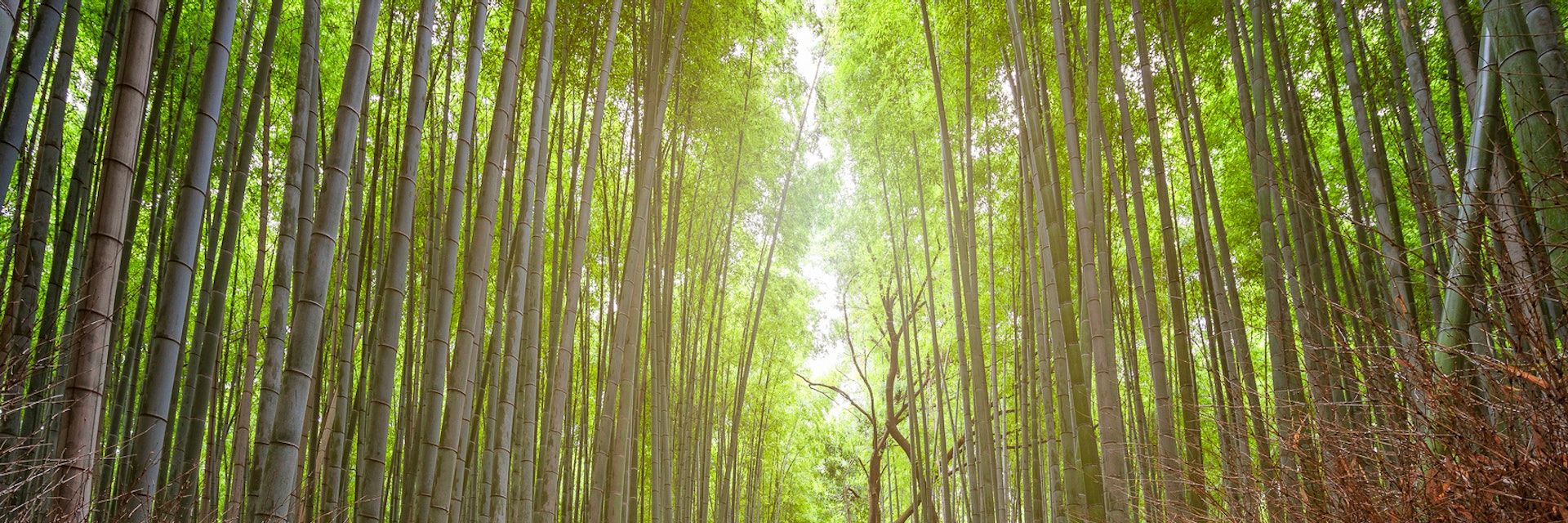
INIGO CIA DA RIVA / Stocksy United

Japan is truly timeless, a place where ancient traditions fuse with modern life, as if it were the most natural thing in the world.
Best Time to Visit
Best places to visit, attractions, must-see attractions.
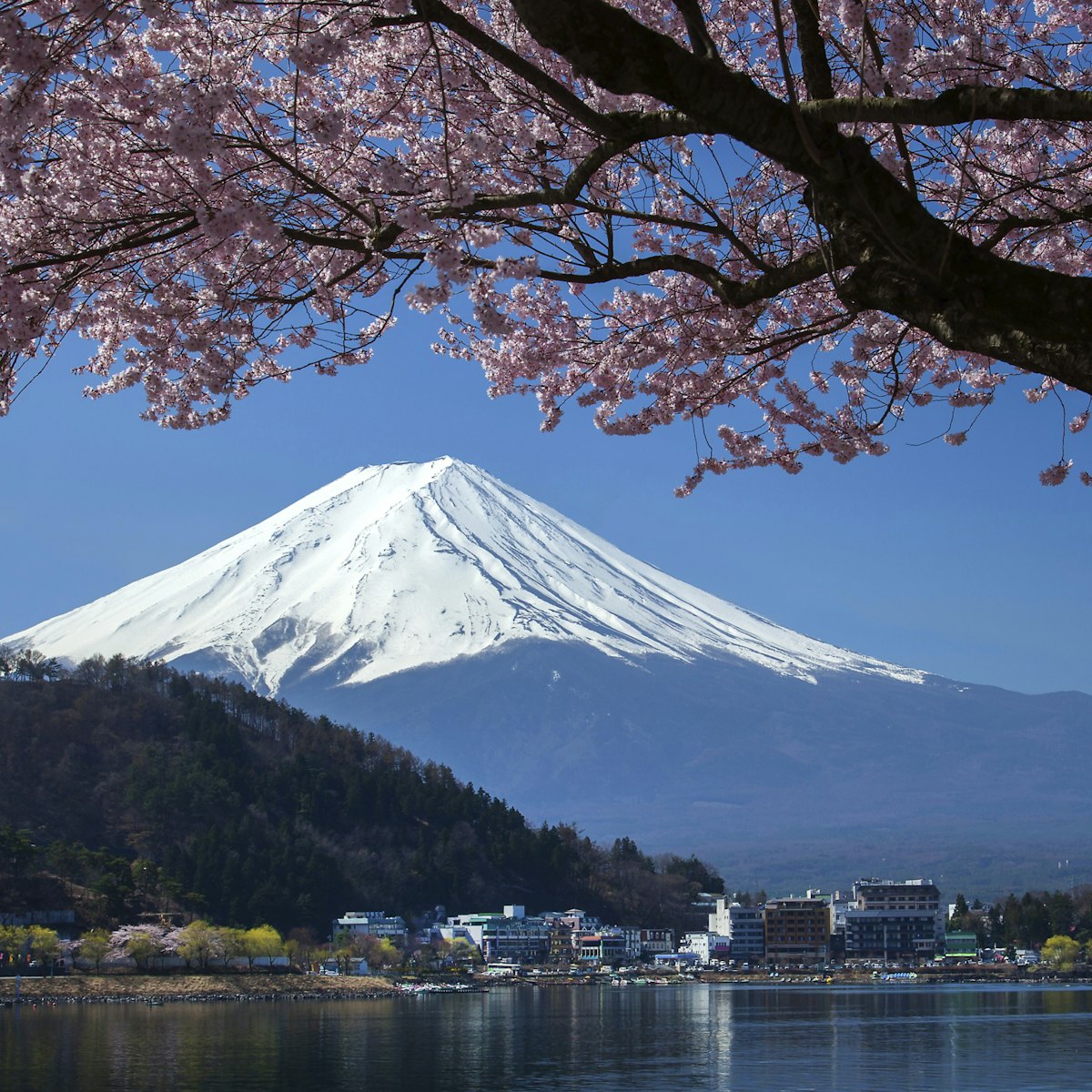
Fuji Five Lakes
Fuji-san is among Japan's most revered and timeless attractions, the inspiration for generations of poets and the focus of countless artworks. Hundreds of…
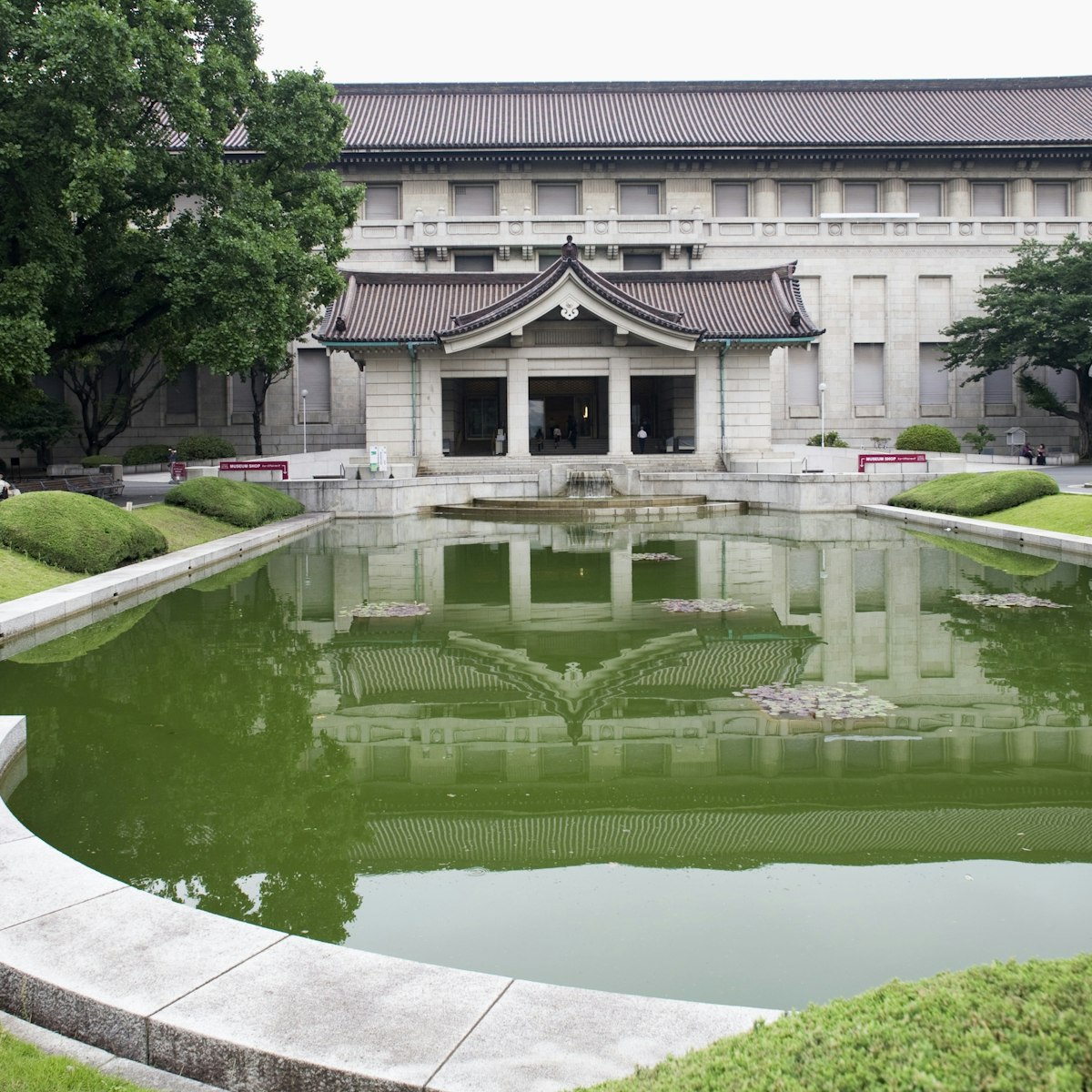
Tokyo National Museum
Ueno & Yanesen
If you visit only one museum in Tokyo, make it the Tokyo National Museum. Here you'll find the world's largest collection of Japanese art, including…
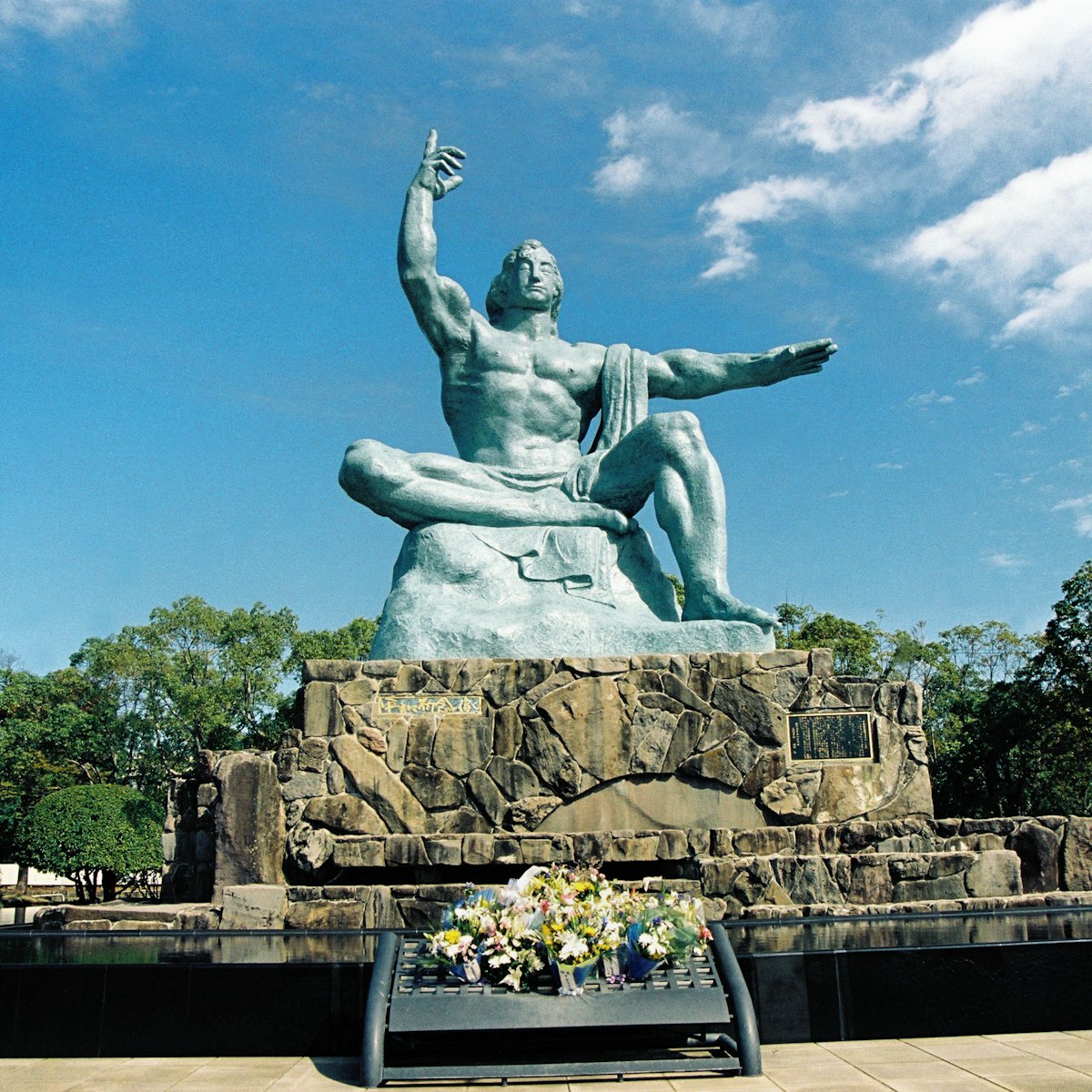
A still, serene and deeply moving place, Nagasaki's Peace Park commemorates the atomic bombing of the city on August 9, 1945, which reduced the…
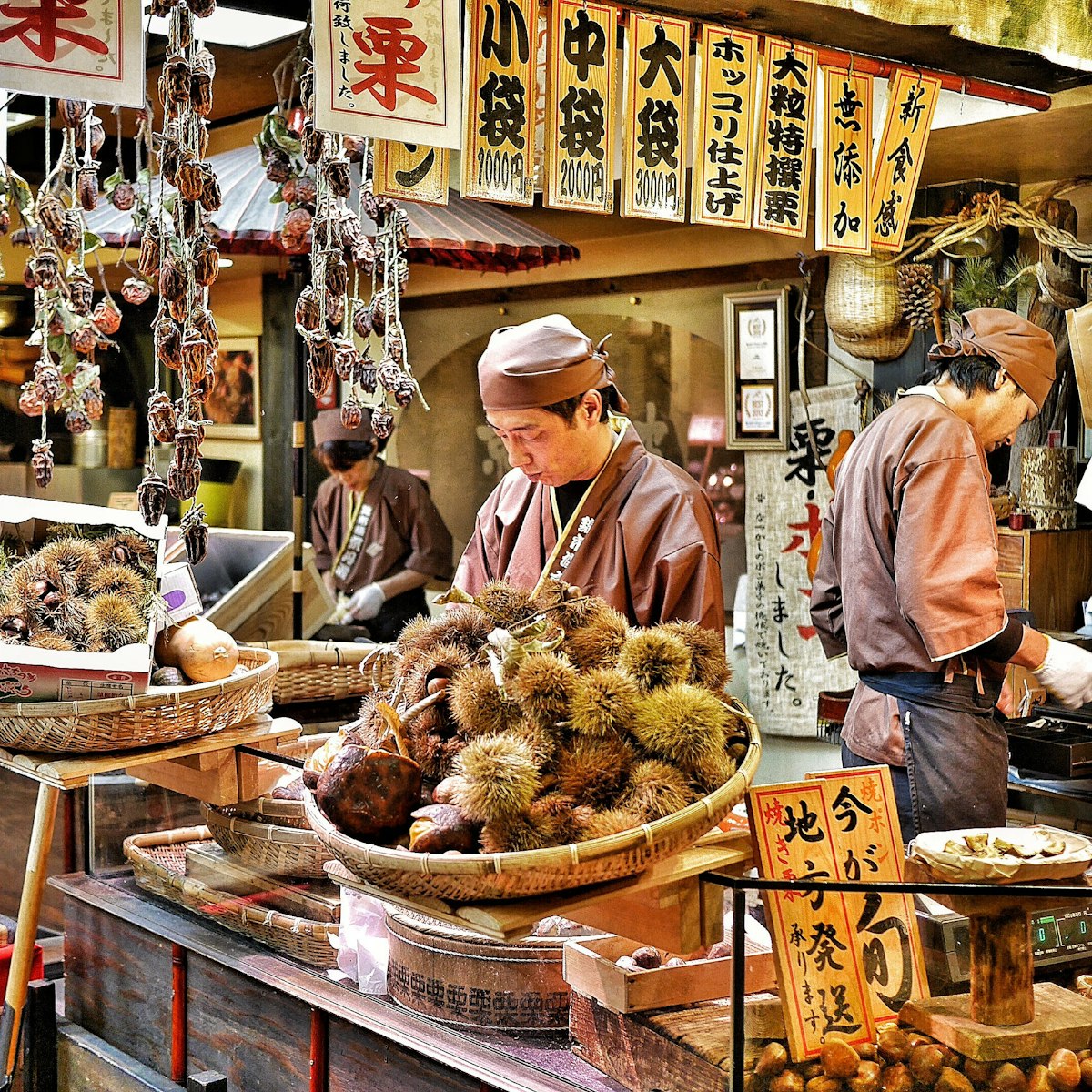
Nishiki Market
Downtown Kyoto
The covered Nishiki Market (Nishiki-kōji Ichiba) is one of Kyoto’s real highlights, especially if you have an interest in cooking and dining. Commonly…
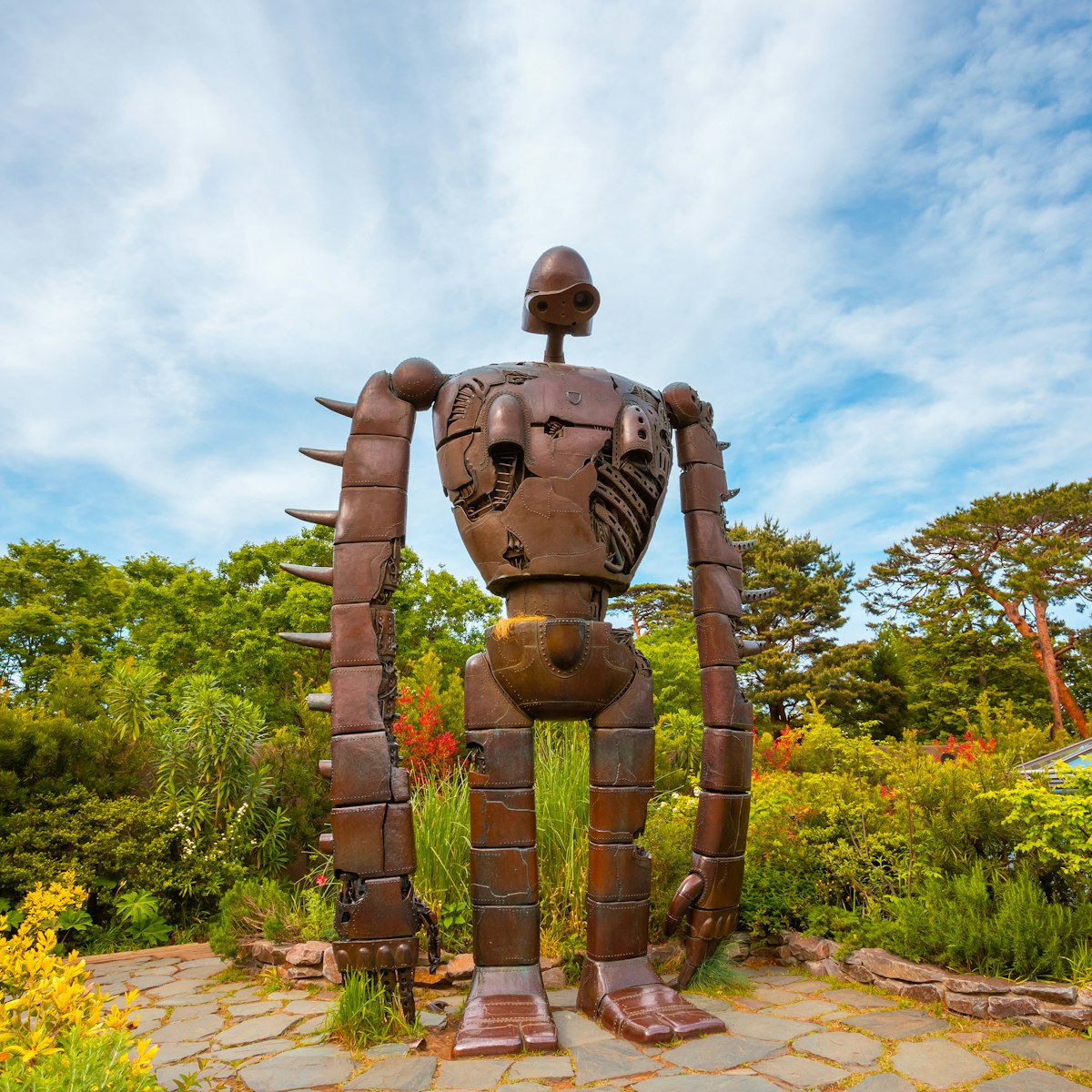
Ghibli Museum
This museum is the heart of the Studio Ghibli world, a beloved (even 'adored') film studio responsible for classic, critically-acclaimed animated titles…
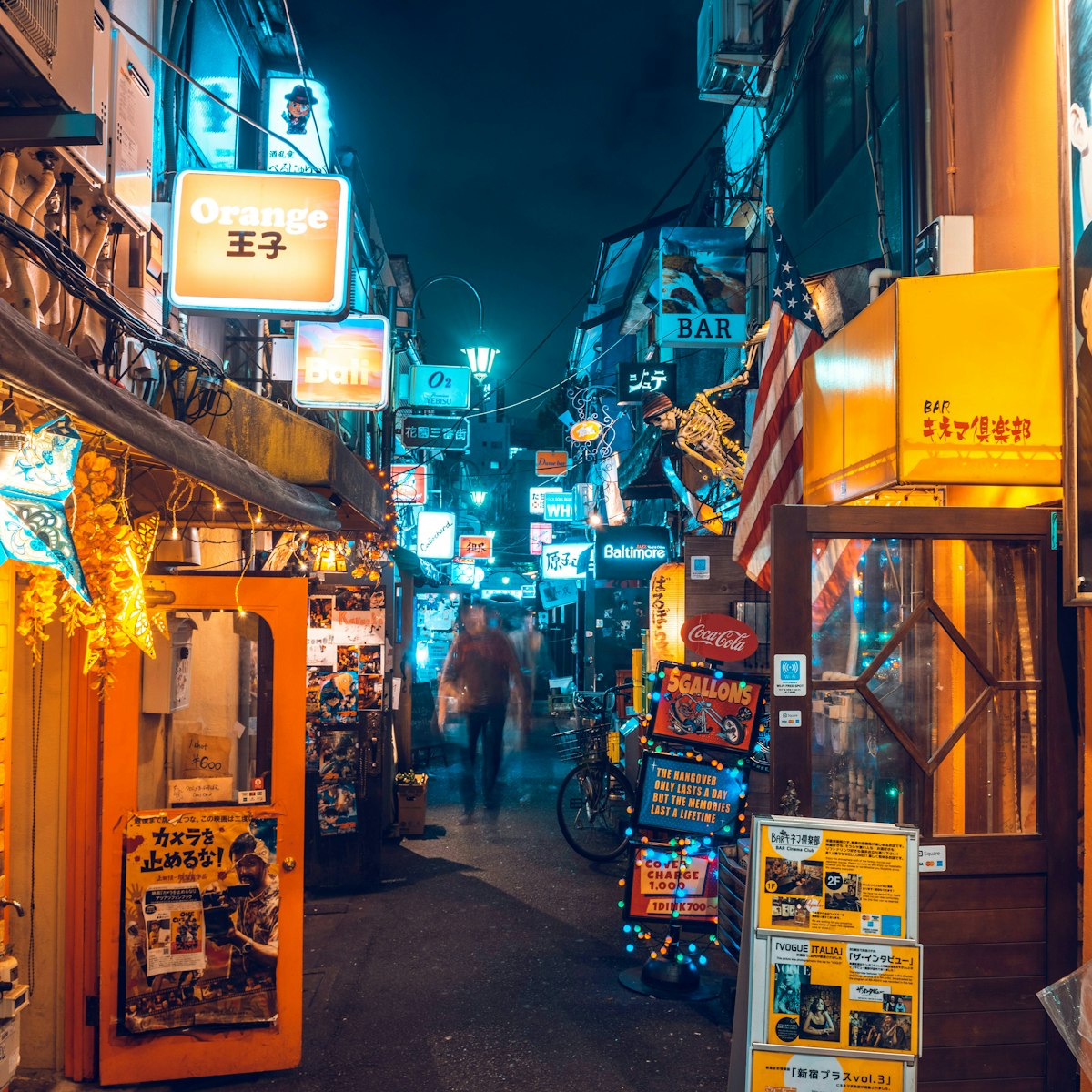
Shinjuku & Northwest Tokyo
Golden Gai – a Shinjuku institution for over half a century – is a collection of tiny bars, often literally no bigger than a closet and seating maybe a…
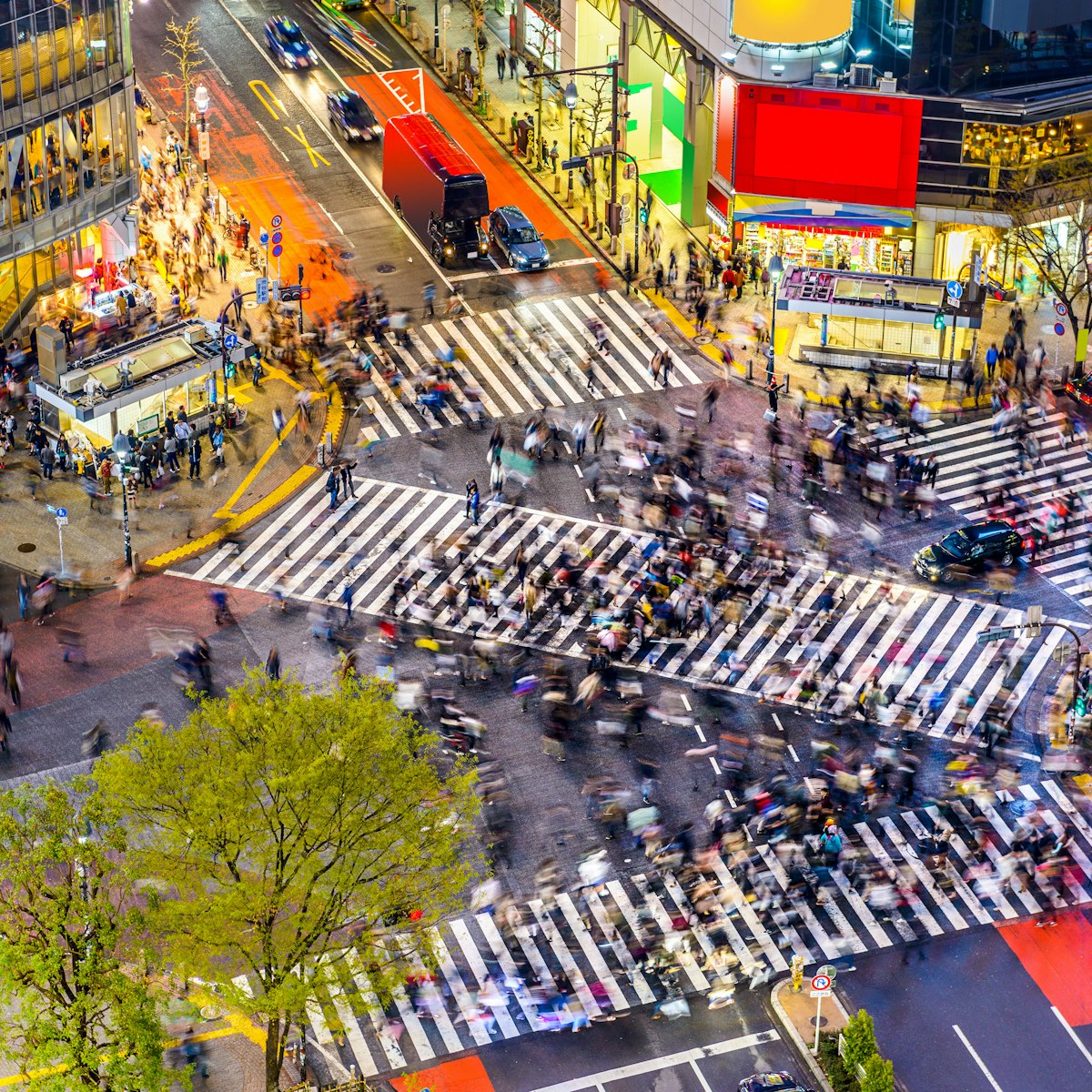
Shibuya Crossing
Shibuya & Shimo-Kitazawa
Rumoured to be the busiest intersection in the world (and definitely in Japan), Shibuya Crossing is like a giant beating heart, sending people in all…

Cup Noodles Museum
This impressively slick attraction is dedicated to, you guessed it, cup noodles. But in reality, its focus is more broad, with numerous exhibitions…
Top picks from our travel experts
24 of the best experiences in japan.
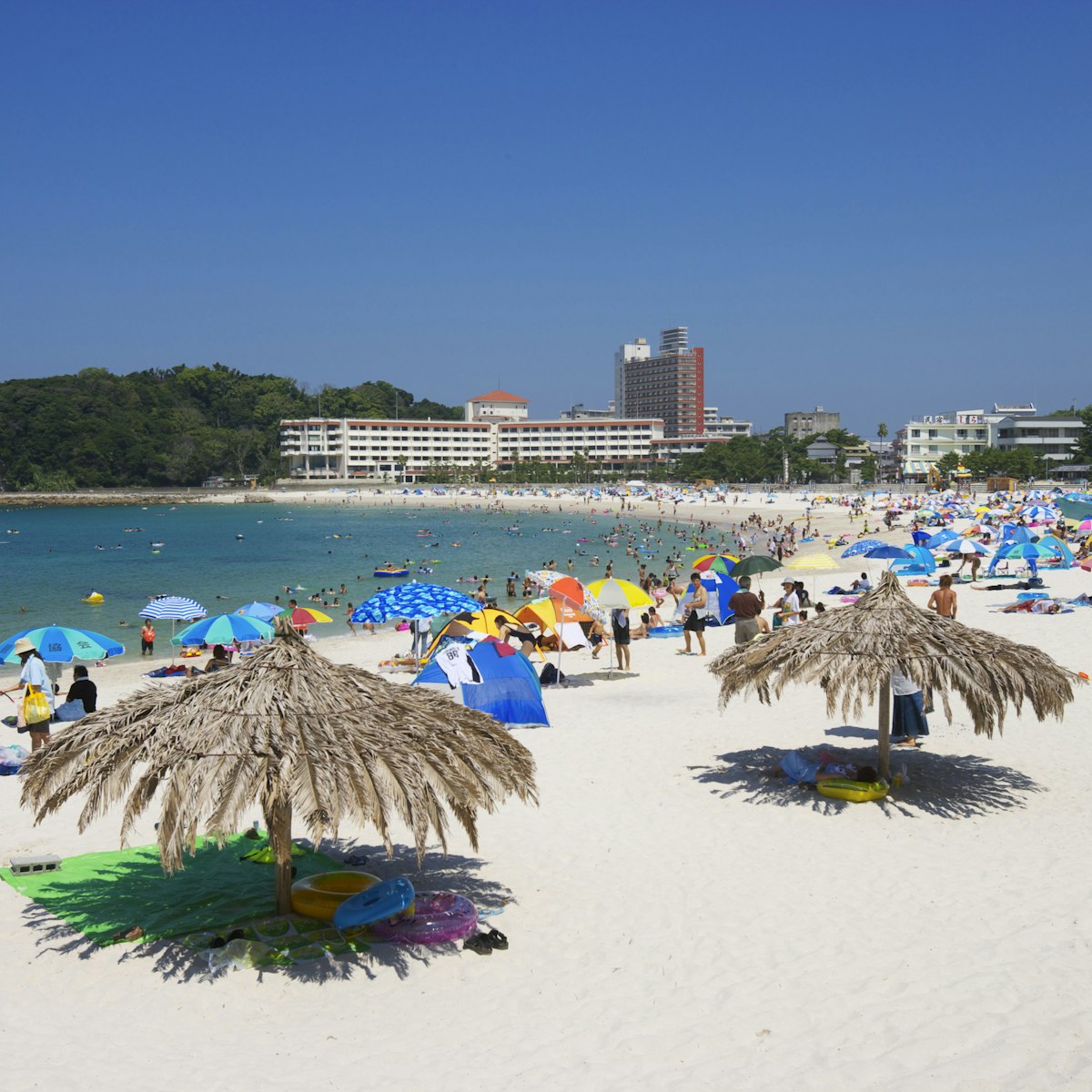
Shirara-hama
Kii Peninsula
Shirahama's main beach is famous for its white sand – though what's there now was imported from Perth in the '90s, as the original sand was lost to…

Southern Higashiyama
Michelin-starred chef Murata serves some of the finest kaiseki in the city. Located in a hidden nook near Maruyama-kōen, this restaurant has everything…

This is one of Tokyo's better kaiten-sushi (conveyor-belt sushi restaurants), with fish sourced daily from the fish market in Numazu (south of Tokyo on…
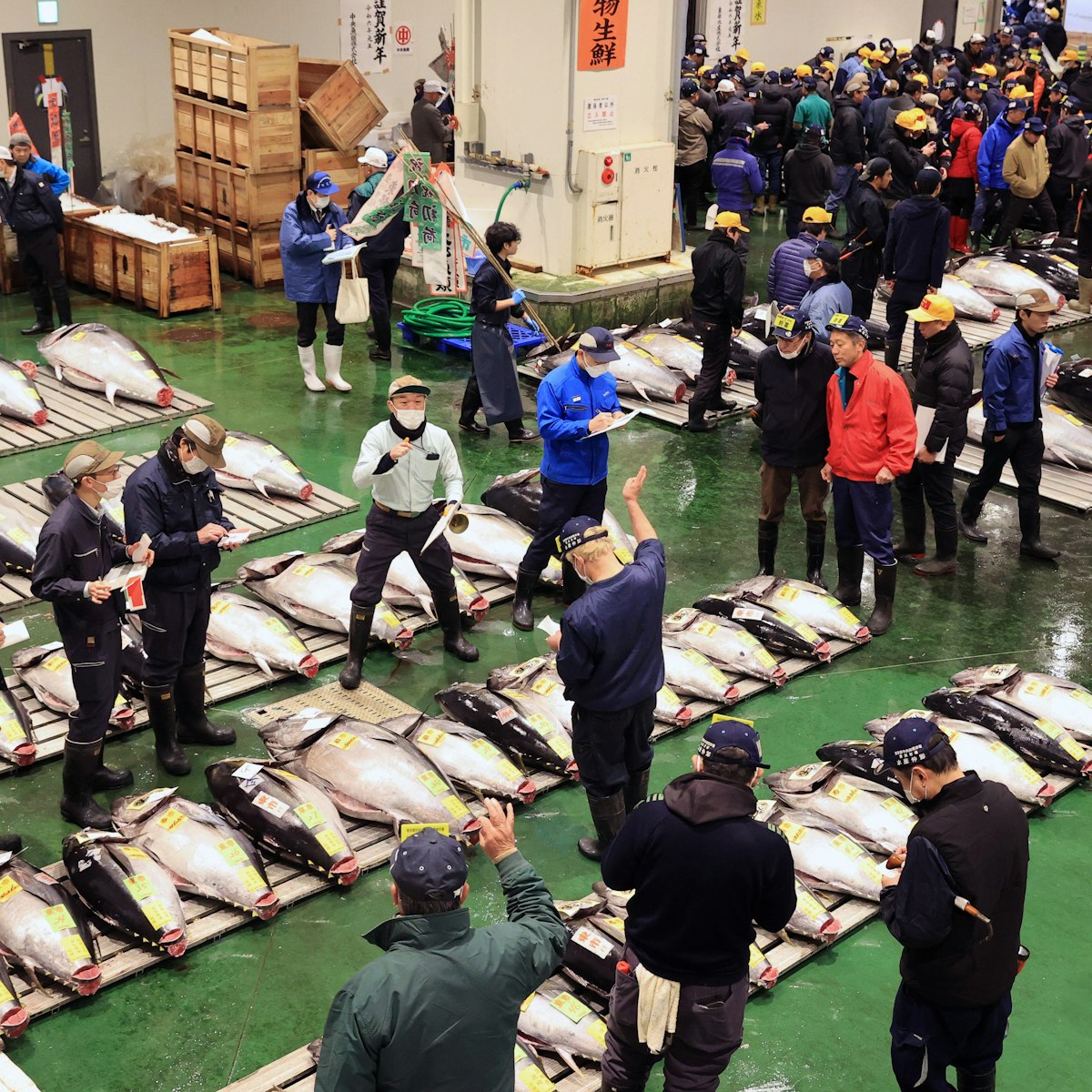
Toyosu Market
Odaiba & Tokyo Bay
In 2018, Tokyo's central wholesale market moved from its iconic Tsukiji location to this new facility in Toyosu, a structure clearly dreamed up by…

Matsuo-jinja
Hiroshima Region
A Shintō shrine dedicated to the god of sake. Sake is brewed here every year in the lead-up to Saijō Sake Matsuri. It's a five-minute walk north of Saijo…
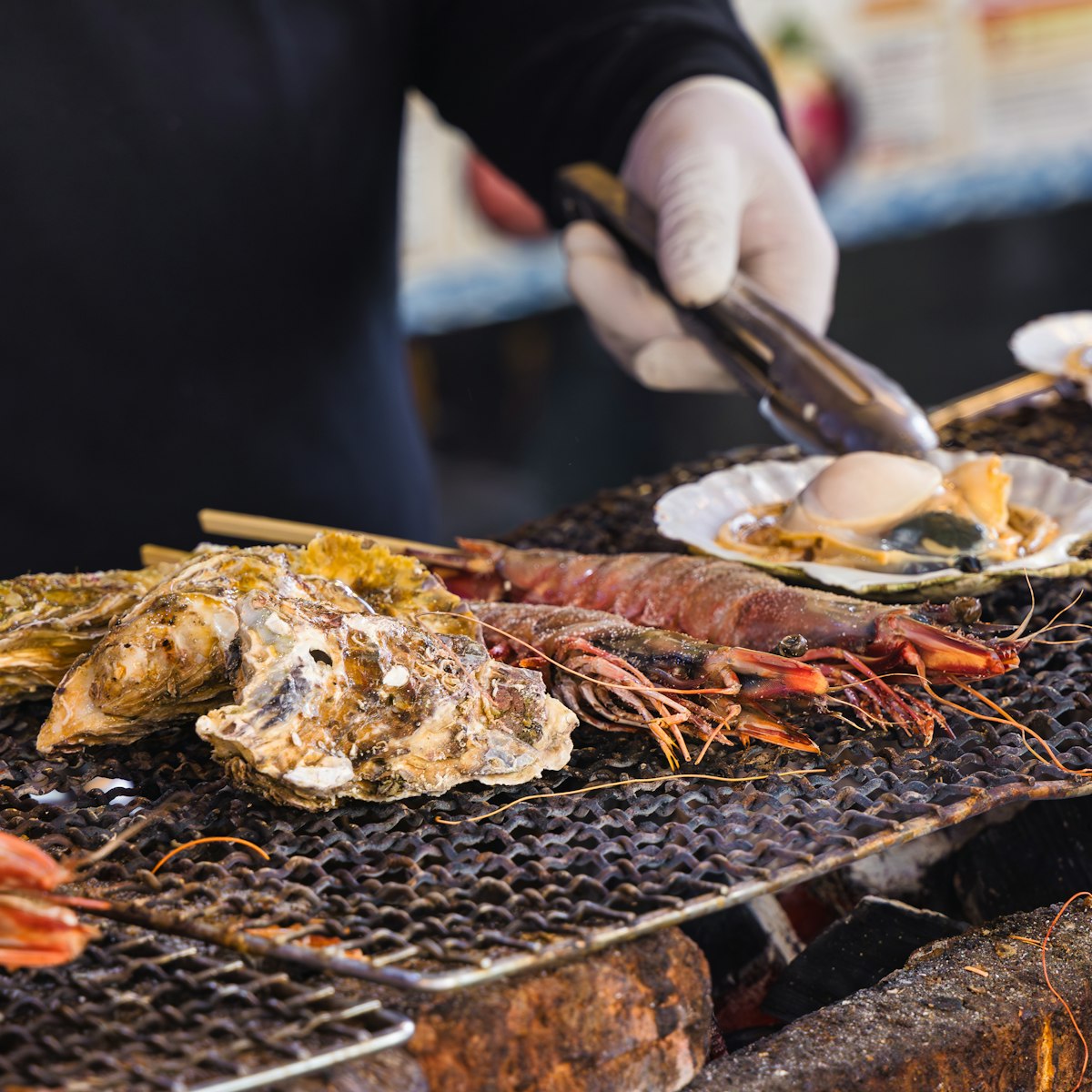
Tsukiji Market
Ginza & Tsukiji
Tokyo's main wholesale market may have moved to Toyosu, but there are many reasons to visit its old home. The tightly packed rows of vendors (which once…

Izumo Taisha
Western Honshū
Izumo Taisha, also known as Izumo Ōyashiro, is perhaps the oldest Shintō shrine in Japan. This shrine, dedicated to Ōkuninushi, god of marriage and…
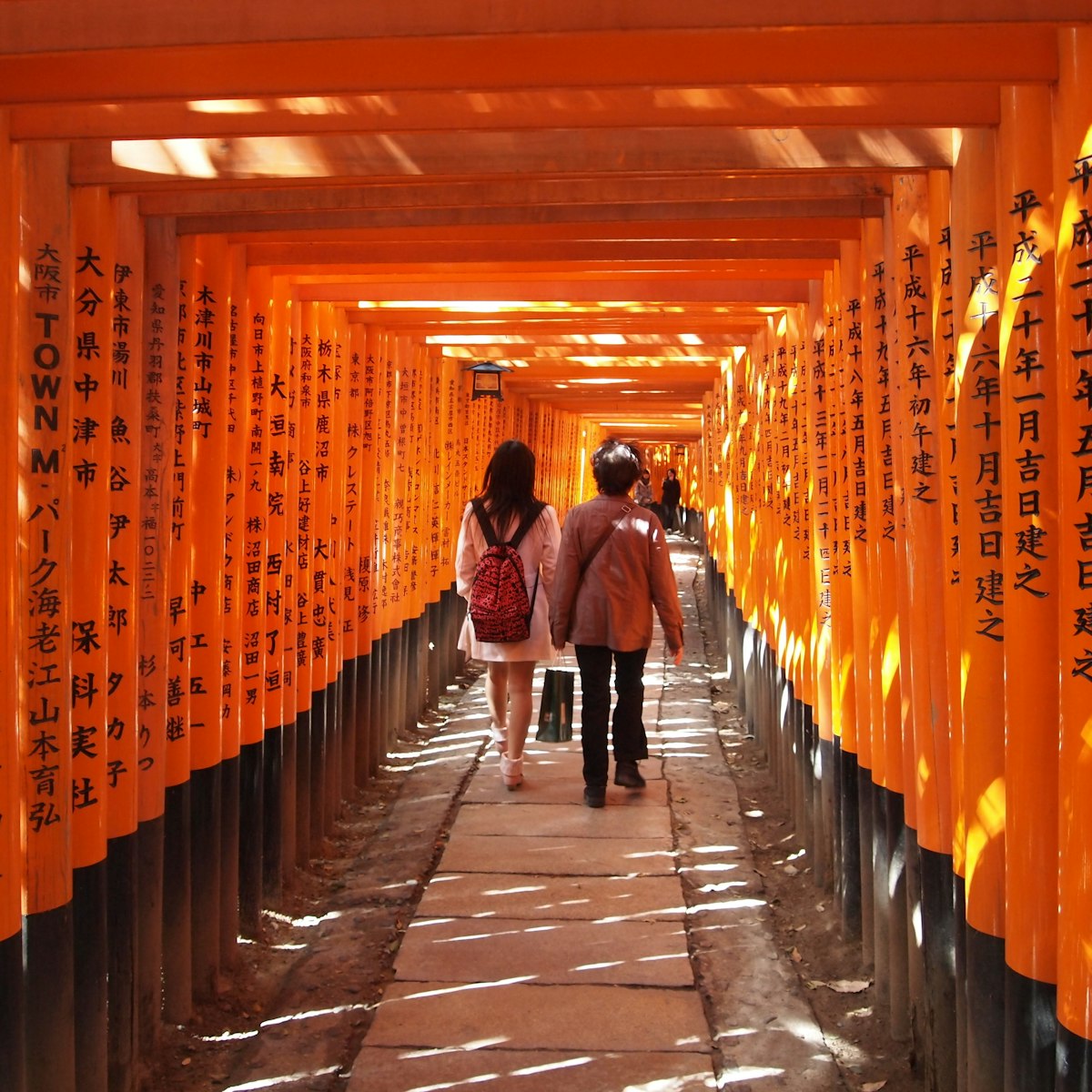
Fushimi Inari-Taisha
Kyoto Station & South Kyoto
With seemingly endless arcades of vermilion torii (shrine gates) spread across a thickly wooded mountain, this vast shrine complex is a world unto its own…

Jigokudani Monkey Park
Nagano Region
Pleasant in winter when shrouded in snow but less appealing when seasonally bare, Jigokudani Monkey Park is wildly popular. Made famous by the 1992 film…

Art House Project
In Honmura, half a dozen traditional buildings have been turned over to contemporary artists to use as the setting for creative installations, often…

Tokyo Character Street
From Doraemon to Hello Kitty and Pikachu, Japan knows kawaii (cute) and how to merchandise it. In the basement on the Yaesu side of Tokyo Station, some 15…
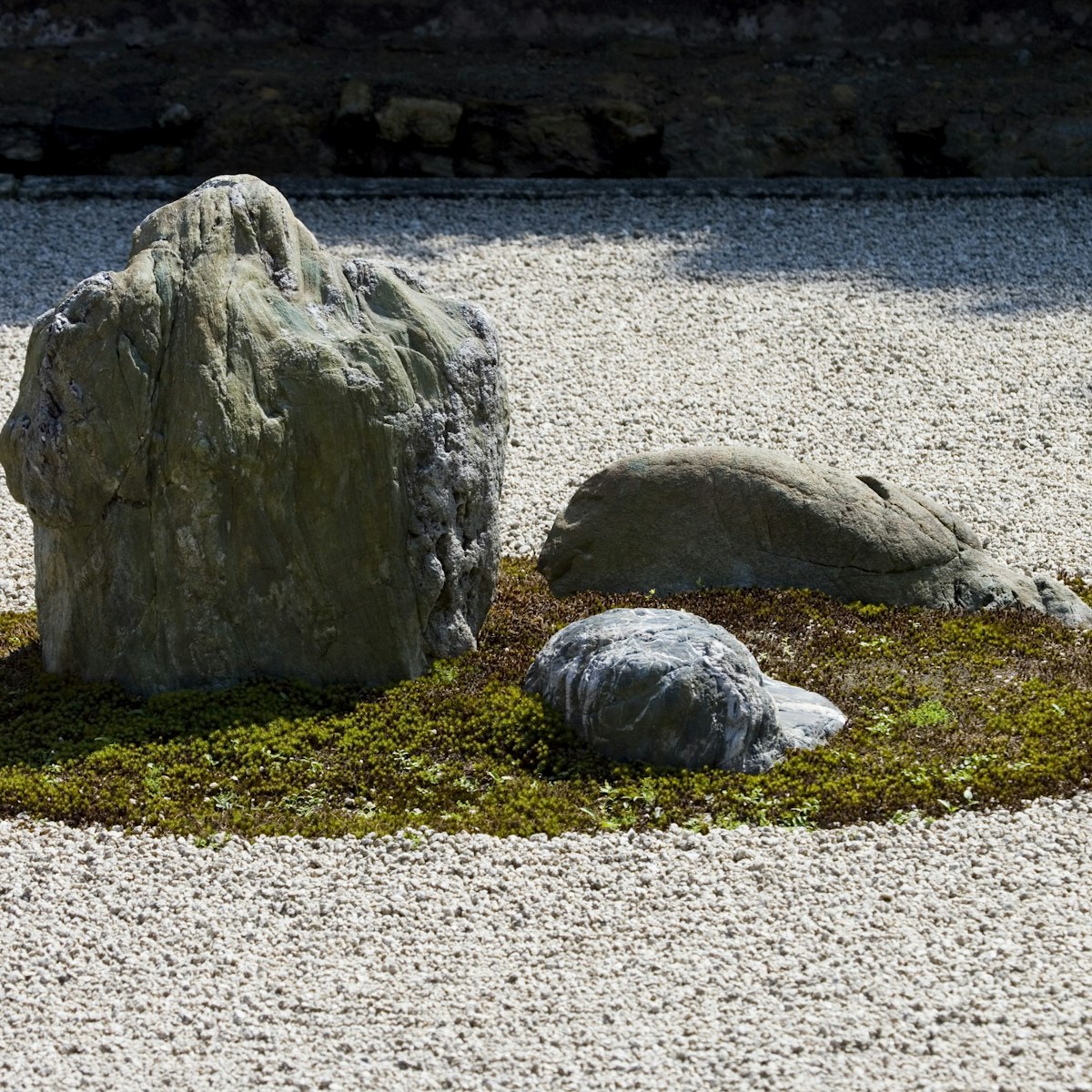
Northwest Kyoto
You’ve probably seen a picture of the rock garden here – it’s one of the symbols of Kyoto and one of Japan’s better-known sights. Ryōan-ji belongs to the…
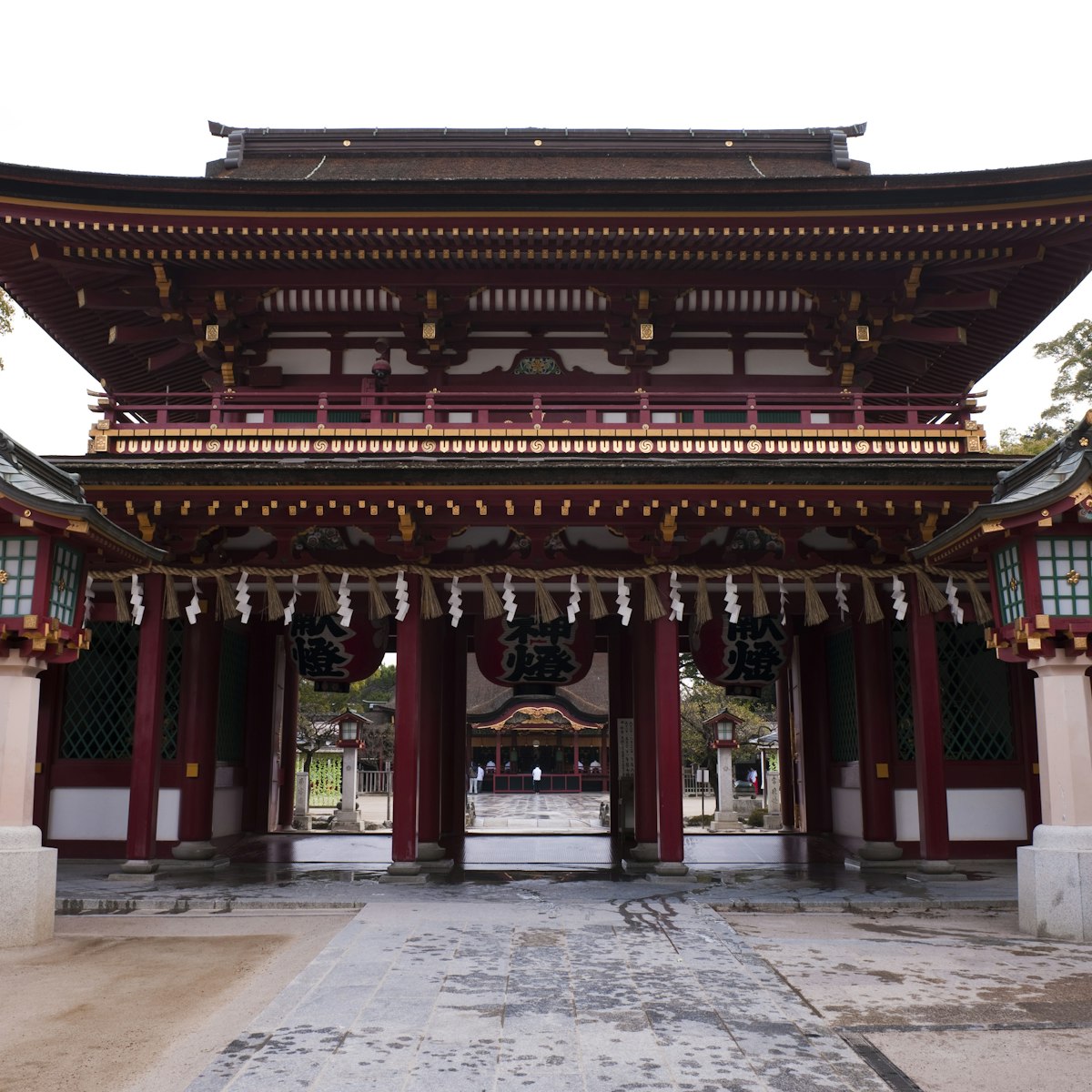
Dazaifu Tenman-gū
Among the countless visitors to the grand, sprawling Tenman-gū – shrine and burial place of poet-scholar Tenman Tenjin – are students making offerings and…
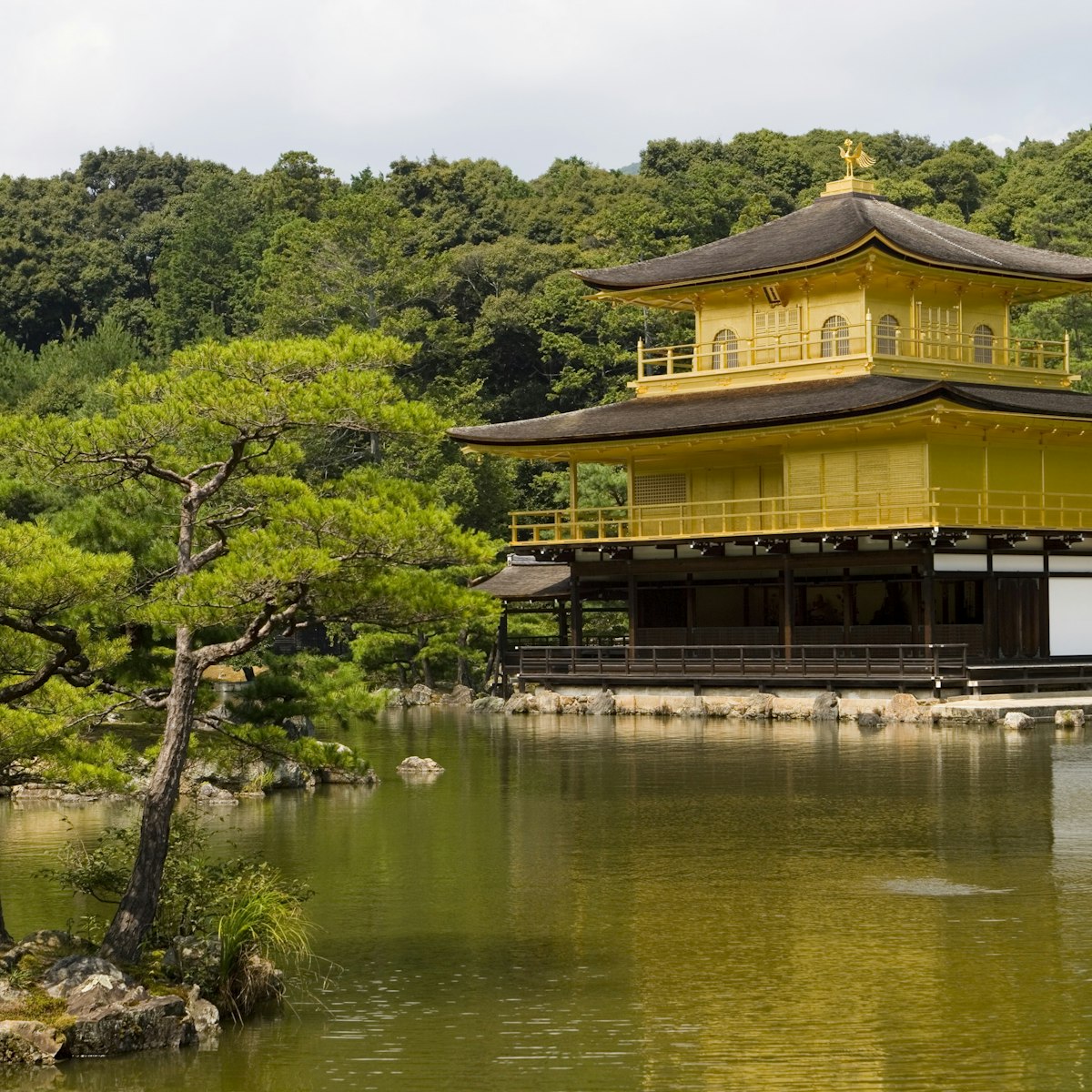
Kyoto's famed 'Golden Pavilion', Kinkaku-ji is one of Japan's best-known sights. The main hall, covered in brilliant gold leaf, shining above its…
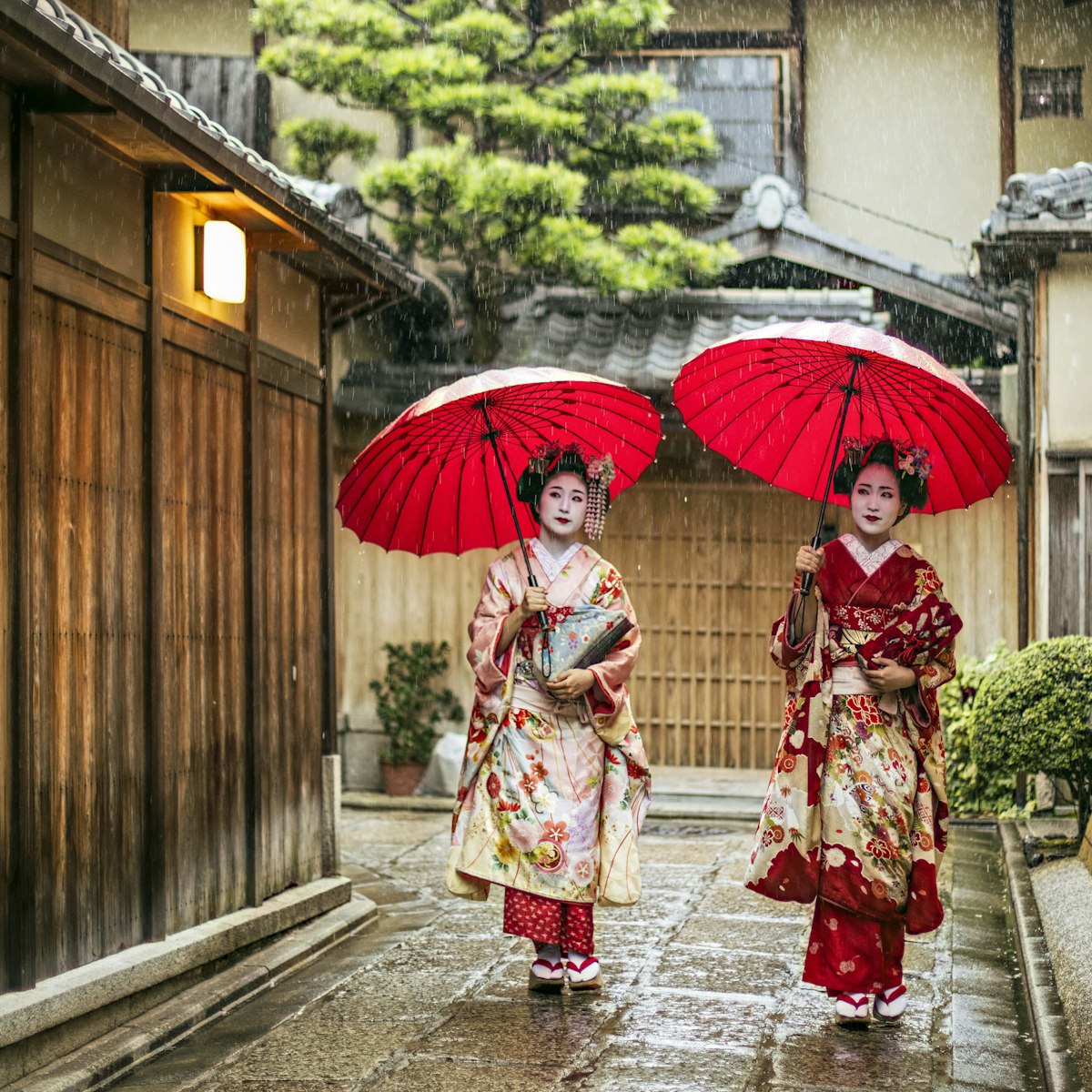
Gion is the famous entertainment and geisha quarter on the eastern bank of the Kamo-gawa. While Gion’s true origins were in teahouses catering to weary…

Hiroshima Peace Memorial Museum
The main building of Hiroshima's premier museum houses a collection of items salvaged from the aftermath of the atomic bomb. The displays are confronting…

A long-time (in club years, at least) club-scene fixture, Womb is a reliable good night out on a Friday or Saturday if you want to lose yourself in the…

Pokémon Cafe
Pokémon fans will find it hard to pass on this chance to sample Pikachu-themed food and drink, made with classic kyara-ben (character bentō) techniques …

Yellow Pumpkin
This yellow pumpkin sculpture, by Japanese artist Yayoi Kusama, has become a symbol of Naoshima. It's perched on the end of a small jetty. Pumpkins are…
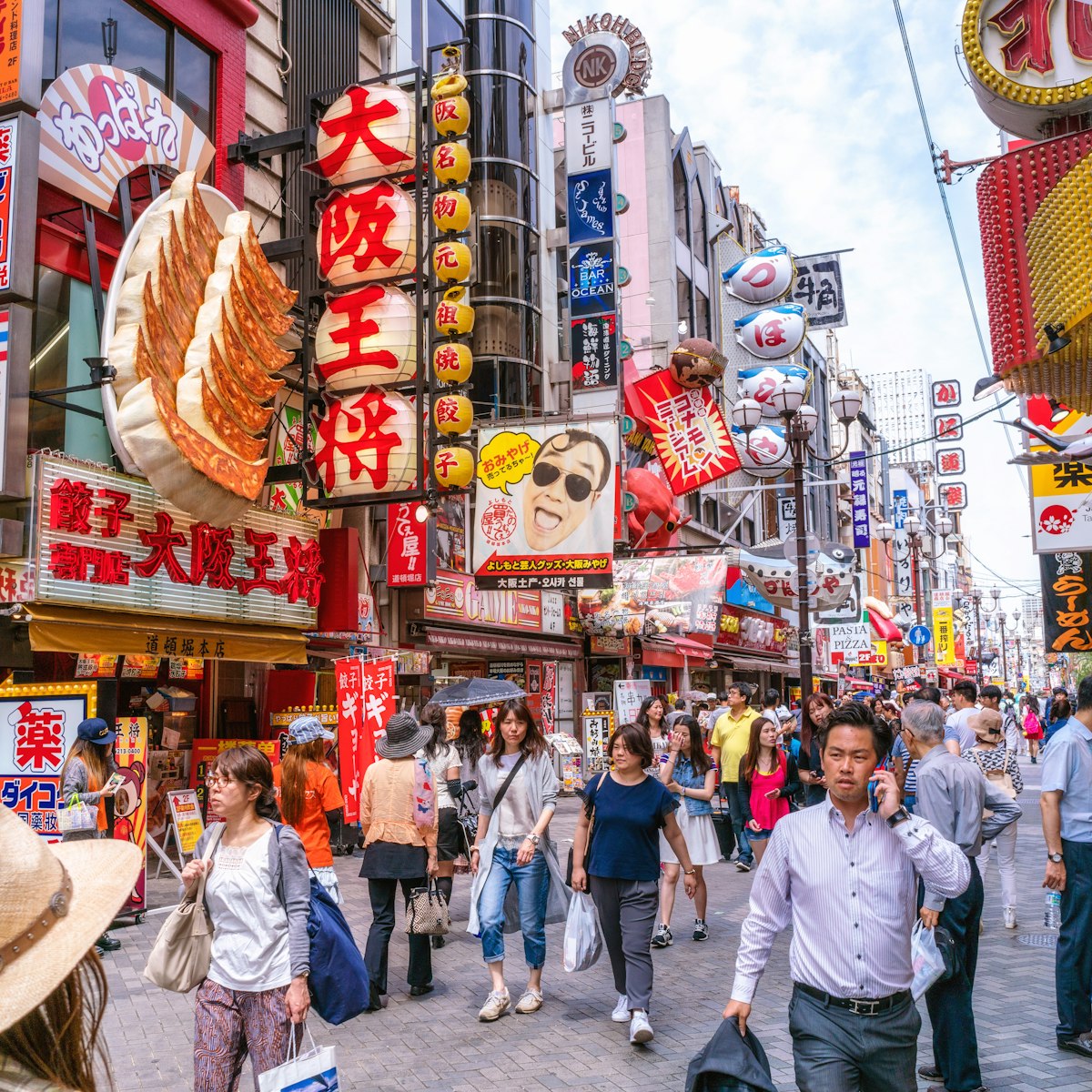
Highly photogenic Dōtombori is the city's liveliest night spot and the centre of the southern part of town. Its name comes from the 400-year-old canal,…

Hirosaki-jō
Aomori Prefecture
At the heart of Hirosaki-kōen lie the ancient remains of this castle, originally constructed in 1611. Rather tragically, only 16 years after it was built…
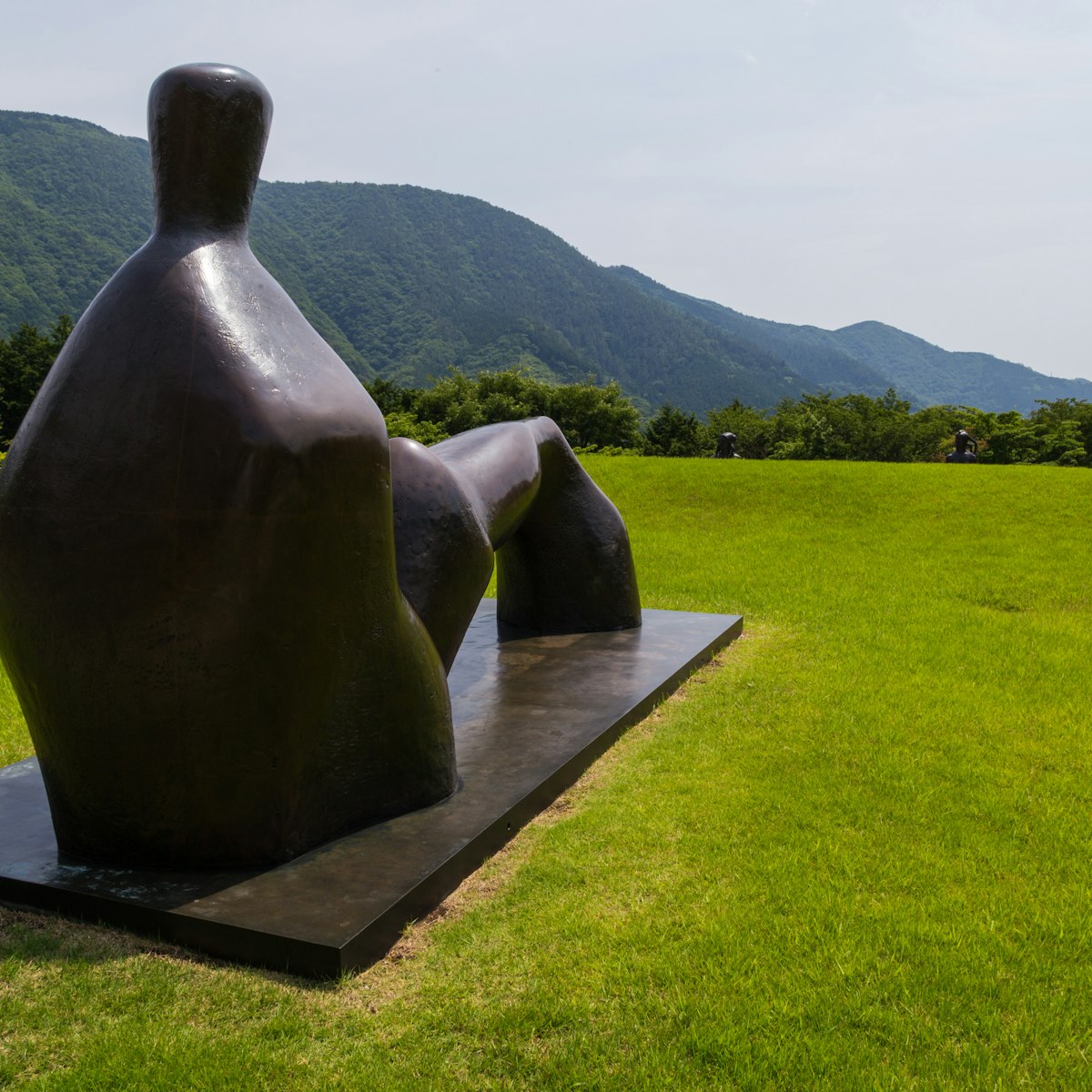
Hakone Open-Air Museum
Occupying a verdant swath of Hakone hillside is this unmissable art safari, leading visitors past a rich array of 19th- and 20th-century sculptures and…
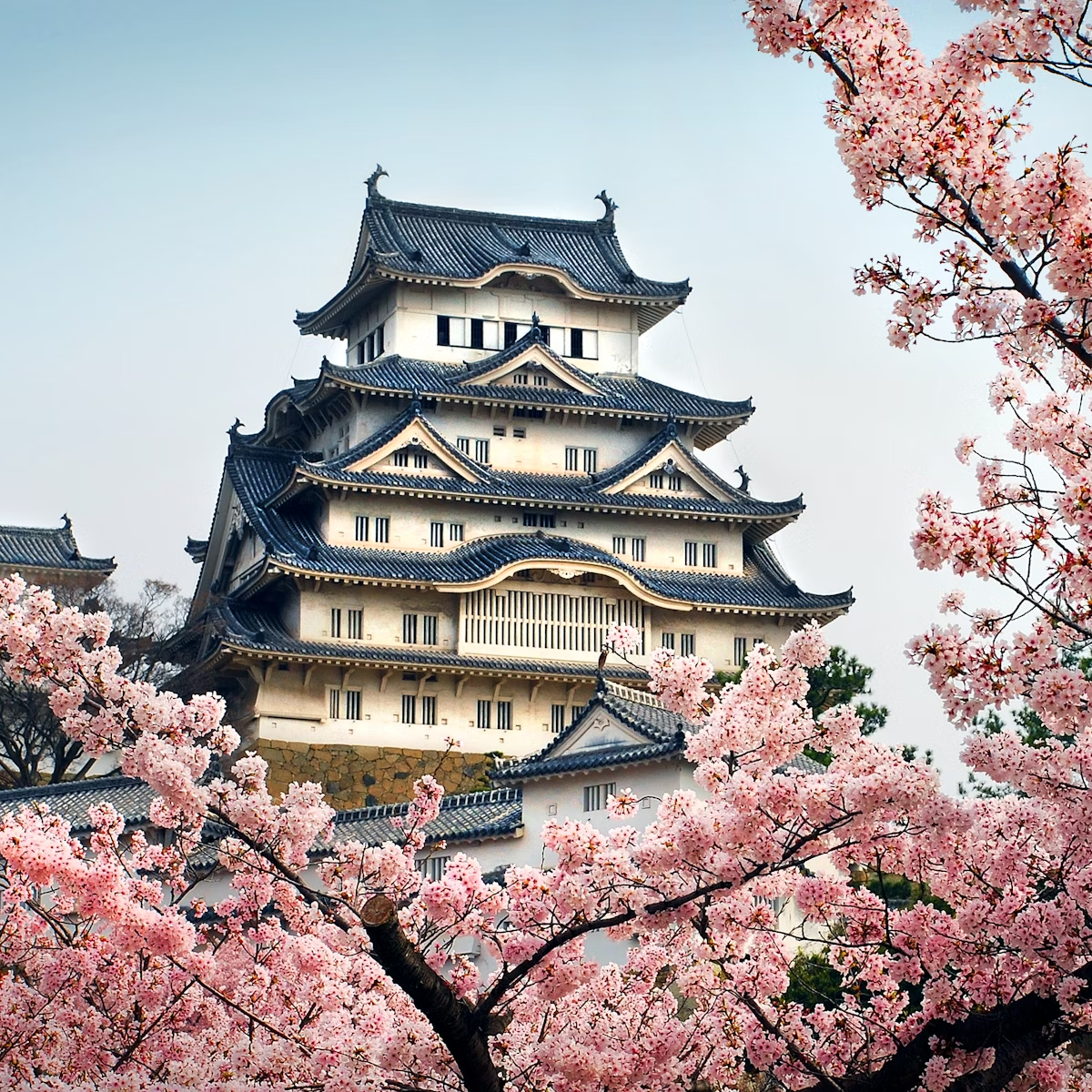
Himeji-jō is Japan's most magnificent castle, built in 1580 by general Toyotomi Hideyoshi and one of only a few original castles from that era (most are…

Karato Ichiba
A highlight of a trip to Shimonoseki is an early-morning visit to the Karato fish market. It's a great opportunity to try sashimi for breakfast or lunch,…

Churei-tō Pagoda
One of the classic Fuji postcard views has this five-tiered red pagoda in the foreground surrounded by cherry blossoms. It's actually a war memorial,…

Taikodani-Inari-jinja
Within walking distance of town, this thriving shrine, built in 1773 by the seventh lord Kamei Norisada, is one of the five major Inari shrines in Japan…
Planning Tools
Expert guidance to help you plan your trip.
Best Things to Do
From classic Japanese food and sights to local favorites and under-the-radar trends, these are 24 of the most inspiring experiences in Japan.
Things to Know
Be ready for a visit to Japan with these tips on health, safety and etiquette.
Transportation
With its myriad islands, towering mountains and megacities, Japan can be a daunting destination to get around. We've got everything you need to know.
Visa Requirements
From mystic mountains to mighty megacities, Japan is awash with iconic travel experiences. Here's what you need to know about visa requirements.
Money and Costs
Keep costs low when exploring Japan with these top money-saving tips.
Traveling with Kids
No matter where you go in Japan, you’ll find it’s an easy, fun and safe place to travel with kids.
Best Road Trips
Japan has excellent roads, dramatic landscapes and exciting regions to discover. Here are the best 10 road trips for getting to know the country better.
Plan with a local
Experience the real Japan
Let a local expert craft your dream trip.

Latest stories from Japan
Filter by interest:
- All Interests
- Adventure Travel
- Art & Culture
- Beaches, Coasts & Islands
- Food & Drink
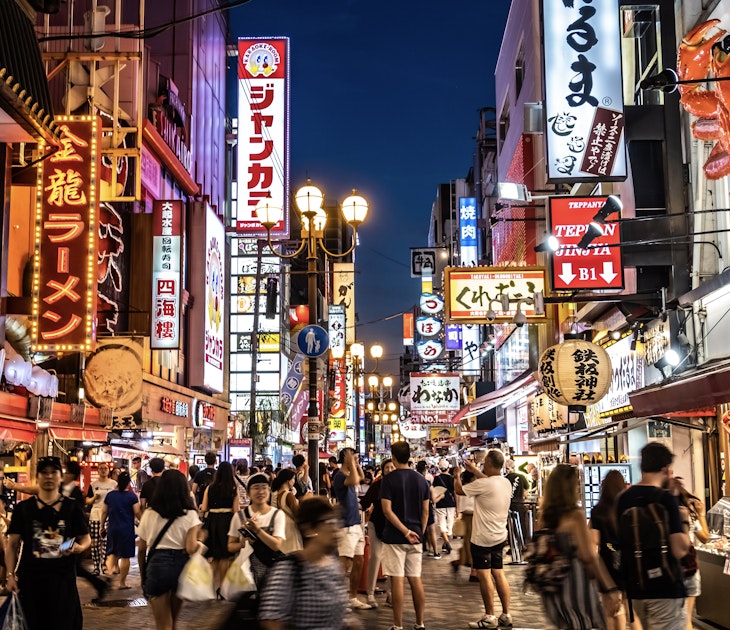
Art and Culture
May 1, 2024 • 9 min read
This four-day Osaka and Kyoto itinerary is a perfect add-on to any trip to Japan.
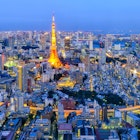
Apr 26, 2024 • 12 min read

Apr 2, 2024 • 10 min read

Mar 31, 2024 • 7 min read

Mar 28, 2024 • 7 min read

Mar 28, 2024 • 6 min read

Mar 28, 2024 • 11 min read

Mar 27, 2024 • 5 min read

Mar 26, 2024 • 8 min read
in partnership with getyourguide
Book popular activities in Japan
Purchase our award-winning guidebooks.
Get to the heart of Japan with one of our in-depth, award-winning guidebooks, covering maps, itineraries, and expert guidance.
Japan and beyond
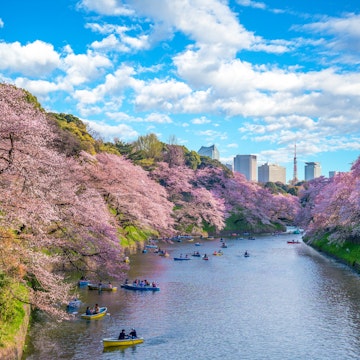
Japan Travel Guide
Last updated on May 18, 2024 by Shannon
Japan is a fascinating place. It’s a country thriving on contradictions. Japan’s gorgeous ancient history is present, and it lives alongside space-age technology and development. This is a thoroughly modern country that looks nothing like the West.
The Japanese have cultivated a strong national identity that is only enhanced by modern technology. From robots at restaurants to cat cafes to towering temples—it’s an assault to the senses.
It’s a wonderful destination for all types of travelers—it has pilgrimage routes, Mount Fuji, whale watching, ancient temples, and a booming food tourism industry. The country also has an advanced transportation infrastructure that makes navigating a cinch. I visited for the first time in 2015.

After seven years of travel, I stood under Tokyo’s towering skyline and felt a wave of culture shock wash over me. It’s not like any place you’ve visited before.
And while I heartily recommend visiting Japan, there are some ethical tourism concerns, so be sure to check the responsible travel section .
Continue reading for a guide to things you should know before you go, and tips about navigating Japan. Or skip straight to the Japan travel guides by city!
Table of Contents
Is it Safe to Travel in Japan?
Japan is incredibly safe. Crazy safe. The culture runs to a rigid set of rules and citizens adhere to these cultural norms. Very young children ride the subways alone . Scams are rare, if not nonexistent. Though crowded, pickpocketing and petty crimes just don’t happen outside of, perhaps, the airport area.
Anything that befalls you will be accidental. There are some reports of a skeezy behavior from men on the trains, but it’s rare. Even with Japan’s safety record, however, insurance is about more than destination safety. I am a firm advocate of securing travel insurance like IMG Global for every trip; read my key tips to pick a good travel insurance .
Possible Issues
You’re pretty safe in Japan, so really the language barrier is your biggest issue, and a few quicks specific to traveling in Japan.
Things like your Japan Rail pass , discount flights, and that sort of thing are only available for booking outside of Japan. To get these discounts you have to plan ahead. English language signs are also not very extensive in Tokyo, though that changed some in preparation for the 2021 Summer Olympics.
In the years leading up to the Olympics, the country overhauled train stations for a more tourist-friendly travel experience. Even so, plan on using translation apps, have a good map, and stay patient. I found locals incredibly willing to help me, even when that involved a lot of pantomimes.
Younger Japanese (college age and teens) are the most likely to speak some English, and will understand written English.
Fast Facts About Japan Travel
Japanese Yen (JPY) ( current exchange rate )
Electricity
100V/50-60Hz (North American plug; usually two prong, without the ground. Often has both flat pins the same size. This is my favorite travel adapter .)
Japan’s Primary International Airports
- Tokyo’s Narita Airport (NRT)
- Tokyo’s Haneda Airport (HND)
- Osaka’s Kansai Airport (KIX)
Can you Drink the Water in Japan?
Yes, you can drink the water in Japan. It’s safe. Bring a water bottle and fill from the tap as you travel.
How’s the Wifi in Japan?
Japan has excellent internet; it’s among the fastest in the world. No matter where you travel, you can essentially count on easy internet access. Many guesthouses offer wifi for free, and you’ll find free wifi in many public spaces as well.
How to Buy a SIM Card in Japan
I highly recommend you secure a SIM card once you land. Although it’s not cheap, it is handy. Outside of the touristy areas, English signage and penetration is very low.
Having a phone with data will allow you to easily navigate the trains, check routes, and translate on the fly. This piece is a great overview of securing a SIM card , which is now available before you even land in Japan. Since you’re likely sending yourself your Japan Rail pass (buy this before you leave!), you might as well be totally prepared and send yourself this, too.
If you want to buy it locally, it’s harder but doable, start your research here . You will need your passport.
Although you can sometimes secure a SIM at the airport, if you arrive late the process is a little more complicated. I seem to live for complicated, so I had to hunt down a SIM card. I bought mine at the Bic Camera store in Shibuya . They had me sorted with data in about 25 minutes, although I admit the first 10 minutes were a confusing game of pantomime.
Japanese Festivals of Note
- Hanami, or rather Cherry Blossom season is a popular time to visit (end of March through early April)
- Sapporo Snow Festival (February)
- Fuji Rock Festival (July)
- Tokushima’s Awa Odori Festival (August)
- Golden Week (April 29 – May 5—it’s nearly impossible to find accommodation during this week.)
Best Time to Visit Japan
Spring is busy with the cherry blossom season (end of March through early April).
Autumn is beautiful, the manicured gardens riot with color.
Summer is quite hot, and Japan is a popular ski spot in the winter. Fuji’s climbing season is only open in July and August, with the shoulder months possible but not popular.
Food Considerations
Japan is tricky as a vegetarian. The concept is not widely understood. I struggled to communicate the nuances (like no fish broth). You will need good translations and research ahead of time to suss out what you can eat.
Happy Cow has great vegetarian restaurant recommendations for cities across Japan; this lists the dishes you can eat , and this shares good translations at the end . This is a good general food primer guide for non-vegetarians.
If you’re celiac, then this is a thorough gluten-free guide . For all types of eaters, the convenience stores and 7-11s have fresh snacks and are very popular among locals and travelers alike.
Pick out accommodation on Booking.com.
This is the only booking platform I use because it rewards you for loyalty, and I regularly score free breakfasts and 15% off my hotel.
Accommodation in Japan
Accommodation is one of the most expensive parts of traveling in Japan. There are no truly budget options. The upside is that even the hostels are impeccably clean.
Ryokans (and their budget versions, called, minshuku ) are traditional Japanese guesthouses and are the best spot to learn about the cultural traditions related to food and hospitality. Plan at least a couple of nights in one of these.
Japan also has the quirky capsule, or pod, hotels where you essentially sleep in a high-tech cupboard. If you’re visiting during Cherry Blossom season you need to book many months in advance.
Find good budget and mid-range options on Booking.com and use Booking.com or Hostel w orld to find affordable hostels.
Using VRBO could also save money since you’d have a full apartment to make breakfast at least. If none of these will do, check out my detailed guide to finding good places to stay .
Visas for Japan
Citizens of North America, UK, and Europe do not need a visa to enter for 90 days.
Longer extensions are available for some of these countries, and most outside of these regions will need to apply ahead of time. Full visa requirements here .
How to Get Around Japan
When arriving in Japan, you’ll likely want to fly into Haneda over Narita if possible. Nearly all travelers will want to buy a Japan Rail Pass if they plan to leave Tokyo. As of 2021, you can technically buy a pass in country, but it costs more.
The old rules were that you must buy one before you enter the country since it’s a tourist pass. They are super sketchy on how long they plan to offer in-country purchasing, so just buy one online before you leave and they’ll send your pass within several days to your home.
The pass offers a steep discount on train travel in the country and is almost always a good deal if you plan to leave Tokyo on trips to at least two other areas of the country. Japan has an extensive and effective rail network and it’s how you will get between cities.
Also download the Hyperdia app before you leave and use it to find the best train routes throughout the country—this app is detailed and highly accurate. In addition to your JR Pass , you’ll want to buy a Suica card from a vending machine or ticket agent. You preload this card with money to easily to pay for local rail/subway lines, and it also works at the vending machines.
When in doubt, use a ticket agent to book travel as they can usually find someone behind the counter who knows a bit of English.
How Much Does Japan Travel Cost?
Japan is expensive. It’s impossible to travel Japan on an extreme budget, but it is possible to travel and save costs. I met one guy camping out on the beaches and biking the country—he was saving money.
But in general, do your budget research so you are comfortable spending a bit of money to enjoy the sights and food. You can save food costs by grabbing snacks at the convenience stores (tons of 7-11s), but you’ll likely want to sample all the delicious soups, sushi, and foods of Japan.
Even the shared-bed hostels are moderately priced and will set you back $20-35 USD per night. Plan on a budget trip at about $70 USD per person. Budgets can escalate quickly from there. This is a great 2016 couples budget . Matt shares budget tips here too.
History to Know Before Traveling to Japan
Japan’s centuries of isolationist tendencies created a cultural time capsule. The limited outside influence allowed traditions and craftsmanship to flourish for centuries; everything from Kabuki to silk to traditional ryokan inns. Recent history then built on that history for a thoroughly modern, fascinating mix.
Japan has a rich, complex, and varied history. It’s these very complexities that have created such a fascinating culture today. Japan has spent centuries vacillating between isolationist tendencies and rapid outward expansion. Though it’s a moderately sized country, it has the 10th highest population in the world—most of that is densely packed into urban centers.
Even more remarkable is that much of Japanese land isn’t inhabited. The terrain is forested mountains and volcanoes. The country is very, very homogeneous—98.5% of the country is ethnically Japanese. Shintoism, the predominate religion dates back to 1,000 B.C.E., and is often practiced alongside Buddhism.
Japan’s ancient civilizations date back to prehistoric times; spanning from then on, the country’s history includes clan feuds, shifts in power, and slow growth. In 1192, the Shogun, or era of military rulers, began. This period lasted many centuries (700 years). It’s during this era that Japan’s military prowess was born, including the samurai and the country’s famous martial arts.

The Edo period started in the 1600s and didn’t end until 1853, when the U.S. led efforts encouraging Japan to open trade routes with the rest of the world. During the centuries of Shogun rule, the leaders maintained a strong focus on the caste system, which encouraged an isolationist view toward ruling—limiting outside influence on its citizens.
It’s this limited influence that created such a strong history of craftsmanship and traditions, from Kabuki to silk to traditional ryokan inns.
From the mid-1800s until WWII, Japan had regional, smaller wars with Russia, Korea, Taiwan, and China. Then, the bombing of Pearl Harbor in 1941 marked Japan’s entry into WWII. The U.S. retaliated with the devastating atomic bombings of Hiroshima and Nagasaki—an act that changed history as we know it, as well as led to Japan’s surrender.
In the decades after the war, Japan focused on peace and economic growth. In the wake of WWII, Japan joined the United Nations and has continued to prosper economically. Growth slowed in the 90s, but continues.
The tsunami and Fukushima nuclear disaster in 2011 were devastating for the country. But tourism remains a in full force and Japan continues to rebuild areas affected by the tsunami.
World Travel Planning Resources
From the best travel gear to how to pick travel insurance—a detailed list of resources, tips, and advice to help you plan an amazing trip.
Pre-Trip Reading Inspiration: Books About Japan
Fiction & Nonfiction Books About Japan
- Shogun : This is an epic, sweeping saga of Japan. It weaves narrative, history, love, and adventure into one book. It’s also a page-by-page unfolding of the intricacies of Japanese culture that are best understood when shown through imaginative characters and an intriguing storyline.
- Memoirs of a Geisha : An easy read that is beautifully written. This novel is a fictional but informative look at Japan’s Geisha culture. The movie is also wonderful and will whet your appetite for what you’ll see when you visit Kyoto.
- The Wind-Up Bird Chronicle : Written by Japanese author Haruki Murakami, it’s an acclaimed novel detailing a post-WWII Tokyo with a fascinating cast of characters that shed light into Japan’s rigidly structured culture.
- Zen and Japanese Culture : This book shares the nuances and intricacies of Japanese Zen and will shed light on everything from the delicate tea ceremonies to intricate craftsmanship to detailed gardens. It’s like a slice of life look into the founding ideas behind Japanese culture.
Podcasts and Online Reads
- Sex and Suffering: The Tragic Life of the Courtesan in Japan’s Floating World : “A window into the world of Edo-Period Japanese prostitutes,” this piece breaks down the lives of sex workers in this period of Japan’s history. It follows the rise of the geisha and how this has shaped Japan’s current culture.
- How Japan Stood Up to Old Age : You can’t go far without reading about Japan’s cultural reverence for the elderly. This is a great piece looking into how their culture cares for their elderly and why it’s an important part of Japanese society. And a counter piece on the darker side of such an elderly society.
- The Man Who Sailed His House : a Fascinating true story of a tsunami survivor who was found floating out to sea on the roof of his house. The tsunami is among the most significant events to happen over the past decades, this is an interesting way to learn more through an intriguing longread.
- Japan, And How I Failed to Figure it Out : You can always count on “Wait But Why” to give an informative and entertaining breakdown on any topic, including this longread on his travels through Japan.
- Let’s Talk Japan : Load up your podcast playlist with any of these episodes for a detailed look into a range of topics from current events to traditional arts and culture.
Read all my Japan travel blog stories and find more regional fiction and nonfiction books and long-reads .
Recommended Guidebook
Lonely Planet Japan . Lonely Planet travel guides have extensive cultural information, plus practical transport details.
The DK Eyewitness guide is great for full-color inspiration before you leave. And consider buying the individual Tokyo or Kyoto travel guides if you’re just visiting one spot.
Socially Responsible Travel in Japan
Responsible travel in Japan comes down to doing your research and making a strong effort to understand the cultural norms and adhere to them.
Japan is a country entrenched in deep traditions and rituals. The Japanese are quite proud of their unique culture heritage; this cultural heritage is deeply ingrained in how the country runs.
As a first-time tourist, it’s impossibly hard to understand the complex layers of tradition and customs underlying the behavioral norms. Use this guide to responsible travel in Japan for more respectful, ethical travels.
Understand Cultural Norms
Respect and hierarchy underlie a large part of Japanese society. Under this umbrella includes everything from the bowing etiquette to bathing to the words you choose to use.
Customs like not using shoes on tatami mats, and how you enter the baths—all of these have precise, specific behavior. Elders are given respect and it’s polite to allow them to enter before you on buses, businesses, and other locations.

Locals are rarely offended if you fumble a few things, they know the rules are complex. Best to learn a few greetings and phrases of thanks, however, as it is much appreciated and goes a long way in feeling welcome in the country.
The recommended readings above are a good starting point to unpacking these cultural norms. And also consider this Etiquette Guide to Japan —it’s inexpensive and will save you some blunders!
Make Ethical Food Choices

Japan is one of just a few countries that still consumes whale and dolphin meat. Responsible travelers should avoid supporting this part of the country’s food industry. Documentaries like The Cove shed light on the cruel practices involved in slaughtering these animals, and the global community generally frowns on the continued consumption of both of these types of meat.
Avoid Animal Tourism
The tide of public opinion against dolphin and whale tourism has shifted in many countries, but hasn’t yet reached Japan. The country has a growing dolphin and orca tourism industry—many of these animals are still caught from the wild. This contrasts with the vast majority of countries that have stopped capturing wild animals and instead use captive breeding programs (still fraught with issues but at least not pillaging the world’s oceans).
I don’t suggest a visit to the dolphinariums or the orca circuses. Nor bear parks and dog fights for that matter.
Lower Your Environmental Impact
The Japanese are eco-conscious and have implemented programs at every level to limit the negative impact of life on their beautiful natural environment. The country has every form of public transport imaginable. Use it. This is a cornerstone of any trip to Japan. The country’s public transport systems are among the best in the world; use the trains, buses, subways, funiculars, and more to visit all the nooks and crannies of this fascinating country.
Also limit your waste and use the country’s recycling bins. And for women, use a menstrual cup for not only easy of travel, but it’s eco-friendly, too.
Support Local Artisans
Japan has beautiful crafts and artisanal works throughout the country. Buying these traditional crafts is a wonderful way to support these industries and make sure they live on into future generations.
Consider these additional responsible travel tips to lessen your impact on the places you visit.
Don’t forget to book travel insurance for your trip —a great policy provides coverage in case of medical emergencies, lost or stolen gear, adventure sports riders, and more. I’ve used IMG Global for more than a decade highly recommend it !
Best Things to Do in Japan
Japan is a small country and the high-speed train system allows you to navigate from top to bottom in a flash. There’s a lot to see, however, and each area has its own vibe. You can explore the highlights in just a one- or two-week trip, but to get under the skin and understand a place you should try to spend longer in each city and explore deeper.
There’s too much history to see it all in one trip—the number of UNESCO World Heritage sites across the country alone are impressive—so pick a region and stick to it. I found it took a few days just to overcome the overwhelm and learn how it all works.
The Japanese love systems, so from ordering your food to navigating their trains, there’s a precise system and you’ll need to figure it out!
The tips below are notes from my trip, as well as the heaps of suggestions from A Little Adrift readers who helped me plan my sites and activities. For a visual itinerary, enjoy the 100+ photos in my Japan Photo Essay .
My Favorite Travel Experiences in Japan:
- Exploring the temples of Kyoto’s northern and southern Higashiyama Districts.
- Spending the day wandering around Kamakura visiting the Buddha and the beach.
- Relaxing on Miyajima at the very top of the mountains, with sweeping views of the islands around Hiroshima.
- Mowing down on okonomiyaki at a tiny eatery in Hiroshima.
- Sitting at the gorgeous Isuien Gardens in Nara—the prettiest gardens that I saw on my entire trip.
- Hiking behind the Fushimi Inari Taisha shrine in Kyoto.
Things To Do Tokyo
On my visit traveling through Japan, I had a SIM card—this was essential for me to navigate the city easily and I was very glad I had it. Also, I downloaded this Tourist Map image on my phone and used it to help navigate.
Visit Ueno Park during the Cherry Blossom season.
This is a great spot for beautiful views of the cherry blossoms. The season runs end of March through early April, and if you dream of visiting you should book everything well in advance.
Affordable accommodation will be nonexistent even in December/January, so you’d do well to find a good spot and book it— Booking.com often has refundable bookings until just days or weeks before your trip, so you could book a spot now, before the rest of your trip is planned, and then adjust or cancel if needed.
Grab coffee at a quirky cafe.
From cats to maid cafes, Tokyo doesn’t want for the weird or the novel. My friends visited a maid cafe and recount that experience here .
Deeply Explore the Shibuya/Harajuku and Shinjuku areas of Tokyo.
These are the three main areas those visiting Japan for the first time will want to see. There’s enough to fill a day or two just wandering, eating, and soaking in the vibes. Here are some ideas of how to get started on your day out:
- Shop and wander near Shibuya Station and the “Hachiko” dog statue. (Shibuya Hachiko Exit)
- Visit the Starbucks above the Shibuya Crossing intersection and watch the masses cross the street each time the light changes.
- Visit the Meiji Shrine (Harajuku Station)
- Hang out in Yoyogi Park (Yoyogi Station)
- Take a night walk through the “Omoide Yokocho” area. These bars, restaurant, and stalls harken to a previous era of Tokyo. (Shinjuku West Exit)
- Take in the free view from the north tower of the Tokyo Metropolitan Building (10 min walk from Shinjuku Station West Exit)
Get some culture in the Asakusa, Ryokoku, and Ueno areas.
Spend a day at museums and temples when you explore this part of Tokyo. Japan has an enormous amount of history and culture, and these areas preserve a lot of it. Here’s how to get started:
- Visit the Sensoji Temple (Asakusa).
- Wander the Edo-Tokyo Museum (Ryokoku, closed Mondays).
- Plan on a bit of time to explore the National Museum (Ueno, closed Mondays)
- Take in the night view from the top of Tokyo Sky Tree. It’s pricier but has beautiful evening views of the city.
Mow down on tasty Tokyo eats.

If you eat meat/seafood, use this guide from Mark: Tokyo for Food Lovers . Vegans should use this guide to Tokyo’s vegan eats
Stay somewhere central.

There are no shortages of places to stay across Tokyo, nor types of accommodation. The transportation system in Tokyo is a breeze, so staying a bit far from some of the main things you want to do is OK—you’ll still be able to easily explore those areas. These are my top picks for where to stay in Tokyo:
- Budget : Oak Hote l is a recommendation from a friend—she notes that this is your best best for a super budget place to stay in Tokyo.
- Midrange : Agora Place Asakusa is located in a popular area of Tokyo, the guesthouse is affordable and it’s still super central to the sights.
- Stay in a nice spot : APA Hotel Keisei Ueno-Ekimae is an upper midrange option, and Hotel Gracery Shinjuku is another a nice place from which to organize your search.
Best Day-Trips From Tokyo
While there is plenty of things to do in Tokyo to keep you busy, there are a number of fascinating day trips nearby. These are among the best places to explore beyond Tokyo.
This charming small town is less than an hour from the Tokyo city center. It’s best known for the well-maintained, traditional 17th-century buildings. The town is low-key and low slung, two aspects that has allowed it to preserve the architecture and ancient temples. Many buildings date back to the 1800’s, with the design even older.
The city is nicknamed “Mother of Tokyo” because it was bigger than Tokyo until Tokyo became the capitol. The city’s Candy Alley is a narrow section of the city filled with traditional sweets and artisan candy shops. It’s a great place to pick up pretty, sweet souvenirs. The Candy Alley was swamped with Japanese tourists, and the entire city seems a bit less touristy than the other easy day trips from Tokyo.
I loved spending the day in this pretty coastal town, which is a bit more than an hour from Tokyo. The most famous site is the giant bronze Buddha statue, dated to about the 13th century. There is a larger Buddha in Nara (good day trip from Kyoto), but you can easily spend a day in Kamakura too.
I enjoyed wandering around Hase-dera temple, which is very close to the Buddha. And they have delicious sweet potato ice cream that you can eat to relieve the heat. I recommend grabbing an ice cream and then wandering down to the beach for a bit to watch the kids play in the water.
There is an easy bus you can grab from the Buddha area that will take you back to the train station. Download an offline map of Kamakura if you don’t have a SIM—it’s a lot easier to navigate between the temples as there are not many signs on how to get to the water.
Nikko National Park
Nikko is a UNESCO World Heritage city and well worth a visit. This town is a bit farther—about two hours from the Tokyo city center. This makes a good weekend trip if you are based in Tokyo for a while. Many temples date to the mid eighth century and this is a good spot to plan on exercise as visit the lakes and mountain (Kegon Waterfall is a beauty).
Plan on visiting: Futarasan Shrine, Tosho-Gu Shrine and Rinno-ji Temple. There is also a ninja-samurai theme park, Edo Wonderland Nikko Edomura, which could be fun for kids.
Jigokudani Snow Monkeys
Plan on a weekend trip north of Tokyo to see the snow monkeys basking in the hot mountain springs. It’s about three to four hours from Tokyo, and easy to visit with a Japan Rail Pass . This is a winter and early spring activity as it’s too warm later in the year to catch the monkeys monkeying around in the water.
Things to Do in Kyoto
Four day itinerary.
I spent four full days in the city, and filled them from early morning when I left the house until I crashed into my bed late each evening. There’s a lot to do in Kyoto. Not only the incredible temples, but also food, markets, and so much more.
Day One: Northern and Southern Higashiyama Districts Walking Itineraries 1 & 2
This is a loooong day of walking and exploring Kyoto, but it’s stunning. I used followed his notes religiously at those links above, and I enjoyed everything I saw.
Kyoto has a ton of temples you’re really going to want to see, and knowing which are worth your time is half of the battle. That’s why using a walking itinerary, or a walking tour booked on Viator or Get Your Guide , is the best way to ensure you hit the high points.
Day Two: Arashiyama Walking Itinerary 3
This itinerary through Kyoto was a bit lighter on the walking since the Bamboo forest isn’t too far from the train station. There’s a good bit to do in the area if you plan to stay for the day.
I spent some time just relaxing at the Okochi-Sanso Villa with a notebook and the tea included in the ticket price.
Day Three: Nara Day-Trip

More on this in the Nara part of the guide. Nara is a very easy day trip from Kyoto, especially if you have the Japan Rail Pass , like I did, because most of the ticket price is included in your pass. For that reason, if you’re in Kyoto, then use my things to do in Nara guide below to pop over to the city, admire the best of the city, and then make it back to Kyoto in time for a late snack from the markets.
Day Four: Fushimi Inari Shrine & Wandered Gion District
I spent an afternoon hiking around the Fushimi Inari Shrine, and then I headed to the Gion district for my last dinner in town and to get the vibe of this pretty area.
My Favorite Kyoto Temples
- Kiyomizu-dera Temple
- Kinkakuji (Golden Pavilion)
- Shoren-in Temple
- Chion-in Temple
- Honen-in Temple
Where to Eat and Sleep
- Budget : Santiago Guesthouse . This hostel was clean, efficient, and central. It was a great value and I would stay there again in a heartbeat.
- Midrange : You can’t go wrong with Reiah Hotel Otsu Ishiyama for midrange accommodation in the city.
- Stay in a nice spot . and Hotel Hokke Club Kyoto for a nice place from which to organize your search.
- Where to Eat in Kyoto . This is a thorough round-up of where and what to eat in Kyoto.
Best Day-Trips From Kyoto
Osaka
Osaka is huge—the second largest city in Japan —but a world apart from traveling in Tokyo. While wandering around Tokyo seems anonymous and overwhelming, Osaka has a reputation as the friendlier of the two cities.
Osaka is known for its food scene, so plan to eat in the Dotonbori area in the evening. This is a handy free guide to Osaka’s food scene . If you haven’t yet tried takoyaki , battered octopus, this is the spot for it. Also consider a visit to Osaka Castle.
Adjacent to Osaka, this port city is home to the famous beef of the same name. You won’t be disappointed if you’re looking for Kobe Beef, as there are many near the Sannomiya area. There is a good deal of foreign influence here, which is rare for Japan.
This is one of the few places foreigners were allowed to live during the late 1800’s. Many former foreign residences are preserved in the Kitano-Cho area. Also consider that the Ashiya district is one of the few luxury districts in Japan. You’ll find boutique shops, expensive homes, and yacht harbors.
By all accounts this makes for a beautiful stop if castles and 14th century architecture interests you. It’s an easy train stop too on the Bullet Train. Himeji city is known for its beautiful castle that survived a number of wars and natural disasters.
Things To Do in Nara
This historic Japanese city predates Kyoto and just an hour from Kyoto. In the 8th century, this was the capital of Japan, and as such has some truly stunning temples and architecture.
It’s an easy day trip from Kyoto (a very full day, but it can be done in a day), but one A Little Adrift reader suggests spending the night in the city so that you can see the Nigatsu-do temple at night. Many of the temples of Nara are designated as UNESCO World Heritage spots. This page has navigation information for Nara.
Pick up deer biscuits on your walk from the train station.
It’s an easy walk from the train station to Nara Park. Buy some deer biscuits here so you can feed the deer not only in Nara Park, but also throughout your temple visits.
Note that his is not the only place with bowing deer, but it is the most iconic. I also saw these cute deer on Miyajima Island near Hiroshima, so it’s one of things that you’ll get to do in multiple places across Japan.
Stand in awe of Todaiji Temple.
Todaiji Temple is an absolute must visit in Nara. It’s one of the most significant temples in Japan and houses the largest bronze statue of the Buddha in the world.
You must visit the Isuien Gardens.
This is most beautiful garden that I visited in all of Japan. It’s perfectly manicured. They also have a tea house. And they have the best example of “borrowed scenery,” incorporating the nearby mountains and temples into the garden’s design.
Catch the reflection of Kofuku-ji temple on your walk out-of-town.
I timed my evening exit from Nara to watch Kofuku-ji as the sunset and the temple reflected in the water. You can and should walk through the temple grounds as well, as they are peaceful and the temple is also pretty up close .
Visit the Nigatsu-do Temple.
If you’re staying in Nara, plan to visit this spot at night. ALA reader Shelley lived in Nara and says, “It is so peaceful and gorgeous with the lanterns aglow. It’s on a hill and you can see the city lights.” It’s also very, very pretty to visit during the day or early evening.
Stroll through Nara Machi.
Also worth a stroll is Nara machi, which is an old part of the city (although really, it’s all old) where you can find lots of traditional shops.
Sleep somewhere nice.
Midrange : Super Hotel Lohas JR Nara Station and Nara Hotel fare nice places from which to organize your search.
Things To Do in Hiroshima
Hiroshima is a must-visit spot if you’re touring that area of the island. It’s an easy trip from Nara or Osaka and has enough things to do to fill at least two of your days in Japan.
Learn and remember at Hiroshima’s Peace Memorial Park.
The Peace Park is a humbling day learning about the effects of the atomic bomb on Hiroshima and other areas. The exhibits are somber and beautifully presented. The park is tranquil and calm. I rented a bike from my hostel and spent half a day at the Peace Park, and then spent time riding around the city processing. I visited the Shukkeien Garden to relax and process.
Spend the day on Miyajima Island.
This spot is about an hour from Hiroshima, and you’ll need to take a train to the ferry to get over to the island. From Miyajima Station, take the ferry across.
On Miyajima, you’ll pass the iconic floating Itsukushima Shrine. This was originally built in the 6th or 7th century and the gate “floods” at various times of the day creating a floating torii. The tides are always different, so check when you’ll be able to see the gate both floating, and when the tide recedes you can cross the sand to stand under the gate.
Besides the gate, you can spend half a day scaling Mt. Misen. You can hike to the top, or take the cable car. Even if you take the cable car, there is a bit of a hike to get to the very top. I took the cable car up and walked down through the very pretty forest paths.
I spent one entire day on Miyajima Island, arriving on an early ferry, spending my morning exploring the mountain, then lunch and a late afternoon of wandering while I waited for the sun to set over Itsukushima Shrine.
Dine out on okonomiyaki.
Hiroshima is the spot to try okonomiyaki and you won’t want to miss it. The Hiroshima version is unlike the kinds they make in other areas of Japan. Most restaurants will also make a completely vegetarian version of the food, so don’t shy away from the city’s many okonomiyaki restaurants. It’s usually a delicious, affordable lunch or dinner option.
Visit Shikoku Island.
Shikoku is famous for the “88 Temple pilgrimage.” It’s much less touristy than Miyajima, but a beautiful spot and one of the four main islands of Japan . This island is known for hospitality, seafood, and udon noodles.
- Budget : J-Hoppers Guesthouse is a great chain throughout Japan and they had a well-run hostel and gave great city recs. The boast a good community of backpackers as well. The best okonomiyaki I tried in all of Japan was just around the corner at a spot they recommended.
- Stay in a nice spot : Try Hiroshima Pacific Hotel for midrange, and Hotel Granvia Hiroshima is a nice place from which to organize your search.
Travel to Other Spots Around Japan
There are so many beautiful spots in the country. These are a few other cities/regions/options for travelers looking to supplement the bigger cities with a few small towns or interesting off-the-path adventures.
This iconic spot is the tallest spot in Japan and sits on the border of two provinces, Yamanashi and Shizuoka. Both prefectures afford pretty views of the mountain—actually an active volcano—and are up to two hours from the city center of Tokyo.
Check the time of year you’re visiting as you can only climb Fuji at certain times of year.
Sunrise from Fuji is a wonderful cap to a Japan trip if you’re there in the right season. This page has a lot of information that will get you started on planning a Fuji hike . This is a narrative account of climbing Fuji .
If you’re not there in climbing season, there are some amazing other walking trails throughout the country (several options below).
Wisteria Tunnels of Kawachi Fuji Gardens
I haven’t yet made it this far south, but I had noted it as a potential plan because it looks like a stunning spot. This page has more information on the pretty tunnels.
Kumano Kodo Pilgrimage Route
This ancient pilgrimage route is a beautiful walking route through Japan. There are short one- to two-day trails, or longer ones too.
The Nakasendo Way Trek Between Kyoto and Tokyo
This walking route uses old Edo-era trails and is also stunningly pretty.
Fuji Views at Hakone National Park
Consider buying a Hakone Freepass for access to all the transport options. This is also a good spot stay in a traditional Japanese ryokan and to indulge in a hot spring bath.
Stay at a monastery in Koyasan .
Vegetarians should head here and book time at one of these temple monasteries. The food is vegetarian and it’s a wonderful place to learn the etiquette and customs without any food fears.
Essential Travel Planning Resources
❗ Yes, you need travel insurance . IMG Global is the travel insurance I’ve used for well over a decade of traveling solo, and with kids. Here’s why .
🧳 Smart packing can save your trip. Shop my favorite travel gear , including all of the packing essentials for world travel , gear to keep you safe on the road, my favorite travel books , and more.
🛏️ Find great accommodation . Booking.com is essentially the only hotel booking site that I use. It has a wide and affordable selection of traditional hotels, but also hostels and vacation rentals, too. Use these pro tips to find the best travel accommodation .
📍 Navigate more effectively. Rome2Rio is super handy to assess the full range of transport options between two cities—shows everything from flights to trains, buses, minibuses, and more. If you’re booking a rental car, I’ve always found the best deals on RentalCars.com .
✈️ Book affordable flights. Expedia is one of the first places I look for low-cost flights .
☕ Peruse all of my tips for round the world travel , or learn how to move and live abroad .

TRAVEL to JAPAN – Tips and Information Guide (2024)
Everything you need to know about travel to Japan in our brand new Japan travel guide.
Japan is an island nation with a tremendous amount of history and culture intertwined with is present fast-paced reputation.
From the epic wilderness of Hokkaido down to the tropical beaches of Okinawa, travelling to Japan is an experience like no other.
Whether you’re into food, culture, history or the outdoors Japan has it all. Travel to Japan is on the rise and it’s easy to see why.
Of Japan’s four main islands Honshu gets the vast majority of visitors. Travellers are in constant awe of the spectrum of Kyoto’s temples, taken captive with Nara’s deer and consumed by eating everything in sight in Tokyo.
However, the islands of Hokkaido, Kyushu and Shikoku are also home to some of the country’s most stunning scenery and are definitely worth a visit.
Whatever you want, you can find it in Japan. Let us help you plan your journey to one of the most awe-inspiring destinations on the planet!
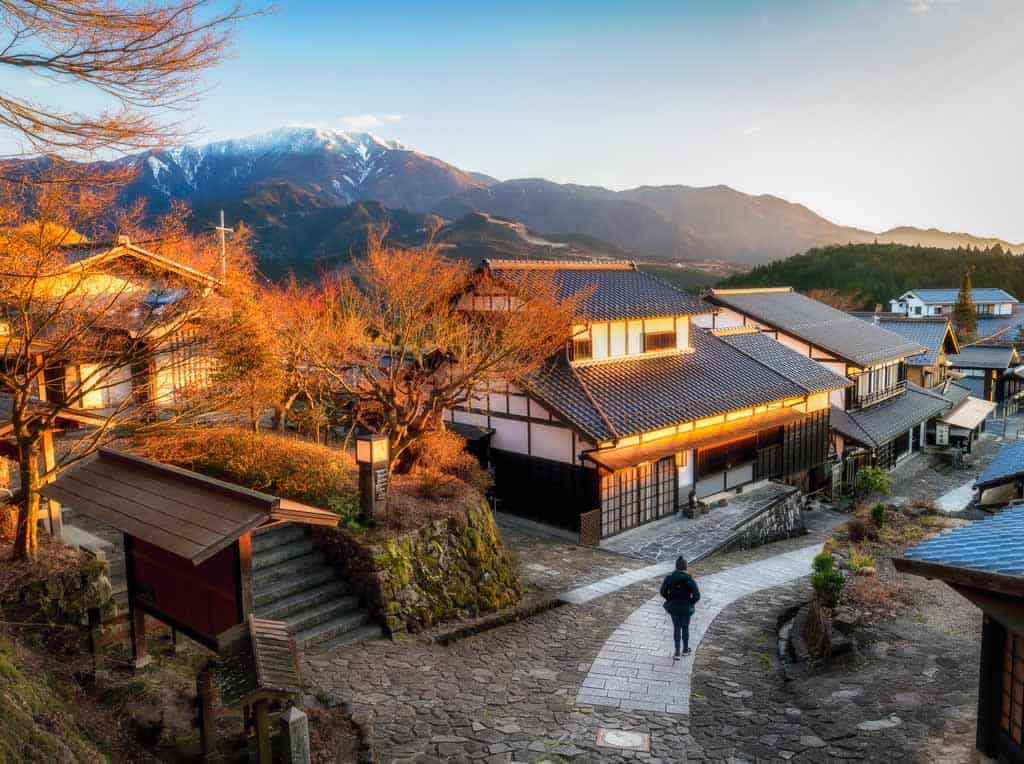
19 BEST Things to Do in Osaka, Japan [2024 Edition]
The perfect 3 days in tokyo itinerary, the best day trips from every city in japan [2024], travelling in japan: at a glance.
Here are the basics about travel to Japan.
OTHER MAIN CITIES:
Osaka , Kyoto , Nagasaki, Fukuoka , Sapporo and Nagoya
Yen (See current exchange rates ) (1$USD is approximately 108 yen) 1 beer is approximately 500 yen (USD$5)
ENTRY / VISA:
Visa requirements for Japan are very straightforward. Most travellers are visa-free and can stay for 15, 30 or 90 days depending on their nationality. For information about which countries are granted visa-free access click here.
Japanese is the official language in Japan. And while most of the world speaks a fair amount of English, do not expect Japanese people to speak it. However, in some hostels and hotels, English is spoken. Before travelling to Japan be sure to learn a few key phrases to help you enjoy your travels more and, of course, to show respect for the Japanse way of life. Many signs are in both Japanese and English and announcements at subway and train stations are often in both languages.
Japan is one of the safest countries in the world for both men and women. Petty theft and violent crime are extremely rare. Stories of people leaving wallets, passports and bags on trains and being reunited with them are the norm. However, you should still be sensible and follow the usual travel precautions.
ELECTRICITY:
100 volts / Type A and B electric sockets (Be sure to get your universal travel adapter before you leave)
TRANSPORTATION:
By far the most common way to get between cities in Japan is by using the JR Pass. Within the larger cities, you can very often make your way around using public transportation. Traditional taxis are also available in most cities and suburban regions. And rideshares such as Uber are on the rise as well – though don’t count on one of these outside of the main Japanese metropolises.
Don’t Forget to Pack the Most Important Thing: Travel Insurance !
TOP 5 TRAVEL EXPERIENCES IN Japan
With so much to see and do in Vietnam, it really is hard to pick the top experiences.
However, we think that to truly appreciate Vietnam you need to plan to do these 5 activities during your visit.
Gorge yourself on sushi.
Japan is known for sushi. You can find it everywhere. For added enjoyment, try your hand at making it!
Book a sushi cooking class here .
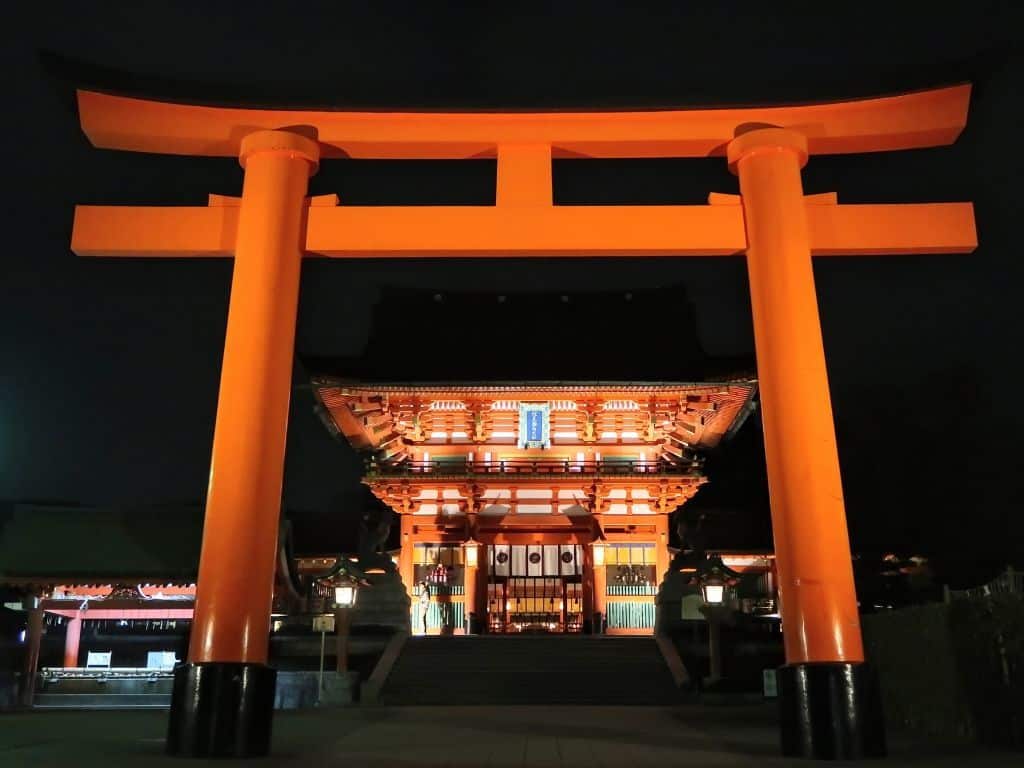
Visit ancient temples in Kyoto
Kyoto is the magical, ancient city of Japan known for being the spiritual centre of the country. Immerse yourself in the beauty and stillness of its many temples.
Check out our 3 days in Kyoto itinerary here.
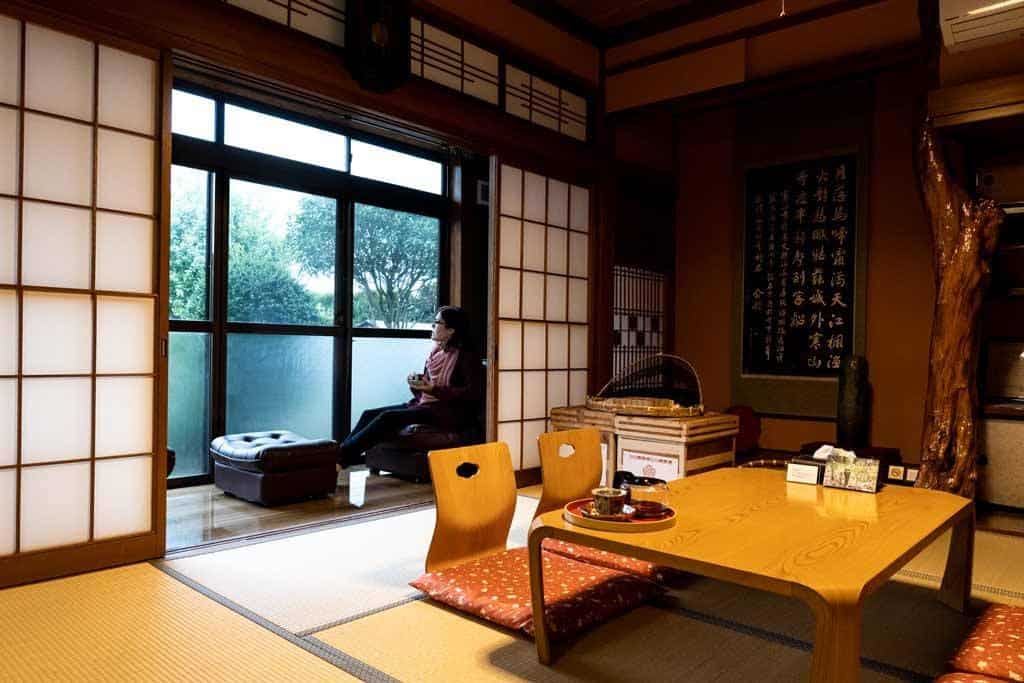
Spend the night in a Ryokan
Staying in a ryokan is the most authentic way to experience Japan. Splurge on the experience and find yourself turning Japanese after a refreshing stay!
You can stay in a great ryokan in Murakami .
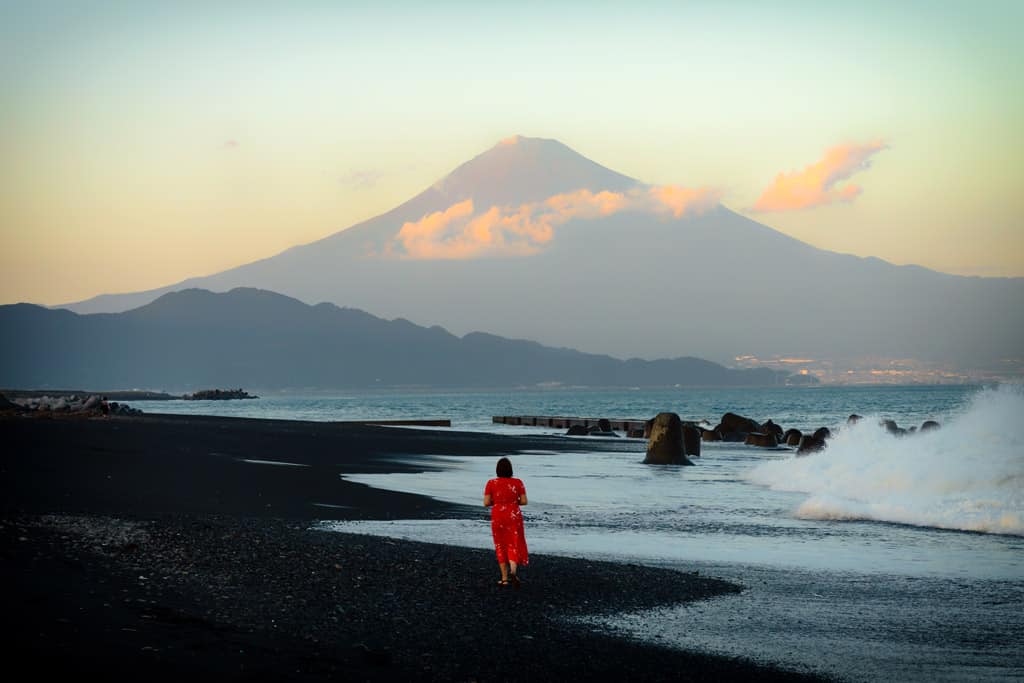
Climb/View Mt. Fuji
One of the most picturesque volcanic mountains in the world is accessible to climb, or simply view, throughout much of the year.
This is the best Mt. Fuji day trip you can find anywhere
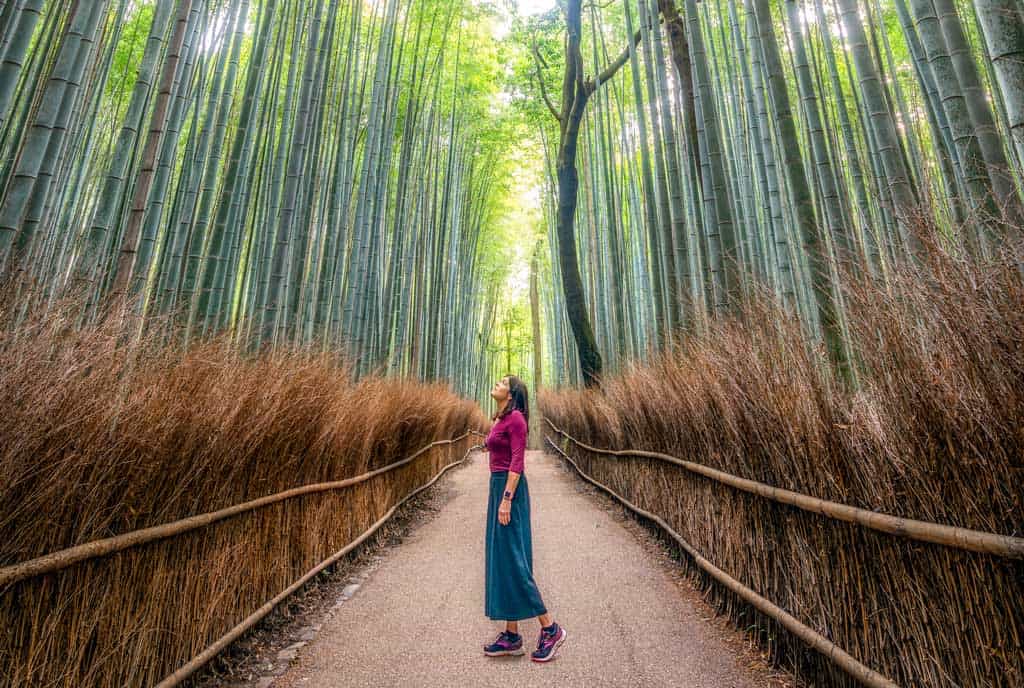
Get lost in a giant bamboo forest
Bamboo that stretches to the sky can be found in Kyoto. Be mesmerized by the sound of the swaying forest.
Other Things to do in Japan
Party with robots in Tokyo: The 90-minute show is one of the most unique and bizarre must-do activities in Tokyo. It may take you a few minutes to figure out what you’re watching (don’t miss that video of it). But you’ll definitely be glad you went!
Watch a sumo wrestling match . Sure, sushi can be found on every street corner. But eating it at every meal won’t give you a chance against world-famous sumo wrestlers. Catch a match and be a part of a long and sacred activity.
Cross the world’s busiest pedestrian intersection . Shibuya Crossing in Tokyo will blow your mind with the number of people moving at any given time when the traffic stops to let pedestrians cross. Head to the QFRONT building to watch 2,500 people cross the streets below.
Hang out with deer in Nara . The normally shy creatures are anything but shy as they can be found in abundance in Nara Park . Whether you want to interact with them, or simply view them in nature, the experience is worthwhile!
Spend the night in a capsule hotel . Japan is known for tiny packaging. A Capsule hotel is just as it sounds: a tiny box-like structure intended for one person to spend the night. Warning, this is not for the claustrophobic!
Relax in an onsen . Onsens are hot springs that can be found in natural and man-made settings. You haven’t relaxed until you’ve spent a few hours in an Onsen. Just know sometimes the dress code is your birthday suit! Check out this one in Hokkaido . Just be careful if you have tattoos, because many onsens don’t allow them.
Go diving in Okinawa . While the northern Japanese islands have a tendency to be cold, Okinawa is located in a more tropical climate and lends itself to spectacular diving. You’ll love the underwater world of these islands!
Go Kart dressed as your favourite cartoon character . If you’ve ever played Mario Kart and wondered where in the world you could go and ride around a go-kart dressed up like Mario, Yoshi, Princess Peach or your other favourite characters, this is it.
Watch the cherry trees blossom . Japan has cornered the market in cherry tree blossoms. This is so much so that every year thousands of people participate in cherry blossom festivals as the trees unload their dazzling colour across the country. If you visit Japan in spring be sure not to miss out! This particular tour is incredible as a day trip from Tokyo .
Hike with monkeys . If you enjoy hiking AND monkeys then the 30-minute hike outside of Kyoto is for you! But if you just prefer to hike and don’t want anything to do with monkeys, there are plenty of other great trails to hike in Japan!
BE SURE TO CHECK OUT THESE OTHER AMAZING THINGS TO DO IN JAPAN
READ MORE...
18 Amazing Things to Do in Kyoto at Night (2024 Guide)
The ultimate travel guide to chino in nagano, japan, the ultimate travel guide to nakatsugawa, japan (2024), the ultimate travel guide to oita, japan (2024 edition), the ultimate sado island japan travel guide [2024], best places to visit in japan.
There are plenty of amazing places to visit in Japan. Depending on your interests, trip duration and time of year you will find plenty of things to do during any length of stay.
There’s a reason Tokyo is considered one of the most incredible, vibrant, unique and fascinating cities on the planet! Where ancient meets modern, history rubs shoulder with the future and the world’s best cuisine is out in full force.
Japan’s capital and a city full of awesome things to do !
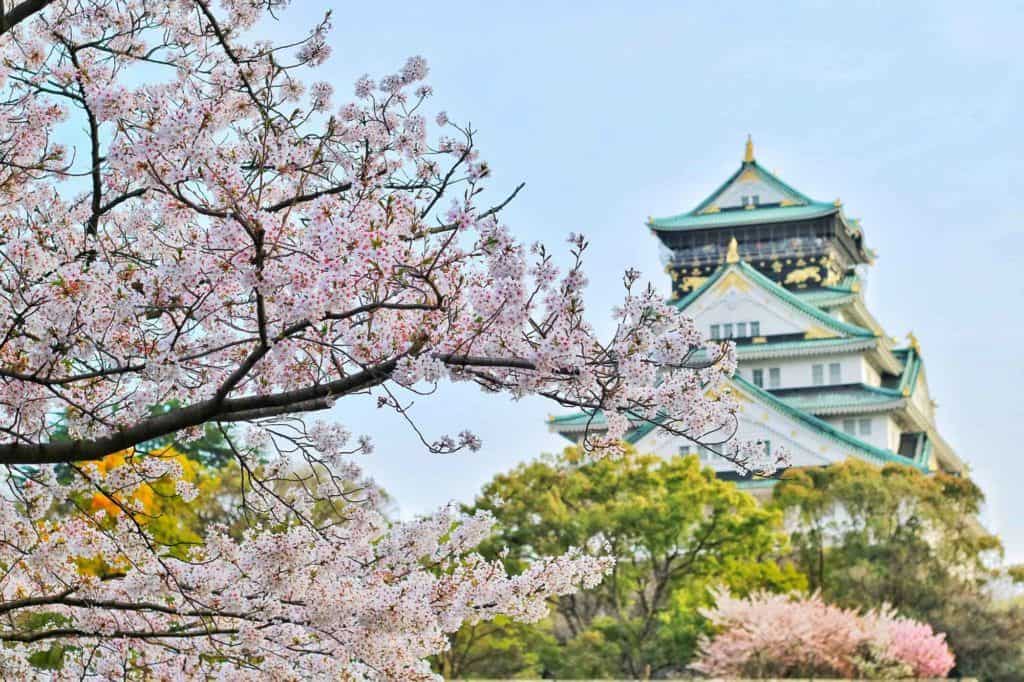
A city where ultra-modern meets ancient and you can do just about anything you can imagine.
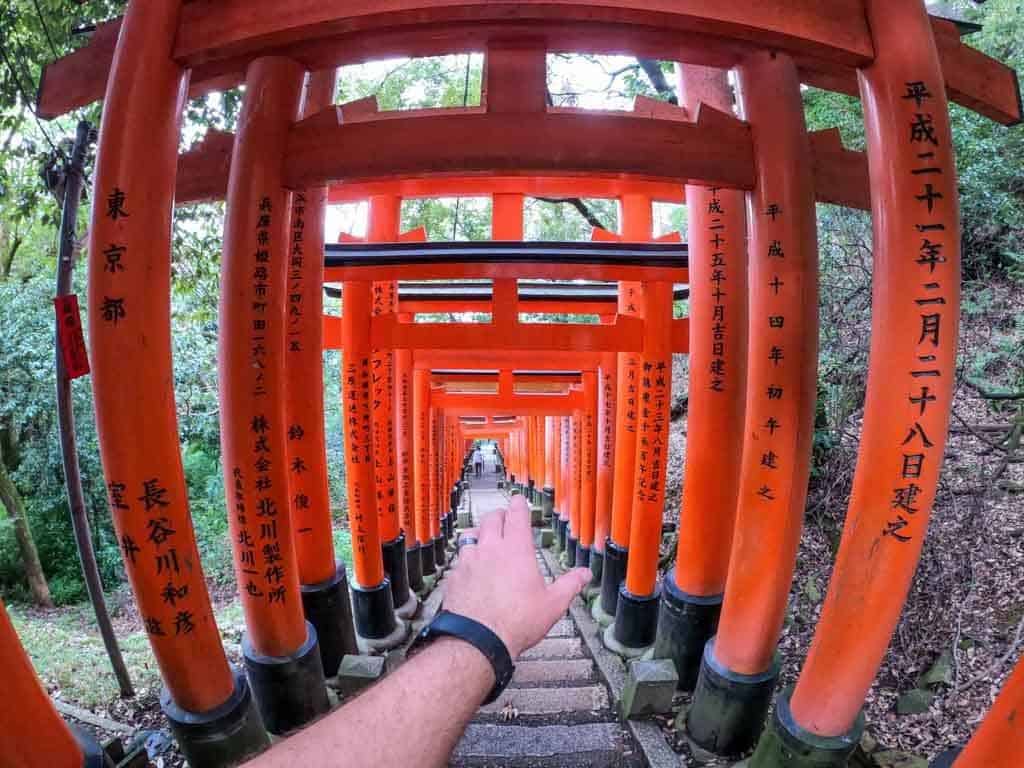
A magical place to explore Japan’s rich culture and history .
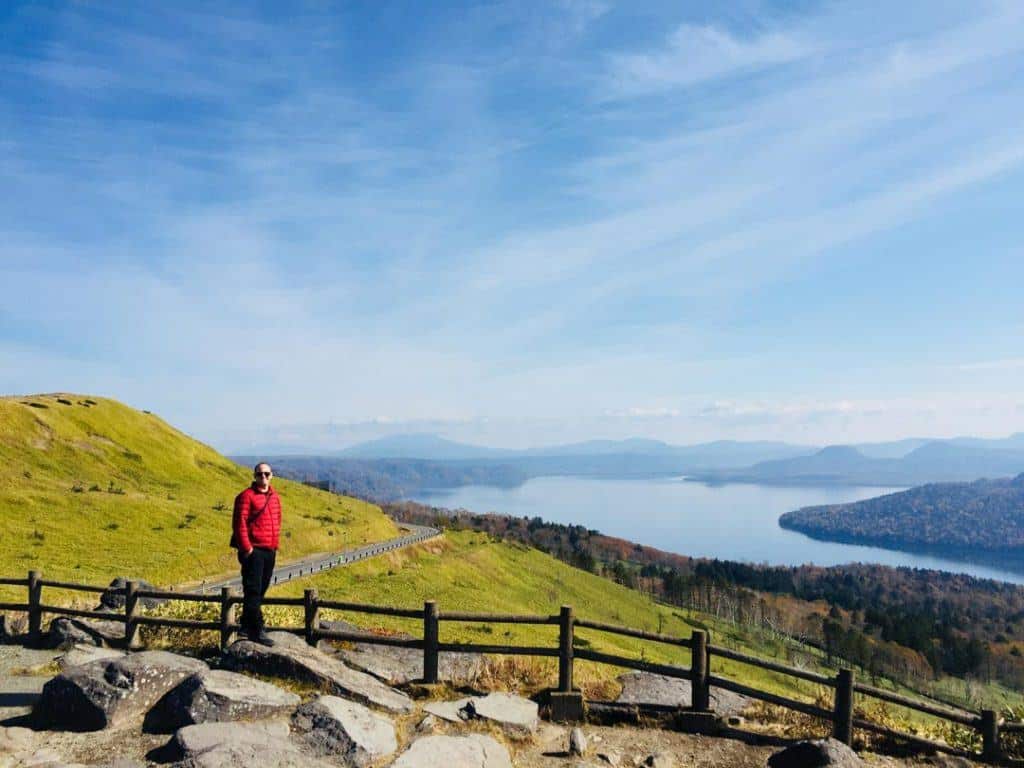
Get away from the cities and explore the gorgeous island of Hokkaido !
For more information on specific things to do in the top places to visit in Japan, reference our following city travel guides:
- 3 Day Tokyo Itinerary
- Day Trips from Tokyo
- 3 Day Kyoto Itinerary
- Day Trips From Kyoto
- 3 Day Osaka Itinerary
- Day Trips From Osaka
- 3 Day Yokohama Itinerary
- Day Trips from Yokohama
- Hokkaido itinerary
- Hokkaido activities
BE SURE TO CHECK OUT THESE OTHER AWESOME PLACES TO VISIT IN JAPAN .

BEST JAPAN TRAVEL ITINERARY
Depending on whether you are starting from scratch or have a general idea of what kind of things you would like to see and do, we’ve put together a few itineraries that are sure to leave you wanting for nothing at the end of your visit.
There are so many amazing things to do in Japan that planning an itinerary for your travel can be a little overwhelming.
In this section, we’ll not only help you plan a 1-, 2-, or 3-week Japan itinerary but also give you an overview of many of the places you might want to consider visiting and things you may want to do.
Of course, no one-size-fits-all plan will suffice. But if we were to head back to Japan these are the top places and things that we would want to do!
KEEP AN EYE OUT FOR AWESOME DAY TRIPS FROM EVERY MAJOR JAPANESE CITY
3-Week Japan Travel Itinerary Highlights
Even with a country that seems as small as Japan, three weeks is hardly enough time to get started in seeing it all!
However, with three weeks you can have a really nice time both spending more time in places many people only glance by as well as visiting some places that most people don’t see when they visit Japan.
Here’s an overview of how we’d spend 3 weeks in Japan.
2-Week Japan Travel Itinerary Highlights
With two weeks to travel to Japan, you are going to have to cut out some of the nicer places you could see with an extra week or two.
But the good news is you are still going to see and do a lot while you are here!
This is an idea of how we’d spend 2 weeks in Japan.
1-Week Japan Travel Itinerary Highlights
If you only have 1 week to visit Japan, don’t worry it is definitely worth your time. Of course, you’re going to have to pick and choose where you go and what you do much differently than if you had more time.
And you likely won’t want to spend all of your time travelling from one island to the next.
So if we had just 1 week in Japan, this is how we’d spend it.
JAPAN TRAVEL PLANNING
You’re well on your way to becoming an expert when it comes to travel to Japan! Now we’ll fill you in on the rest.
Best Time to Visit Japan
There really is no best or worst time to visit Japan. The timing of your trip all depends on what you want to see and do and how willing you are to share your Japan travel experience with other travellers.
Across the country sakura (cherry blossom) season in Spring is one of the most popular times to visit. But it happens at different times across the country due to the differences in climate from north to south along the island chain.
Another less popular, but no less stunning, time to visit is Autumn as the leaves begin to change colour.
Whilst this doesn’t quite bring in the crowds like sakura season does, the sheer array of colours on display is absolutely stunning, particularly on Japan’s most northerly island, Hokkaido.
Summer brings sweltering temperatures and typhoons in the south. However, Japan is extremely well prepared for such events. As such is still possible to travel to Japan during this of year.
Winter brings some of the world’s best skiing on Hokkaido as snow makes some roads and hiking trails impassable. However, this is also the best time to see the famous ice flows close to the Shiretoko National Park.
And, of course, it’s a great time to shred some powder if you’re looking for some world-class slopes!
Japan Travel Budget Guideline
Japan has an unfair reputation for being incredibly expensive. And whilst you could easily empty your bank account in a short time, it is possible to travel in Japan for less money than you think.
Budgeting Tips
To make your money go further here are a few tips:
1. Purchase the rail pass you need. There are a huge number of different types of rail passes available in Japan. This is your one-stop-shop for a variety of rail passes.
2. Take advantage of low-cost internal flights. You can fly affordably between most major cities.
3. Utilise convenience stores for finding cheap and delicious eats.
4. Japan has an extensive and reliable night bus service. Use it to save on travel and hotel fees.
5. Limit your alcohol intake, it’s surprisingly expensive. 1 beer = 500-600 yen (USD$5-$6).
6. Check the subway passes available in the city in which you’re staying and purchase the rail pass you need.
CHECK OUT OUR JAPAN BUDGETING GUIDE TO HELP MAKE YOUR MONEY GO FURTHER.
But there are a few things you should know about the different budgets at which you can choose to travel.
Note: Budgets shown as Single Traveller / Couples per day.
Budget Traveller ($50-60 Single / $80-110 Couples)
Hostels are the best options for single budget travellers. However, if travelling as a couple it’s often cheaper to get a private room.
There are plenty of awesome free things to do all over Japan. You will need to think outside the box and do your research but it is very possible to travel in Japan on a budget like this.
Your meals will likely come from low-cost restaurants and corner stores. And you’re likely going to spend a fair amount of time walking and taking public transportation.
Mid-Range Traveller ($60-100 Single / $120-180 Couple)
Whilst you may not get much of an upgrade on the accommodation front, travelling in this budget range will put you in the position to possibly rent a car to explore parts of Japan that are more difficult to reach.
In addition, you may be able to spend more time eating in some funky izakayas and sushi restaurants and participate in a few formal tours.
Luxury Traveller ($250+ Single / $400+ Couple)
Luxury hotels and fancy restaurants are the order of the day here. If money is no object then travelling in Japan can extremely luxurious!
For instance, you can stay in beautiful ryokans instead of hostels or hotels. And you can order a variety of different meals to enjoy while dining at some of the finer restaurants.
Of course, you’ll also be able to do more by way of renting a car and/or joining up on a variety of different tour groups to keep your itinerary completely packed.
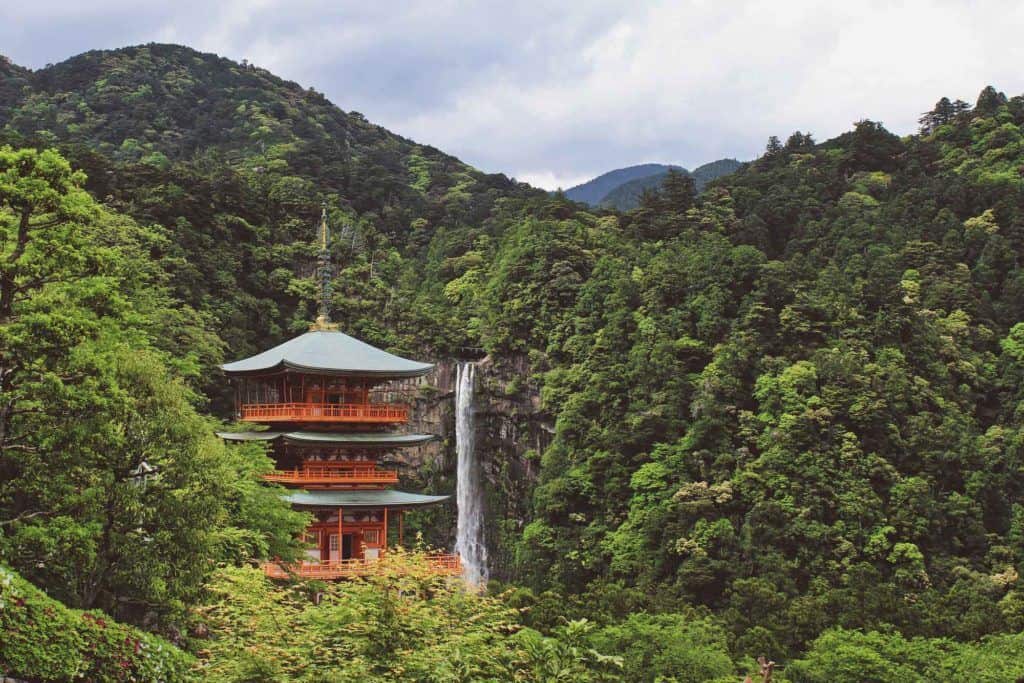
Getting To and Around Japan
Japan is an island nation, thus travelling to Japan is limited to only air or water transportation.
The majority of International Flights will take you to Tokyo’s Narita or Haneda Airport’s or Osaka International Airport. From there you will connect, as necessary, to other Japanese destinations.
Entry Requirements
Visa requirements for Japan are very straightforward.
Most travellers are visa-free and can stay for 15, 30 or 90 days depending on their nationality. For information about which countries are granted visa-free access click here.
Getting Around Japan
Travelling in Japan is both easy and convenient.
The public transport network is wide-ranging and extremely reliable. And compared to many places in the world, it can also be quite affordable.
Additionally, hiring a car is both easy and safe.
Travelling by Air
Japan has an excellent domestic air travel network. There are two passes run by JAL and ANA that will allow you to take domestic flights for around $100.
The price can sometimes vary depending on where your origin and destinations.
If you plan this effectively with other transport options available it has the potential to make your visit to Japan even more convenient and affordable.
Travelling by Car
Although the country is fairly well connected with both public and private transportation options, hiring a car is an excellent option for travelling in Japan.
The best part is that it is not as difficult as you may imagine.
Driving in Japan is safe and easy. For Hokkaido, Kyushu and Shikoku, a car is the best way to see most of each island’s most beautiful sights outside of the city centres.
Travelling by Bus
There are a number of bus companies operating in Japan. The biggest of these is Willer Bus Service.
Not only are fares convenient and affordable, but they can also help you consolidate expenses if you travel at night.
Combining overnight bus travel with a JR pass can save you a fortune as the difference in price between regional, 1 week national and 2-week national passes are huge.
Travelling by Boat/Ferry
Often the only way to access some of Japans smaller islands, particularly in the Seto Inland Sea, is by boat or ferry. Japan boasts an excellent maritime transport network.
Generally, ferries are affordable and in some cases, they are covered by a JR pass (the ferry to Miyajima being the most well-known example).
Naturally, the costs increase if you ferry a car or if you are taking a long-distance ferry.
Travelling by Train
Japan’s train network is simply incredible as it can take you from the north of Hokkaido to the south of Kyushu.
But it can also be confusing as, like with a lot of things in Japan, there is a myriad of different options available to you.
PURCHASE YOUR JR PASS TODAY
How to Maximise a JR Pass
Because your travel to Japan will very likely involve transportation on a JR line at some point, we’ve put together a few tips to help you plan your JR Pass use accordingly.
- Download Hyperdia – This amazing app allows to research train times and more importantly prices. Currently, it is free to use for 3 months (after that you will need to pay). You can work out which JR pass is the best financial option. Do note that the seat fare (sometimes two-thirds of the cost) is not optional, you will need to pay it.
- You don’t need a rail pass for your entire time. Some people may be visiting Japan for 2 weeks and will buy a 2 week nationwide JR pass. You are likely not going to be using the train every day and it’s likely you will pay more than you need to.
- Activate your JR pass at the right time. To activate you pass you will need to go to the station and inform them of when you want to activate it. Make sure you activate it when you really need it so you can get the most out of it.
- Check out the regional passes. There are numerous regional passes available that are much cheaper, but they cover a smaller area and don’t last as long. However, they can be a fantastic option. Combining such passes with night bus services can save you plenty of money.
Apps and Technology
Japan is definitely well connected when it comes to technology.
When you visit Japan you are likely going to want to remain connected to the outside world as well as take advantage of mobile apps that make travelling through Japan a little easier.
Here are a few we think you should definitely acquaint yourself with prior to your travels:
- Hyperdia – Hyperdia is the premiere app for helping you to understand the transportation system in Japan. Find the right rail line, station and even schedules to help navigate what could otherwise be a complicated transportation system.
- XE Currency – Transfer, monitor and calculate currency as the need arises. This app may not be totally necessary as you are typically tied into rates the banks charge for services. But it is handy to have around.
- Express VPN – This will protect your sensitive information wherever you travel – not just in Japan. Be sure to have this to keep your online information secure as you travel.
- GuruNavi – This app will help you to find food options in whatever prefecture you happen to be at the moment. You can search through different types of cuisine as well as to filter your selections for things like English-speaking staff and WiFi availability.
- Google Translate – Even if you don’t know more than a handful of Japanese words, iTranslate will help you communicate as you travel in Japan.
Best Things to Eat in Japan
Japanese cuisine is justifiably one of the worlds popular. It focuses heavily on high-quality ingredients and as a result portion sizes are smaller than you may expect.
Although fried dishes are common in Japanese cuisine, Japan has the lowest rate of childhood and adult obesity amongst the OECD nations.
This is down to a mixture of smaller portions and a culture that promotes restraint and health.
Yakiniku: Japanese BBQ. These restaurants can be found all over Japan, and it is very rare that they are anything other than delicious. Many offer time based all you can eat/drink deals. Look out for the characters 放题 as they usually don’t advertise this in any language other than Japanese.
Katsu Curry: Fried chicken or pork cutlets smothered in Japanese curry. Heaven on a plate.
Kushikatsu: All manner of meat and veg skewered and deep-fried.
Sushi and Sashimi: This can go from cheap to eye-watering expensive. Conveyor belt sushi restaurants offer the cheapest prices. Be brave and try delicacies like sea urchin, horse or chicken sashimi.
Sukiyaki: Meat and vegetables cooked in a hot pot with a small amount of water and soy sauce.
Ramen: The nations most popular noodle dish, often an excellent budget option.
Gyoza: Pan-fried dumplings, often filled with pork.
There is certainly much more available than this, but hopefully this gives you a quick overview.
Convenience Stores: For budget eating options convenience stores like lawsons, family mart and 7-11 are often an excellent option for a cheap and hearty meal!
Izakaya : No mention of eating in Japan would be complete without mentioning Japan’s most famous eating places; the Izakaya (居酒屋).
An izakaya is a Japanese pub that is generally a place where friends, colleagues and family members will go to eat, drink and chat.
The huge menus consist of small plates that are shared amongst the group. Expect to find sashimi, yakitori, cold dishes, salads, fried dishes and desserts.
ACCOMMODATION IN JAPAN
Japan has a huge range of accommodation options. The most obvious difference is whether it’s a Japanese or western style room.
In Japanese style rooms, you will be sleeping on tatami mats on the floor, which are actually incredibly comfortable.
This option is far more common outside of popular tourist destinations. Western-style rooms have regular beds.
Many single rooms in hostels, guesthouses or hotels will have bunk beds to fit more people. This will usually be stated when booking.
It is not always the most romantic option but it does help you get more bang for your buck.
Types of Accommodations
Whilst hostels exist in Japan, they are not as cheap South East Asia. There is a reasonably good hostel network throughout Japan. But hostels are not as common or widespread as in other popular travel destinations.
If travelling in Japan as a couple or pair, a hotel room is often cheaper than 2 beds in a dorm. It’s always worth comparing, hostels are not always the cheapest option when there’s more than one of you.
Western-Style Hotels
These will be the traditional hotels that you would find in most places in the world.
They include major Japanese and international brands and are more common in larger cities.
You can expect amenities and comfort similar to those you’d find in other destinations.
Capsule Hotels
A unique way to spend a night or two in Japan is in a capsule hotel. As the name suggests, these are small enclosed spaces usually only large enough for a bed.
Sometimes you will have a television and a small storage space. But more often you can expect to have to stash your gear in a locker. You’ll also, obviously, be using shared restrooms.
Traditional Japanese Ryokans offer luxurious stays in often gorgeous accommodation and locations. However, they can sometimes be very expensive.
It’s not uncommon for Ryokans to have an onsen. But if you want an authentic Japanese overnight experience you won’t find anything that surpasses a stay in a Ryokan.
Another good option in recent years is AirBnB, and there are more and more amazing places popping up to stay for very affordable prices every day.
As is typical in many destinations where Airbnb accommodations are popping up, you’ll likely find great value and a little more personal space with an Airbnb stay.
Onsen Hotels
Last, but by no means least; Onsen Hotels. In short, these are hotels that have an onsen attached.
They cover a wide variety of budgets but often they are not the cheapest options available.
However, the luxury of being able to have an onsen whenever you want is well worth it.
Just note that with onsens there are some basic rules to follow. These will often clearly displayed, but here they are:
- You must be completely naked – no bathing suits. Leave awkward at the door, with your clothes.
- Do not put your towel into the onsen water. Most people wrap it around their head.
- Shower before you enter the onsen, taking care to splash others with your shower water.
Or, if you’d like to check out a few options on your own here are a few resources to get you started!
JAPAN TRAVEL TIPS
Travelling in Japan can definitely be rewarding. But it can also be a bit of a headache – especially if your knowledge of the Japanese language and culture is limited.
Further, not being prepared for adventure can hamper your optimism as well.
Imagine you’re all set for your day of walking around majestic Kyoto and you failed to pack an umbrella or raincoat.
Of course, you have your own reasons for travelling to Japan. So likely you know whether you plan to dive in Okinawa or climb Mt. Fuji.
But for everything else in your journey, let us remind you of a few travel tips for Japan to make your adventure safer, more enjoyable and more affordable.
General Japan Travel Tips
While there are many basic travel tips we suggest you use when travelling to Japan, there are also plenty of Japanese-specific tips that will make your visit the best it can be.
Here are a few we recommend you consider as you plan your trip to visit Japan:
1. Research Cultural Norms and Behaviour
Japan is a country with a very strong national identity and behaviour. Breaking these behavioural norms is most definitely frowned upon.
Here are a few basic Japanese cultural expectations:
- Do not talk loudly or answer your phone on the subway, bus or train.
- Do not eat on the above.
- Walking and eating are sometimes frowned upon.
- Stand on the left-hand side of an escalator.
- Follow the rules in an onsen.
- Do not litter – Japan is immaculately clean.
If you’re not sure if something is ok, just ask.
Many Japanese people know that foreigners are unlikely to be aware of Japanese norms and expectations and will be happy to help you.
2. Eat, Eat, Eat.
Japanese food tastes so much better in Japan. Take the opportunity to try things that you are very unlikely to find in your home country.
3. International Drivers Permit
If you plan on renting a car in Japan you MUST have this document.
Without it not only will you be unable to rent a car, but you also will not be given a refund if you have already paid.
4. Take your own chopsticks
Single-use chopsticks are the norm in Japan. Take your own and do a little bit for the planet.
5. Do your research
A bit of planning and research does make a real difference, especially for utilising public transport. Getting a handle on this will leave you in the best place to get the most out of your trip.
6. Show respect and places of worship:
All temples and shrines will have rules and guidelines clearly displayed in English or with pictures, yet some people are still not able to understand them. Don’t be one of those travellers that give everyone else a bad name.
7. Remove your shoes
This is common everywhere in Japan. In some cases, you may need to remove them before entering the lobby of a hotel.
However, it is more common that you are expected to leave your shoes in the coves next to the door of your hotel room. This is especially common in more traditional Japanese hotels.
8. Embrace Japanese toilets
The gadgets available in Japanese bathrooms are the stuff of legend. Soft music can be played so no-one can hear you doing your business, seats can be warmed on cold winter mornings and the variety of spray options will leave you feeling as clean as a whistle.
Japan Packing List
We always travel with a core packing list wherever we go. And when it comes to Japan, many factors will affect what else you need to bring along with you.
Check out our travel essentials and be sure to add any of the other additional items listed below.
TRAVEL INSURANCE. SIMPLE & FLEXIBLE.
Which countries or regions are you traveling to, what’s your country of residence, enter traveler’s age, staying safe in japan.
Japan is a relatively safe country in which to travel.
Clearly you should always practice some basic safety guidelines no matter where in the world you travel.
- Keep copies of your passport and financial documents in the event they are lost or stolen.
- Don’t be flashy with expensive items or cash. You’re not very likely to be targeted as a tourist in Japan. But this would surely set you apart.
- Avoid travelling alone at night. Call a taxi or Uber in advance and wait inside the venue until it arrives.
- Be aware of your surroundings, particularly if you’ve had a night out drinking.
- Keep your personal items close. Pickpocketing is about as bad as you can expect in Japan, so make sure your purse, wallet and phone, etc are secure particularly when travelling in crowded public transportation.
We won’t bore you with a more extensive list. Unless this is your first trip out of your home country you’ll be better off when you travel in Japan than many other places in the world.
If this is your first trip, congratulations!
If you practice many of the same common-sense habits you would at home, then you’ll be quite safe and enjoy your time in Japan.
Staying Connected in Japan
Japan is an ultra-modern country, particularly when it comes to technology. Thus staying connected when you travel to Japan will be no issue.
Of course, like any place in the world, the further you go away from metropolitan areas the more you can expect slow to no-service in areas.
For phone and data service, first check with your local cellular carrier to determine if your current plan will cover you when you travel to Japan.
In many cases, carriers have expanded their international coverage to popular places such as Japan.
If not, they will likely have a very expensive option for you to purchase on a daily/weekly basis.
We feel like your money will go a lot further if you consider a few other options.
Purchase a SIM Card
First and foremost is to pick up a local SIM card upon arrival in Japan. You will need to make sure that your device is unlocked before you can switch SIM cards.
However, this will be a reasonably inexpensive and fairly common way to access Japanese cellular networks without paying outrageous international travelling fees through your home carrier.
Rent a Portable WiFi Device
A second option would be to rent a portable WiFi device that will allow you a certain amount of data/service over a set period of time.
These are relatively affordable compared to most cellular plans’ international options.
You’ll typically have to pick these up from central locations such as the airport or train station. But it’s likely you’ll be passing through here anyway.
Access Free WiFI
And finally, you could always just ensure that your device is on aeroplane mode and then hop from one WiFi hotspot to another.
Plenty of places in the towns and cities you will visit will offer WiFi.
From restaurants, hotels, railway and train stations and even some public spaces, you’ll find many venues that will cater to your need to stay connected.
Be a Responsible Traveller in Japan
Being a responsible traveller in Japan is important on many levels.
First, you represent yourself wherever you travel.
Nobody likes a jerk – especially people minding their own business in their own country.
Taking the time to learn about Japanese customs and culture will help you understand how you can be more responsible when you travel to the country.
Second, you represent your home country and other travellers. If you act or say things that reflect poorly on yourself while travelling in Japan then these actions also reflect poorly on other travellers.
While stereotypes suck – the truth is that most people form opinions based on first experiences. So let’s try to make your interactions with others positive while travelling in Japan.
Additionally, the resources of the world are limited.
Even though you might have certain customs or routines back in your home country does not mean you need to extend them when you travel to Japan.
For instance, carrying a reusable water bottle is loads more responsible as a traveller – although you may not think twice about using disposable bottles back home.
Key Japanese Travel Phrases
You don’t have to be fluent in Japanese to have a great time when you travel to Japan. But it does help to know a few key phrases.
This will not only assist you in your travels but it will also show respect to the local Japanese people that you are doing your best to assimilate into their culture.
Books To Read About Japan
Maybe you already know everything about Japan. Chances are you don’t!
But even if you are well-read, here are a few suggestions that might be worth your time while you’re on the plane to Japan.
A Geek in Japan . A fascinating read that takes you into the heart of understanding Japanese culture. This is a top pick among most Japan travellers.
Memoirs of a Geisha . Perhaps the. most well-known book in recent times thanks to its popularity as a movie. The historical fiction follows the story of a young woman thrust into the life of a geisha.
Rice Noodle Fish . A creative way of exploring Japan from a culinary standpoint. Tantalizing pictures of delicious food accompanies the personal story and in-depth information about some of Japan’s best eats.
Hokkaido Highway Blues . Follow a hilarious and entertaining journey by the author to traverse Japan in stride with the cherry blossoms. Meet a cross-section of Japanese culture through the lens of the author.
BOOKING RESOURCES
I know, I know – we’ve already mentioned these resources a bunch in this travel guide.
But here’s the thing… we know you’re going to want and need these resources to help you save money and have a more enjoyable trip
Table of Contents
Read our vietnam posts, ryokan ochiairo review – is this japan’s best ryokan, budget travel in japan – ultimate backpacking guide [2024], 25 awesome things to do in tokyo, japan, 7 best day trips from osaka, japan (2024 travel guide).
- Search Please fill out this field.
- Manage Your Subscription
- Give a Gift Subscription
- Newsletters
- Sweepstakes
- Destinations
Here's What's New in Japan for Travelers Planning a Trip in 2023
An expert deep-dives into how the Land of the Rising Sun has changed over the last three years.
:max_bytes(150000):strip_icc():format(webp)/Brandon-Presser-97a4675f1bb3487b88f06e5e2234eac6.jpeg)
Brandon Presser
After living in Tokyo as a student and young professional, I’ve made visiting Japan a priority at least once a year since, deep-diving new and interesting themes and destinations as the country continues to evolve both with and against the rising tide of globalization. I’ve written about everything from the secret world of “rotten girl” fan fiction manga to the far-flung village in Shikoku that’s become a cult attraction among Kengo Kuma architecture devotees; I’ve also authored three travel books about the country. This time, I’ve been on a quest to discover everything that’s new and different now that Japan’s officially open for tourism once more. Here’s what I’ve found after a month of on-the-ground research:
Hotels want to be more than just a place to stay.
They want to be your tour guide. Born from the ashes of the pandemic, hotels are leaning harder into diversifying their offerings. In Japan, hotels are upping the ante to become not just the place you hang your hat, but the lens through which you capture the destination.
Leading that trend in the luxury section is Aman, which has established a reputation for embedding itself so deep within its locales that it feels endemic. Aman Tokyo was the first Aman to take the recipe for sprawling resorts into the heart of a city ; a sanctuary incorporating natural materials, a floor plan pastiche of the traditional Japanese house, and incredible views of the imperial gardens with — on a clear day — Mount Fuji just behind. During the quiet of the pandemic, the brand dug even deeper, creating a circuit of bespoke tours for guests to the nearby Nihonbashi district, where they connect with artisans who have been perpetuating precise, generations-old traditions like kimono making and chopstick whittling. At the in-house restaurant, Musashi by Aman, the eponymous chef Musashi takes diners on the most comprehensive culinary experience possible. Never mind the flight of sushi shopped from the market earlier in the day; on Sundays and Mondays, Musashi retreats to his mountain hideaway to grow rice, farm wasabi root, and spin his potters wheel into compelling ceramics — all of which then find their place on his dinner table.
The theme of intentionality continues at Aman Kyoto, which opened just as COVID-19 was ripping across Asia; a sanctuary on the outskirts of the city with a tucked-away garden in Mount Hidari's forest, inspired by the ruins of Machu Picchu, but with distinct local flair. The perfect antidote to the touristic hustle of the country’s favorite temple town, the resort’s modus operandi is to encourage guests to completely slow down, whether that means soothing soaks in the geothermal onsen , riding bikes around the nearby temples (wondrous places of worship but with a fraction of the tourist traffic), or strolling through the property’s forest and sitting down in a quiet nook with a resident artist to paint the vivid sakura buds of spring or the deep red maples of koyo in the autumn.
Across the midrange and budget categories, it’s Hoshino Resorts, the legendary Japanese hospitality company, that’s making a concerted effort to be the custodian of local culture. Their KAI properties put playful twists on Japanese wellness, granting visitors entry into an arcane realm of traditions that extend far beyond soaking one’s body in hot water. Each KAI ryokan , or traditional Japanese inn, is grounded within its native destination, where dinners and breakfasts prioritize seafood, meat, vegetables, and even dishware from the local prefecture; and activities go as in depth as creating one’s own line of beauty products using geothermal water and local essential oils.
Hoshino’s OMO hotel brand focuses on urban destinations. At their property in the Sanjo district of Kyoto, for example, there’s a map of the neighborhood painted as a massive mural in the lobby, with restaurants and shops hand-picked by the staff painted in (each one has a QR code, too, so you can save them to explore). Their hour-long “Ranger Tours” match guests to employees for brief walkabouts around the hotel; mine highlighted unique souvenirs from shops dating back 300 to 400 years.
The Olympics spawned new accommodations across the entirety of Japan, not just in Tokyo.
Tokyo’s 2020 Olympics ambitions extended far beyond supercharging the city’s infrastructure; the strategy was nationwide. Of course, the Games ended up being a pale shadow of its intended self due to COVID-19, but plans to build new hotels all across the country had long been in motion already.
While the capital certainly had its fair share of openings — most notably the dazzling new Four Season Tokyo at Otemachi, and the party-prone Tokyo Edition, Toranomon (with its sister property, the Tokyo Edition, Ginza, opening up the street next year), Kyoto saw a huge number of hospitality heavy-hitters plant roots, too. Beyond the Aman Kyoto, the heart of the city now has a dozen new and notable addresses including the Ace Hotel, Hotel Ethnography, Marufukuro in the former Nintendo headquarters, and the standout Park Hyatt Kyoto, just steps away from Kiyomizu-dera. Do yourself a favor: even if you’re not calling the Park Hyatt home, it’s imperative that you stop by at sunset for cocktails at the small bar on the fourth floor — the views of Yasaka pagoda are as iconic as any Fuji photo.
Of all the hospitality stalwarts, it’s IHG — with over 50 years' presence in Japan — that’s making the biggest bet on the country's reopening tourism boom. First out the gate in 2020 was the Hotel Indigo Hakone Gora, a hybrid retreat that blends European comfort with Japanese wellness. Then the Kimpton Tokyo Shinjuku opened next to the Park Hyatt Tokyo with more approachable nightly rates; and without an initial influx of international travelers, the pet-friendly property became a haven for well-heeled Tokyoites and their pooches during the border closures. Two more Hotel Indigos opened in 2022 — one in the forested Karuizawa area, and one on the outskirts of Nagoya, and seven more properties are slated to open in the portfolio over the next couple of years, including another Hotel Indigo in Tokyo’s vital Shibuya neighborhood.
“Now, more than ever before, there’s a lot of support to get tourism out into the rural areas of Japan,” explains Rob O'Leary, Black Tomato’s Japan travel expert. “The Kura project north of Tokyo is worth noting as a big sustainability effort to bring young Japanese back to the countryside and help renovate traditional properties for accommodation and internationally inclined tourism services.” Despite the downturn of the pandemic, the Japanese government continued a pipeline of fiscal aid to areas experiencing population drain. “We recently signed a pledge with the town of Ine on the Tango Peninsula (near Kyoto),” adds Tyler Palma, the head of operations for Inside Japan Tours. “The agreement ensures that the travelers [we bring to the region] will stay for a minimum of two nights, which will allow them to not only experience the culture and atmosphere, but give back to the local economy, thereby preserving a unique way of life.”
Kyushu is becoming the must-visit destination outside Tokyo and Kyoto.
With a spate of international travelers poised to plan their second (or third, or fourth) trip to Japan, Kyushu is eagerly positioning itself as the go-to destination for those wanting to venture a little deeper, beyond the well-trodden Tokyo-to-Kyoto circuit. The country’s third-largest island is the heartland of many of Japan’s most coveted touchstones: tonkotsu ramen (Ippudo et al.) was born in Hakata; some of the finest beef is raised on the ranches of Miyazaki; shochu is distilled from barley and potato here; and it’s where Buddhism first arrived in the Japanese archipelago. Further, Yakushima Island is said to have inspired Studio Ghibli's Princess Mononoke, and there are more hot springs per capita here than anywhere else in the country, coaxed up from the below the Earth by some of the most active volcanoes on the planet.
A long-time favorite for Korean travelers, Kyushu is closer to Seoul than Tokyo as the crow flies, and it’s now catching the eye of major hospitality players. The InterContinental ANA Beppu Resort and Spa in Beppu is the island’s first legitimate international endeavor; Hoshino has recently opened an outpost of their KAI brand here as well; and there’s a Kengo Kuma-designed KAI up the mountain in the onsen town of Yufuin nearby. Both destinations are a part of Oita Prefecture, the perfect place in Kyushu to dip one’s toe, so to speak, if you only have three extra days to venture beyond Japan 101.
Next year, The Ritz-Carlton will open in Fukuoka, Kyushu’s largest city, and the Shinkansen bullet train will continue to expand here as well, proffering speedier service to locales that have been traditionally more burdensome to reach. Check out Inside Japan Tours’ two-week self-guided Kyushu tour if you can devote more time to this worthy area.
Tokyo is finally getting more green space and pedestrian-friendly routes.
Perhaps another function of the outdoors-oriented pandemic narrative, Tokyo finally seems to have more walking arteries away from busy roads. With tiny, packed-together apartments, Tokyoites have always used shopping areas as proxy hangout spaces due to the dearth of parks relative to the sprawling size of their city. Recently, however, a handful of greener pastures (literally!) have cropped up, lined with cafes, shops, and public seating. Check out the buried metro track line in Shimokitazawa, stretching from Higashi Kitazawa station through the heart of the hip neighborhood and down to Setagaya Daita station. In Shibuya, Miyashita Park is breathing new life into a rather forlorn section of the neon-clad area. And now it’s incredibly easy to link Sensō-ji temple to the Tokyo Skytree along the newly redeveloped Mizumachi canal.
An interesting aberration of Tokyo’s shop-to-socialize culture is the creation of luxury brand cafes. Take home a piece of Fendi or Louis Vuitton at their branded eateries; a latte at the new glass snake of a building in Ginza will set you back 1,500 yen (around $12), a bargain for the brag and the Vuitton logo-ed paper napkin holder you can take home. (The coffee itself was so-so, but the geometric design on the foam was definitely worthy of the ‘gram.)
The crowds are already back.
If you’re rushing to make Japan travel plans (Japlans?) before the crowds descend on the country anew, I’m sorry to say: that ship has sailed. Kyoto’s temples are jam-packed, and reservations at must-try restaurants are already backlogged. Although mainland Chinese visitors — who made almost half of Japan’s tourism intake before the pandemic — have not yet returned, travelers from neighborhood nations like Korea and Taiwan are arriving in droves. Americans are back in full force, too, and domestic guests are moving around their country like never before thanks to a generous travel subsidy by the government putting up to 11,000 yen (around $80) a day in the pockets of roving Japanese nationals.
There’s a currency Catch-22.
In the 20 years that I’ve been visiting — or living —in Japan, I’ve never seen such a strong U.S. dollar relative to the Japanese yen. It’s made mealtime an absolute pleasure; dining in Japan has always been lower-priced and higher-quality than in Western countries, but now I find myself planning all-day eating excursions to hit up establishments that are no longer aspirationally priced, plus gorging on all of the incredible cheap eats in between. The catch, however, is that accommodation prices are soaring as hotels falsely inflate their rates for the inbound international travelers booking up their rooms. A luxury hotel room in Tokyo this month (Dec. 2022) might set you back $1,200 a night, or more, and staff at these hotels are still getting used to the onslaught of diverse demands again. Breakfast’s been a sore spot at many of the properties, with unmitigated lines, and long wait times for a cup of coffee. Kudos are owed to the Grand Hyatt Tokyo for crushing their buffet service — it's speedy, tasty, and has the best croissants in town.
Masking is still prevalent.
Endemic to Japanese society since SARS in the early 2000s, wearing a mask in public has long been a courtesy performed by those who are feeling unwell to protect people around them. Officially, mask-wearing mandates have completely relaxed, yet everyone is still wearing them all the time — even outside, even dozens of feet from the nearest person. Recently, I had to eat a meal wearing plastic gloves provided to me by the restaurant. The influx of foreign tourists will likely help normalize a more relaxed approach to masking (traveler-laden Kyoto already had noticeably less masks than some of the rural destinations I’ve visited).
Related Articles
Nomadic Matt's Travel Site
Travel Better, Cheaper, Longer
The Ultimate Japan Itinerary for First-Timers: From 1 to 3 Weeks

I’ve yet to meet a traveler who didn’t love their time in Japan . It’s just one of those countries that everyone loves. How can you not? The food is carefully crafted and delicious; the history and culture are both rich and long; the landscape breathtaking; and the people super friendly and polite.
Japan remains one of my favorite countries. No matter how long I visit, it’s never enough. I always leave wanting more.
But the country always seems forbidding to many travelers. It definitely still has that “exotic” stereotype that makes people think it’s hard to travel around.
Where should you go? What should you include in your Japan itinerary? Should you buy a JR Pass to help you get around?
To help you out, here are a few suggested itineraries based on my years of visiting that will ensure you see the best sites on your Japan trip — as well as get off the beaten path and get a real sense of Japanese culture!
Table of Contents
Japan Itinerary: Know Before You Go
Japan itinerary: one week, japan itinerary: two weeks, japan itinerary: three weeks.

Just be sure to get one BEFORE you go as you cannot purchase them on arrival. For more information on the pass, including how much they cost and how you can get one, read this blog post . It has everything you need to know!
Mobile Data in Japan In Japan, English isn’t widely spoken (especially outside of the major cities) so having access to the internet is vital for checking addresses, using translation apps, and looking up things to see and do. The easiest way to get data is through an international eSIM for Japan .
An eSIM allows you to access mobile data via a QR code so you can have internet wherever you are, without worrying about physical SIM cards or roaming charges. This will save you a lot of time and hassle when using apps like Google Maps, Google Translate, Instagram, and YouTube. It will also come in handy for checking menus at restaurants (since they are rarely in english).

Day 1 & 2: Tokyo Chances are you’ll be starting your trip in Tokyo , since it’s home to the country’s biggest international airport. If your trip is seven days long, activate your JR Pass right away, so that you can take advantage of the free JR trains that run through the city.
While you could easily spend your entire week in Tokyo and not get bored, here are some of the highlights:
Visit the fish market – In 2018, Tokyo’s main fish market moved to Toyosu, which is twice the size of the old one, Tsukiji, making it the largest in the world. While a lot of good restaurants moved too (Sushi Dai being the most famous), I find the place itself very stale, since you can no longer wander the floor (you look down via a walkway above; you also need a visitor’s pass to enter).
The old outer market in Tsukiji is still great though, and you can still find food and stores there too. You can wander alone and just eat and shop until you can’t anymore! Most businesses open at 6am, so it’s a perfect place to go in the morning when you wake up early because of jet lag. Food and drink tours of the Tsukiji Outer Market are available for around 13,500 JPY.
See Sensoji Temple – Sensoji is beautifully painted and sits in a scenic spot near a five-story pagoda and the famous Kaminari Gate. There’s a huge statue of Kannon, the goddess of mercy, inside the main hall. It’s always busy but is worth seeing with your own eyes. The temple is free to visit.
Drink in Golden Gai – This alleyway of back-street bars is a lively place to drink at night and has a bit of a red-light-district feel to it. It is not to be missed. Even if you don’t drink, be sure to wander about. Arigato Tours offers tours of the area where you’ll learn about the neighborhood while stopping to sample Japanese classics like sushi, yakitori, and ramen. Tours are 23,900 JPY and include a drink and dishes at four food stops.
Visit the Imperial Palace – When the emperor moved from Kyoto to Tokyo in 1869, he took Edo for his new residence and renamed it Tokyo. Though you can’t go inside (or get very close), the building is amazing. It is surrounded by lovely grounds and a park, and there’s a moat around the stone walls. You can also see the changing of the guard, though it’s a relatively low-key and unassuming ceremony.
Watch a sumo match – Kokugikan, Japan’s most famous sumo arena, hosts tournaments three times each year. The wrestling that we see today dates to the 17th century, though its origins go back even further, and it’s still one of the most popular traditions in the country. If you’re in town at the right time, this is a must-do! Tickets sell out quickly, so act fast. You can book a ticket online here (you’ll be accompanied by a guide too, so you can learn more about the tradition as it unfolds before your eyes).
If you have more time, consider taking a day trip to Kamakura to see the giant Buddha statue (Daibutsu). It is over 13 meters (42 feet) tall and dates back to the 13th century. The journey is around 90 minutes each way — and free with the JR Pass !
For delicious food, some of my favorite bars and restaurants include: Uogashi Nihon-Ichi (Standing Sushi Bar), Nemuro Hanamaru KITTE Marunouchi, Motodane, Tokyo Whisky Library, Ichiran Shibuya, and Uohama.
WHERE TO STAY IN TOKYO : Hostel Chapter Two – A small, family-run hostel not far from Skytree Station in Asakusa. I really like the shared kitchen and common room, as there’s a real social feel to them.

With its beauty come lots of crowds though, so try to visit outside of the busy summer months. Even with lots of tourists, though, the city is still magnificent and has a lot to offer. Some things to see and do that you shouldn’t miss are the following:
Visit the Golden Pavilion – This famous (and picturesque) temple dates to the 1950s, when a monk burned down the previous temple (from the 14th century) while trying to commit suicide. It’s a UNESCO World Heritage Site and one of the most-visited destinations in the country!
Explore Gion – Gion, the historic geisha district, is renowned as being one of the most iconic and atmospheric areas of town. It’s known for its traditional wooden machiya houses, narrow alleyways, cobblestone streets, and preservation of geisha (known locally as geiko) culture. Lining the main street are ochayas (teahouses where geishas entertain), small shops, and many restaurants, ranging from upscale kaiseki restaurants serving traditional Kyoto cuisine to casual eateries.
To really learn more about this amazing party of town and its past, take a walking tour of Gion . You’ll learn a ton and get a lot of context. They cost around 1,800 JPY.
Wander in the Bamboo Forest – For a relaxing break, head to Arashiyama and let the dense and towering stands of bamboo envelop you. Located near the famous Tenryu-ji temple, it’s one of the most beautiful places in the entire country. It’s not that big, but there are some hidden areas to explore. Just make sure to arrive early if you want to enjoy it without the crowds (it fills up fast after sunrise).
While there, I would also recommend visiting the Okochi Sanso Garden, which (along with the home) belonged to the famous Japanese actor Denjir? ?k?chi (1898–1962). It’s not free (it’s 1,000 JPY), but it’s really nice and has some wonderful views.
Admire Ryoan-ji temple – This is my favorite temple in Kyoto. Originally established in 1450 as a residence for a high-ranking samurai, it was soon converted into a Zen temple and is now a UNESCO World Heritage Site, with a mausoleum that houses the remains of seven emperors. Its traditional rock and sand garden is considered one of the best in the country. There’s also a teahouse where you can experience the traditional Japanese tea ceremony ( chanoyu ) as you overlook the Kyoyochi reflecting pool.
Wander the Nishiki Market Nishiki Ichiba is now one of the biggest indoor markets in town. Known as “Kyoto’s Kitchen” and spanning over five blocks, it is full of vendors selling traditional dishes from the region, classic Kyoto souvenirs, and really just about anything else. There are over a hundred stalls here, many of which have been in the same family for generations. Opening hours depend on the shop but are typically from 9am to 6pm.
To dive deeper into Japanese food culture, you can take a food tour of the market . It’s the best way to learn about all the food you’ll see, as well as the market’s history.
For a half-day trip, you can also visit Nara. It’s a small city just one hour from Kyoto. Nara was the capital of Japan in the eighth century, so there are lots of buildings and temples here that are upwards of a thousand years old (which is rare in Japan, due to fires, as well as World War II). But the real draw in Nara are the deer.
Since the 17th century, those in and around the city have been considered sacred. You can buy crackers to feed them or just watch them stroll around carefree. A guided half-day walking tour that includes all of Nara’s highlights as well as a traditional lunch is 11,500 JPY.
While you’re here, don’t miss a visit to Todai-ji. It’s the world’s largest wooden building and is home to a 16-meter (52-foot) Buddha statue. It was built in 738 CE and is now a UNESCO World Heritage Site. Admission is 600 JPY.
WHERE TO STAY IN KYOTO : Backpacker Hostel K’s House – A fun, social backpacker hostel in a great central location. The rooftop terrace is a cool spot to hangout and meet other travelers after a day of exploring.

Don’t miss Osaka Castle though. While it’s not the original (this version dates to 1931), it’s nevertheless an impressive sight. It’s home to a small but insightful museum and an observation deck that offers some picturesque city views.
And be sure to stroll down Dotonbori (ideally at night), the main street, which is lined with restaurants, stores, and tons of neon lights and signs. A guided walking tour that includes Dotonbori as well adjacent neighborhoods is 6,500 JPY.

Today, Hiroshima is thriving . Don’t miss the Atomic Bomb Museum, which depicts the history of the city before and after that fateful day. It has photos, artifacts, videos, and information about the effect of radiation on the population. It’s a sobering experience but one that should not be missed.
If you feel like getting out of town afterward, head to Miyajima , an island that offers a place to hike and enjoy nature. You can also take a cable car to the peak of the mountain to take in the view. A one-way ferry ride to the island takes 10 minutes and is free to JR Pass holders.
WHERE TO STAY IN HIROSHIMA : Roku Hostel – A cozy, small hostel with a rustic atmosphere and design. It feels like you’re staying with a friend here, and the beds are super comfy too.

If you like history, don’t miss the Hida Minzoku Mura Folk Village, home to a collection of traditional thatch-roof houses that you can enter to further immerse yourself in the country’s past.
This city (and region, really) is famous for its Hida beef, a high-fat variety that’s even better than any A5 Wagyu you might have. It just melts in your mouth. Be sure to have some while you are here!
The Japanese Alps are not far from here as well, so if you love hiking and want to extend your time in the region, head to Kamikochi for a day hike or overnight trip. It’s just an hour away and has both easy and moderate trails, which are open from April to November. Hiking trails can also be found in Hakusan National Park (also just one hour away by car).

One of the more unique temples in Japan is here too: Ninja (Myoryuji) Temple. While the temple wasn’t home to actual ninjas, Myoryuji was built as a defensive structure (strict laws forbade local lords from building defenses, so they were hidden in the temple to circumvent the rules). These include hidden rooms, secret tunnels, and a maze of staircases and halls to confuse enemies.
If you need a break from exploring cities, Hakusan National Park, home to Mount Haku, one of the three holy mountains, is just an hour south of town.

If you’re here in April, there are incredible cherry blossom displays that are famous in the region. And, just like Takayama, Matsumoto is close to the Japanese Alps, so you’re just a stone’s throw from some of the best hiking in the country.

There are tons of hotels (both modern and traditional) that have their own hot springs (often both indoors and outdoors). It’s the perfect place to wrap up a trip, relax, and take in the views.
In addition to getting a copious amount of R&R, be sure to ride the cable car up the mountain for even more amazing views. The area is surrounded by craters from an inactive volcano that erupted 80,000 years ago (not to be confused with nearby Mount Fuji, which is an active volcano), and you’ll find lots of vendors at the top selling eggs cooked in the sulfurous waters. It’s said the eggs prolong one’s life by seven years, so feel free to give them a try!
If you prefer to hike up instead, the trail is open between July and September, with the trek taking anywhere from 5 to 12 hours, depending on your level of fitness. Typically, hikers leave at night in order to arrive at the summit by dawn. There are little shops along the way that sell food and even beds you can rent in advance if you want to split your journey up. Just make sure you do your research and prepare in advance as it’s a tough hike!
If you really want to play tourist, you can also ride a mock pirate ship around the lake for more views of the mountains, and Mount Fuji in particular.
Full-day tours around Hakone that include all the main sights cost 14,800 JPY.
WHERE TO STAY IN HAKONE : Hotel Green Plaza – With gorgeous views of Mount Fuji, a huge buffet dinner (with both Western and Japanese options), and a private onsen where you can relax and enjoy the view, this is one of the best places to stay in Hakone if you want value but don’t want to break the bank.

Using the suggestions above, here’s how I would organize your itinerary:
- Days 1-3 : Tokyo
- Day 4 : Mount Fuji or Hakone
- Day 5 : Takayama
- Days 6 & 7 : Kanazawa
- Days 8 & 9 : Matsumoto
- Days 10-12 : Kyoto
- Days 13 & 14 : Osaka
- Days 15 & 16 : Hiroshima

If you do want to spend a few hours in Hakodate, don’t miss the Morning Market, where you can find lots of fresh seafood. You can also visit Fort Goryokaku, the first “Western”-style fort in the country.

Be sure to stop in at the local Beer Museum too, owned by Sapporo Breweries (the oldest beer company in the country). It showcases the history of beer in Japan and how the business got its start. If you’re a whiskey fan, stop by The Bow Bar, home to some rare (and expensive) whiskeys and considered one of the best such bars in the world.
What I love about the city is its location. This region has some of the best hiking in the country. There are plenty of hills and mountains, offering options for both day hikes as well as overnight trips. Some highlights include Mount Me-akan, Mount Asahim, Mount Mashu, and Nishibetsu-dake. For the best views of the city, head to Mount Moiwayama. It’s just a 30-60-minute hike to the top, though there is a cable car you can take as well.
And if you’re visiting in the winter, hit the slopes! There are over a hundred ski resorts in Hokkaido. You can rent skis (or a snowboard) for around 10,000-18,000 JPY. Lift prices are usually 4,000-6,000 JPY per day. In the winter, don’t miss the annual Sapporo Snow Festival. It’s held every February and draws over two million visitors. There are ice sculptures, igloos, live music, and delicious local foods on offer.
Additionally, be sure to take a day trip to Otaru, where you’ll find some of the freshest uni in the whole country (this is the main area where the famed Hokkaido uni is caught). Go hungry and visit the markets, stalls, and shops around there.
WHERE TO STAY IN SAPPORO : Waya Hostel – This is a laid-back, colorful hostel with a social atmosphere that makes meeting people a breeze. It has a homey, DIY feel and is perfect for budget travelers looking for a no-frills place to crash.

There is a ton to see and do in Japan , and you could easily spend another month here and still just scratch the surface (we didn’t even get to Okinawa and the islands!). And while these itineraries are a bit fast-paced, Japan isn’t cheap, so budget travelers need to move around the country quickly to avoid breaking the bank.
But no matter how long you visit, you won’t be disappointed. Japan is an amazing, beautiful, and unique destination that I never get tired of visiting. While it’s not as affordable as its neighbors, there are still plenty of ways to save money , and it’s definitely worth spending the time (and money) visiting. You won’t be disappointed!
Just make sure to get your Japan Rail Pass before you go!
Book Your Trip to Japan: Logistical Tips and Tricks
Book Your Flight Find a cheap flight by using Skyscanner . They are my two favorite search engines, because they search websites and airlines around the globe, so you always know no stone is left unturned!
Book Your Accommodation You can book your hostel with Hostelworld as they have the most comprehensive inventory so they are best for booking a hostel. If you want to stay in a hotel or guesthouse in Japan, use Booking.com as it consistently returns the cheapest rates for guesthouses and hotels.
Don’t Forget Travel Insurance Travel insurance will protect you against illness, injury, theft, and cancelations. It’s comprehensive protection in case anything goes wrong. I never go on a trip without it, as I’ve had to use it many times in the past. My favorite companies that offer the best service and value are:
- Safety Wing (best for everyone)
- Insure My Trip (for those over 70)
- Medjet (for additional evacuation coverage)
Looking for the Best Companies to Save Money With? Check out my resource page for the best companies to use when you travel! I list all the ones I use to save money when I travel — and I think they will help you too!
Be sure to check out the Japan Rail Pass if you’ll be traveling around the country. It comes in 7-, 14-, and 21-day passes and can save you a ton of money!
Looking for More Travel Tips for Japan? Check out my in-depth Japan travel guide for more ways to save money; information on costs; tips on what to see and do; suggested itineraries, reading, and packing lists; and much, much more!
Got a comment on this article? Join the conversation on Facebook , Instagram , or Twitter and share your thoughts!
Disclosure: Please note that some of the links above may be affiliate links, and at no additional cost to you, I earn a commission if you make a purchase. I recommend only products and companies I use and the income goes to keeping the site community supported and ad free.
Related Posts

Get my best stuff sent straight to you!
Pin it on pinterest.
When to travel
The tables below list average daytime high and nighttime low temperatures and average percentages of sunny and rainy days for selected cities. A rainy day is defined as a day on which at least 1 mm of rain falls, while a sunny day is a day on which the sun shines at least 40% of the daytime.
(Source: Japan Meteorological Agency )
New Year is one of Japan's three major travel seasons with intensive domestic and international travel activity. Many shops, restaurants and attractions are closed for at least one day between December 29 and January 4. Read more about visiting Japan during New Year .
The remainder of January is a good time for visiting Japan, as the weather is usually sunny and dry and sightseeing spots are not very crowded (except possibly around Chinese New Year). Only in northern Japan and along the Sea of Japan coast, there is lots of snowfall , and conditions are good for winter sports . The downside of a visit in winter are the relatively short days (sunset is around 5pm in Tokyo) and the vegetation's barren state.
Like January, February is a good time for visiting Japan as the weather is usually sunny and dry and sightseeing spots are not very crowded (except possibly around Chinese New Year). The downside of a visit in winter are the relatively short days (sunset is around 5:30pm in Tokyo) and the vegetation's barren state.
Northern Japan and the Sea of Japan coast receive lots of snowfall . At the peak of winter, February tends to be the best time for winter sports and viewing winter sceneries, such as the drift ice off Hokkaido and the snow-covered farm houses of Shirakawago .
Early flowering plants and trees, such as plum trees , deliver the first signs of spring, while the weather is getting noticeably milder. Towards the end of March the cherry blossom season starts in certain regions, while in northern Japan conditions are still good for winter sports . Domestic travel activity increases in the second half of March due to spring school holidays.
Besides autumn, April is often considered the best time to visit Japan because the cherry blossom are in bloom and the weather is pleasantly mild. Domestic travel activity is increased in early April due to spring school holidays, in late April due to the start of the Golden Week and during most of the rest of the month due the cherry blossom season.
Golden Week , one of Japan's busiest travel seasons, takes place in the end of April and beginning of May and can be the cause of various travel-related concerns.
However, the remainder of May is one of the best times for visiting Japan, as the vegetation has become lush, the temperatures are still comfortable and tourists spots tend to be relatively uncrowded. In Hokkaido , the progress of spring is delayed by about one month compared to Tokyo . At the other end of the country, in Okinawa , the rainy season (tsuyu) typically lasts from early May to mid June.
From the beginning of June, the rainy season (tsuyu) visits most parts of Japan except Hokkaido . While it does not rain every day, the weather tends to be overcast and dreary. The duration and intensity of the rainy season can vary quite strongly from year to year.
Hot spring resorts like Hakone and the wooded temple mountain Koyasan are some places that can be quite attractive in rainy weather. Hokkaido is an attractive destination in June as it is least affected by the rainy season. Also, the weather in Okinawa takes a dramatic turn to the better after the end of the rainy season there in late June.
The rainy season (tsuyu) typically ends in the first half of July. It is hot and humid in most of Japan, and just standing outdoors can make you sweat. The conditions are more comfortable in higher elevations and in Hokkaido , a highly popular destination among outdoor lovers during the summer months.
Many local festivals and fireworks are held. Mount Fuji is opened for climbing . Cormorant fishing can be observed. It is also a very good time of the year for beach holidays in Okinawa . With the summer school holidays from late July through August, domestic travel activity increases considerably.
August is hot and humid in most of Japan. The conditions are more comfortable in higher elevations and in Hokkaido , a highly popular destination among outdoor lovers during the summer months. Many local festivals and fireworks are held in August. Travel activity is high during the entire month due to summer school holidays, but it is especially intensive during the Obon week in mid August.
The typhoon season reaches its peak in August and September. Typhoons usually hit the coasts of Okinawa , Kyushu and Shikoku and cause strong rain and wind in wide parts or all of Japan for about two days. Luckily, typhoons are often followed by very good weather. The weather in September can still be hot and humid, but tourist spots have become less crowded.
October is one of the most pleasant months for traveling in Japan as the weather remains warm, but is not hot and humid anymore. Trees begin turning colors in the northern regions and higher elevations.
November is one of the best times to visit Japan, as the weather is relatively dry and mild, and the autumn colors are spectacular in many parts of the country. Travel activity tends to be low except around popular autumn leaf spots .
December is a good month for traveling thanks to generally dry weather conditions. Domestic travel activity remains low during the first half of December until the beginning of winter school holidays towards the end of the month. The downsides of a visit in winter are the relatively short days (sunset is around 4:30pm in Tokyo) and the barren state of the vegetation. From around December 29 some tourist attractions close down for the New Year holidays . The ski season gets fully underway in December.
Questions? Ask in our forum .

Matador Original Series

A First-Timer's Guide to Visiting Mount Fuji, Japan
K nown as a national symbol of Japan, Mount Fuji rises above the plains of central Honshu as one of the most dramatic mountains in the world. It’s the country’s highest peak, and it’s near-perfect conical shape rises more than 12,000 feet above sea level, meaning you can see it from as far as Tokyo. Mount Fuji, Japan, is a volcano, and not an extinct one — just a dormant one, though it hasn’t erupted since the 18th century.
Visiting Mount Fuji is quite easy if you’re already in Japan, as it’s only a few hours via a high-speed Shinkanesen trains from major cities like Kyoto and Tokyo. It’s certainly possible to hike Mount Fuji, but many more visitors head to the towns around Fuji’s Five Lakes region just for views of Mount Fuji — though the luxury ryokans, lakeside hikes, and nearby onsen (natural hot springs) are certainly compelling reasons to visit, too.
View this post on Instagram A post shared by Visit Japan from Canada (@visitjapanca)
Where is Mount Fuji?
- How to get to Mount Fuji from Tokyo
How tall is Mount Fuji in Japan?
- How did Mount Fuji form?
- Climbing and hiking Mount Fuji
- About the Kachi Kachi Ropeway
History and legends of Mount Fuji
When to visit mount fuji.
- Where to stay near Mount Fuji

Photo: Sean Pavone /Shutterstock
Mount Fuji, also known as Fuji-san in Japanese, is in Japan, on the main island of Honshu. It’s between the Shizuoka and Yamanashi prefectures and is the highest mountain in Japan. Mount Fuji isn’t one town, exactly, but it’s very close to Fujikawaguchiko, which is where most people stay when visiting. Though it is a tall mountain, it’s actually about 2.5 hours south of the “Japanese Alps,” where you’ll find the popular ski resort areas around Hakuba and Nagano. It’s relatively central for most tourists visiting Japan and is easy to add on for a few days as part of a longer trip through the country.
The area around Mount Fuji is part of Fuji-Hakone-Izu National Park , so Mount Fuji isn’t the only outdoor draw in the area. By the way, Fujikawaguchiko is also sometimes just called Kawaguchiko. So don’t panic — they’re the same place.
How to get to Mount Fuji from Tokyo or Kyoto
If that doesn’t work with your schedule, you can still get there with just one transfer. From Tokyo, head to Otsuki Station, then take the Fujikyuko Line Local toward Mount Fuji Station in Fujikawaguchiko. Depending on your connections, the trip takes between two and 2.5 hours. Note that the second train isn’t part of the JR Line, so you’ll need to buy a separate ticket. It’s 1400 Yen, or about $7.50. There’s also a direct bus that runs between Tokyo and Mount Fuji. Without traffic, it also takes about two hours.
Mount Fuji, Japan, is actually fairly easy to reach from Kyoto, as well. The very quickest way is to take the bullet train from Tokyo, then follow the instructions above. However, you can also take a train from Kyoto Station to Shin-Fuji Station, a roughly 2.5-hour trip. Either stay in the area around the Shin-Fuji station in the town of Fujinomiya, or take the bus from Fujinomiya to Fujikawaguchiko.

The Chureito Pagoda in Fujiyoshida. Photo: Sean Pavone /Shutterstock
Mount Fuji, the highest mountain in Japan, stands at an elevation of 12,389 feet (3,776 meters) above sea level. You can see it from as far away as Tokyo on a very clear day.
If you want to do the iconic Mount Fuji, Japan, hike, you don’t have to cover quite that much elevation gain, however. One of the most popular trails to the summit is the Yoshida Trail , which is 8.5 miles long and gains about 4,800 feet of elevation as it starts halfway up the mountains. If you want really excellent views of Mount Fuji (which you won’t get while you’re on Mount Fuji), consider trekking to the summit of Mitsutoge , which gains 4,100 feet of elevation and is totally doable as a day hike.
Is Mount Fuji a volcano? How was Mount Fuji formed?
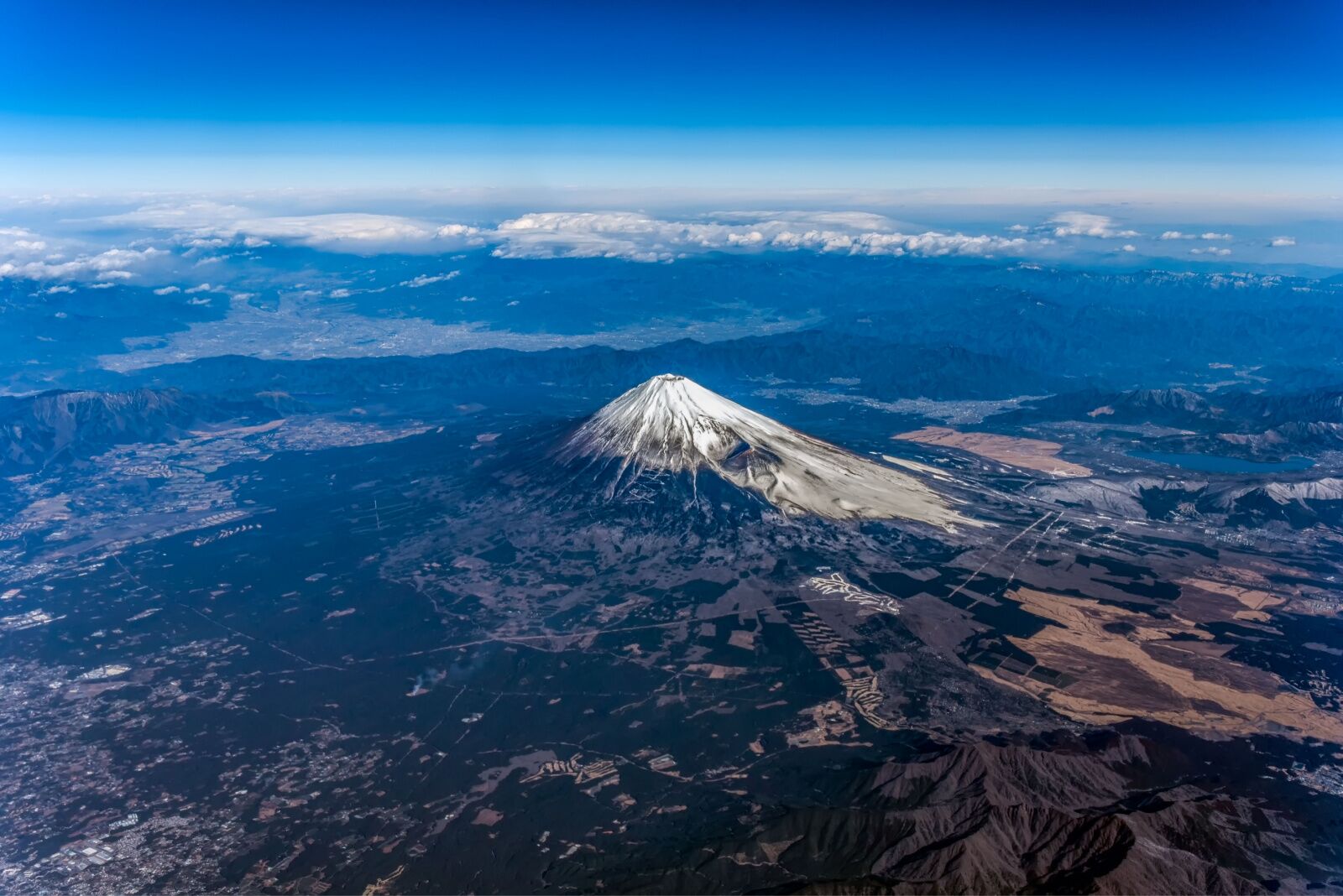
Photo: Hit1912 /Shutterstock
Mount Fuji is indeed a volcano — a stratovolcano, to be specific. It was formed when the Pacific Plate subducted beneath the Philippine Sea Plate. That makes it part of the “Ring of Fire,” a geologically active ring that more or less encircles the Pacific Ocean.
When the plates began to overlap, magma gets pushed to the surface, pushed toward the surface. That gave Mount Fuji its steep, conical shape, which is characteristic of stratovolcanoes. Mount Fuji is still active and has experienced both explosive and effusive eruptions. The most recent documented eruption occurred in 1707 during Japan’s Edo period and was called the Hoei Eruption. It lasted about 2.5 months and deposited ash as far as modern-day Tokyo.
Fortunately, scientists are always monitoring Fuji’s volcanic activity, and there’s plenty of notice (and safety and evacuations measures in place) if the ground starts to move. So pay attention to any of the very rare alerts that may be issued while you’re on the mountain, and you’ll be just fine.
Can you climb Mount Fuji?
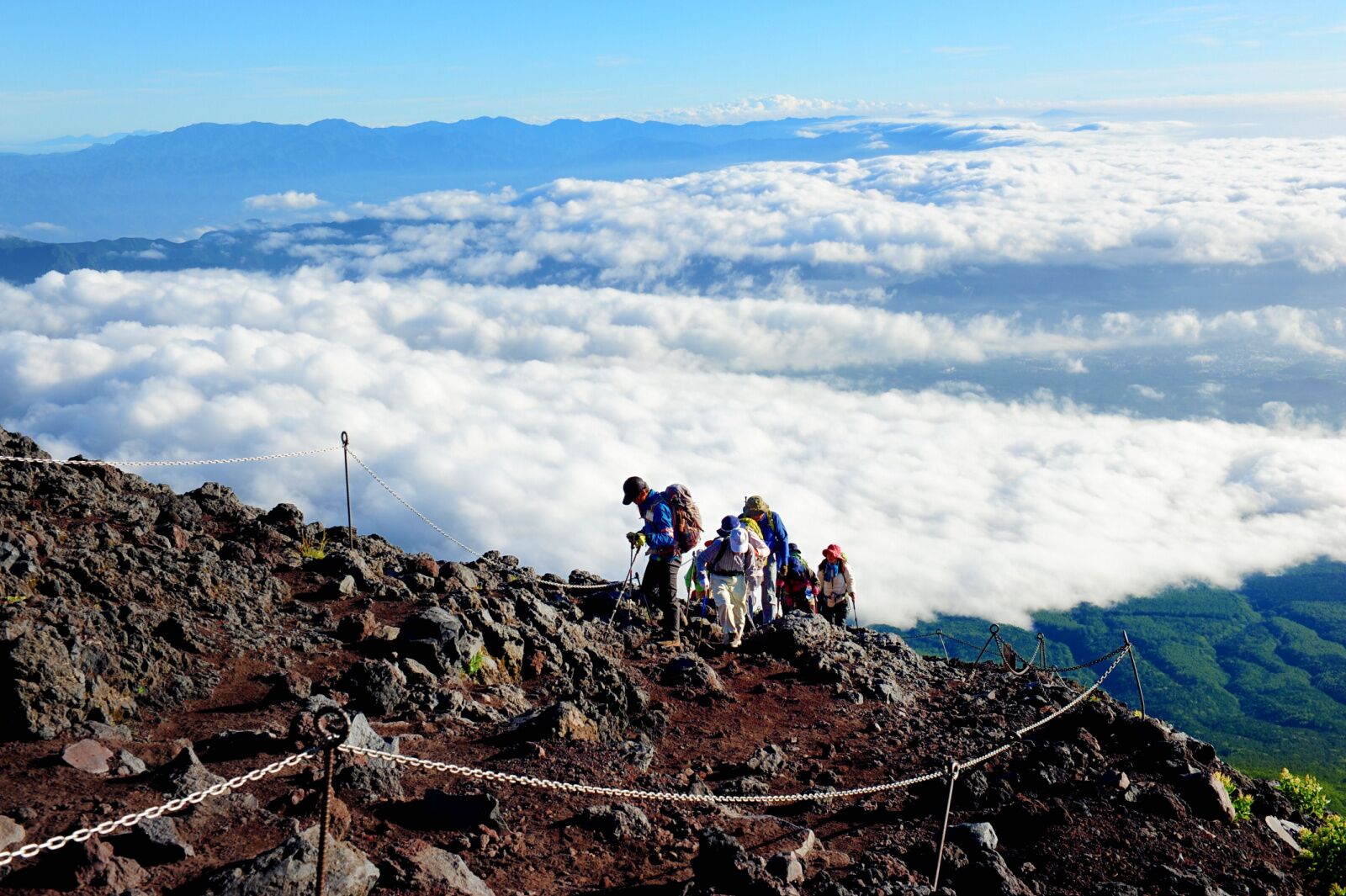
Photo: Jamoo /Shutterstock
Yes, you can climb Mount Fuji, Japan. (People say “climb,” but they mean hike, by the way. Not rock climbing).
New hiking regulations and reservations were introduced in May 2024 . Now, t o hike Mount Fuji, you’ll need to pay a $13 fee to the Yamanashi prefectural government. It’s part of an ongoing bid to combat overtourism around Mount Fuji, which saw more than five million climbers in 2019 (before the COVID-19 pandemic). Other efforts include limiting the number of climbers allowed via the popular Yoshida Trail to 4,000 per day, and not allowing anyone to start hiking between 4 PM and 3 AM in an attempt to reduce overcrowding at the summit around sunrise. There’s an exception if you have a hut reservation, though they still recommend you start before 4 PM.
Reservations aren’t technically required, but it’s recommended to make them in advance if you’re able. Reservations can be made online via the official climbing website and are separate from any on-mountain hut or lodging reservations. If you made a hiking reservation, you’ll be able to move through a speedier line at the gate at the start of the trail near the Fuji Subaru Line 5th Station . If you don’t have a reservation, you can pay when you go through, but the line will probably be longer and slower.
Mount Fuji’s hiking season runs from late June to to mid-September, when the weather is generally warm and snow at higher elevations is mostly melted. There are several routes to the summit ranging from five to about 17 miles long. Of these, the Yoshida Trail is the most accessible and popular. The main hike doesn’t require any mountaineering or technical skills, but it has a lot of elevation gain, so you want to be in relatively good hiking shape. Expect cold temperatures and variable terrain, ranging from muddy to rocky to loose.
You can do it as a day hike or overnight, and can use a guide or go on your own. If you do it as an overnight, book your hut reservations in advance. You can also rent hiking gear, sleeping bags, tents, and whatever else you may need from outfitters like Fuji Mountain Guides or Kobe Mountain Rentals . If you plan a day hike, make sure to train in advance. They’re pretty big hikes and you want to be fit with significant hiking experience if you’re not spending the night.
How to take the Mount Fuji Panoramic Ropeway

Photo: Arunee H /Shutterstock
The Mount Fuji Panormaic Ropeway is also called the Kachi Kachi ropeway. It’s a cable car system north of Mount Fuji in the town of Fujikawaguchiko, next to Lake Kawaguchi. The ropeway ride lasts about five minutes and takes riders to a station near the top of Mount Tenjō. There are great views on the way up, as well as from the top (provided Mount Fuji isn’t shrouded in fog, which can happen fairly often in winter).
There are also a few hiking trails from the summit, all of which are well-marked and signed with information on the environment and local stories about the region. Adult tickets are 900 Yen (about $6) for a round-trip ride, or 1600 Yen (about $11) for a combined tour that also includes a boat tour on the lake. The ropeway is open year-round, though it may close temporarily in case of inclement weather like snow.

A historical Japanese woodcut circa 1798 to 1801. Photo: Library of Congress
Mount Fuji holds a special place in Japanese culture and folklore, and several legends and myths are associated with the iconic mountain. Some Japanese legends say that Mount Fuji was created in an earthquake in a single day. Other legends revolve around Princess Konohanasakuya, the goddess of Mount Fuji and cherry blossoms, who supposedly trapped herself in a fireproof box in the volcano to prove her virtue to her jealous husband. There’s also a legend that Mount Fuji is named after the fire goddess, who would get jealous of any woman who tried to climb the mountain. And in fact, it wasn’t until 1833 that a female hiker reached the summit.
Visitors interested in the history and legends of Mount Fuji, Japan, should visit the Mount Fuji World Heritage Center , opened in 2017.
Visitors who take the ropeway should keep an eye out for the Tenjō Bell, a heart-shaped bell with views of Mount Fuji. Ring it alone, and you’ll have good luck in your life. Ring it with your partner or family for good health and continued happiness. The ropeway also has many statues and signs telling the story of the raccoon dog and the rabbit, a famous story in Japan that supposedly took place on Mount Tenjō.
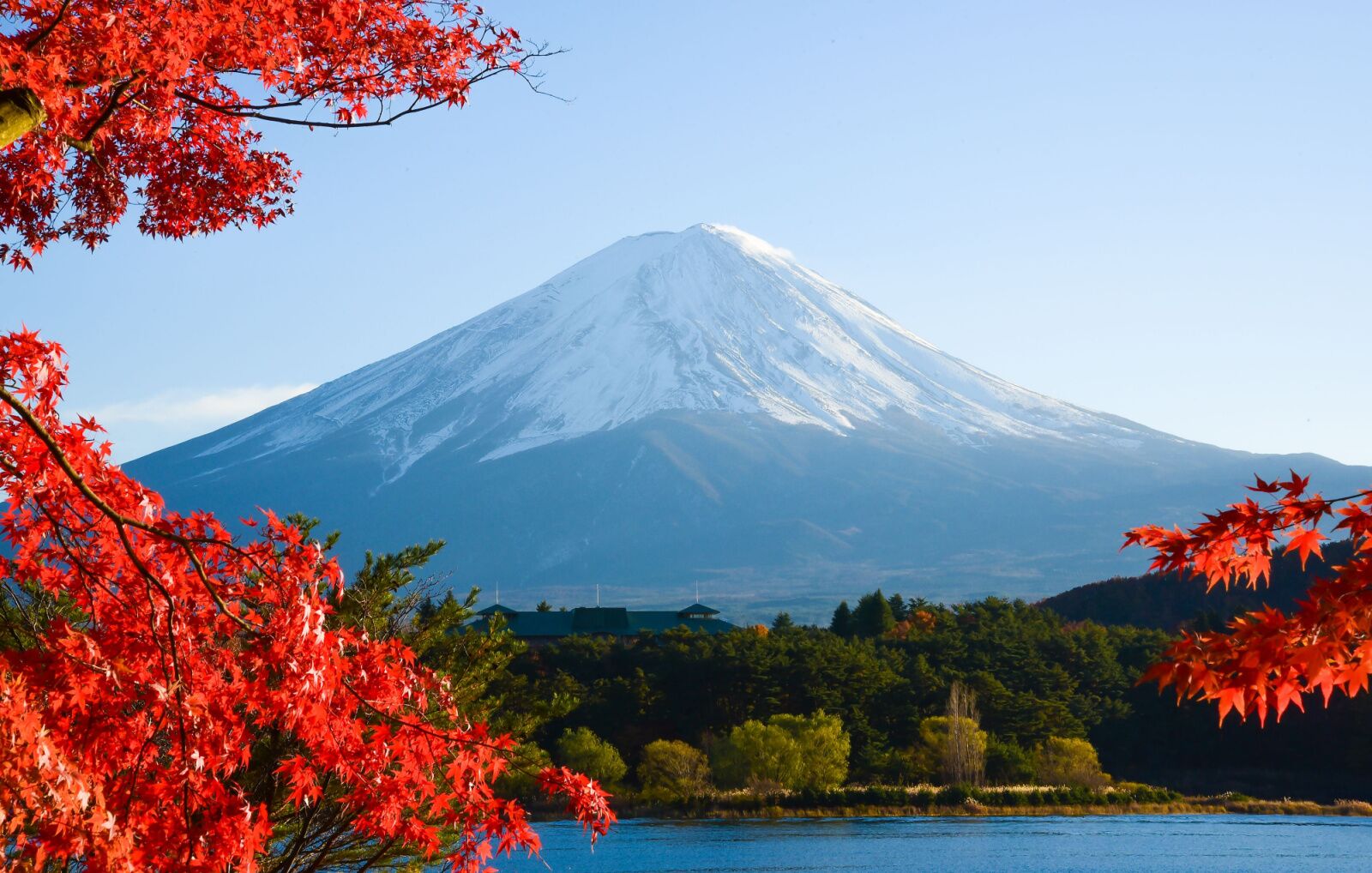
Photo: FocusStalker /Shutterstock
You can visit Mount Fuji and area towns year-round, so the best time to go really just depends on what you want to do.
Mid-March to early April is cherry blossom season : If you want to combine your visit to Mount Fuji with the beauty of these blooming trees, late March to early April is the best time to head to Mount Fuji. Cherry blossom season is the same in Kyoto and Tokyo, though those two towns are likely to be very crowded during that time. The weather can be brisk or quite warm — it’s a bit of a toss-up. Hotels can also be pricey.
Late June to September is climbing season : The official climbing season typically runs from early July to mid-September. The weather is at its warmest and most snow has melted. Keep in mind that this is also the busiest time, so accommodations and trails can be crowded.
September to early November is foliage season : Another visually stunning time to visit Mount Fuji is during the autumn foliage season. The surrounding forests and lakes turn into a beautiful tapestry of reds, oranges, and yellows, creating a striking contrast against the mountain’s silhouette. It’s an ideal time for lower-elevation hikes and photography.
December to February is winter: If you prefer a quieter and more serene experience, visiting Mount Fuji during the winter months can be enchanting. The mountain is often capped with snow, and the surrounding areas are peaceful and quiet, though many restaurants and hotels may be temporarily closed. Expect chilly weather and potentially ice and snow around the ropeway.
Where to stay around Mount Fuji

An onsen (hot spring) at a traditional ryokan near Mount Fuji. Photo: zmkstudio /Shuterstock
There are several towns around Mount Fuji in Japan, all of which provide easy access to both the mountain itself and other activities, trails, and regions in the area. There’s not really one “best” town to stay in around Mount Fuji in Japan. It’s more about what you want to do, what kind of other nearby amenities you want, and how much you’re willing to spend on hotels — the further away you go from Mount Fuji during cherry blossom season, the slightly cheaper the hotel rooms get.
All the towns near Mount Fuji have ryokans (traditional Japanese-style inns), as well as more western-style hotels. Note that it’s fairly common for hotels to not have their own webpages in Japan and instead sell rooms through booking websites or agencies only. So don’t worry if a listing looks “unprofessional” by US standards. You always want to do your due diligence with booking lodging, but direct online booking just isn’t quite as common in Japan as it is in other destinations.
We hope you love the spaces and stays we recommend! Just so you know, Matador may collect a small commission from the links on this page if you decide to book a stay. Listed prices are accurate as of the time of publication.
Oike Hotel, Fujikawaguchiko

Photo: Booking.com
Fujikawaguchiko is the most convenient town to reach as its where all the buses and trains from Tokyo stop. It’s also near Lake Kawaguchiko (the largest of the five lakes around Mount Fuji) and closest to the Mount Fuji Panoramic Ropeway. And Oike Hoitel is a relatively budget-friendly traditional ryokan just five minutes from the train station, with pick up from Kawaguchi station included in reservations. There are indoor and outdoor hot springs, as well as onsen you can reserve for private use. The least expensive rooms are the western-style ones on the lower floors, but if you can swing it, opt for a higher Japanese-style room (with tatami floor mats), as you’re more likely to have views of Mount Fuji.
Fujiyoshida Airbnb
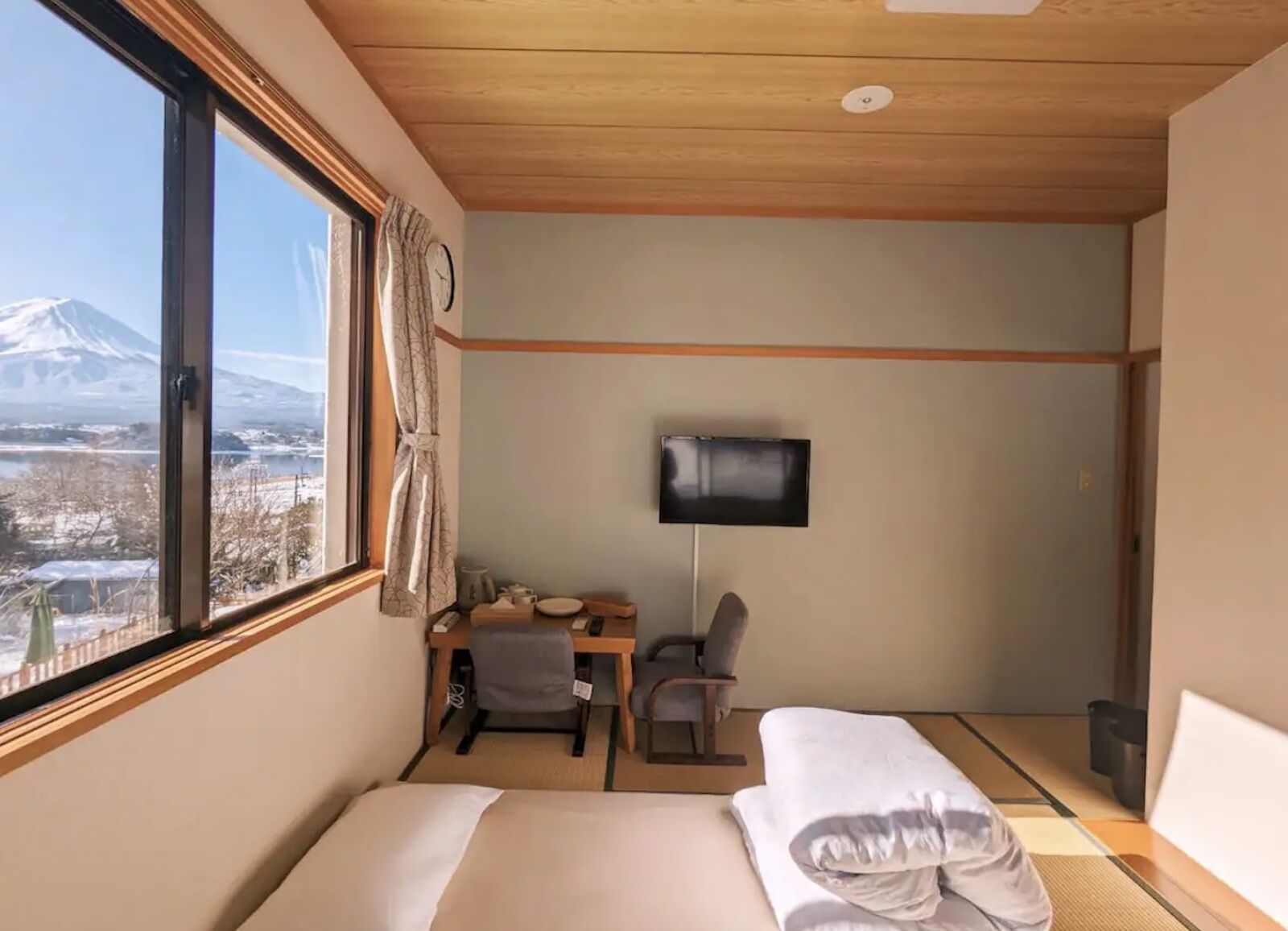
Photo: Airbnb
Fujiyoshida is where you’ll find the 5th Station, which is the starting point for most hikers heading up Mount Fuji. So this may be a good pick for somewhere to stay before or after your hike. It’s a room in a small hotel just about a five-minute walk from cafes and Dashi/Oishi Park. It’s also a very quick walk to Lake Kawaguchi, making it a good pick for summer trips. This particular Airbnb near Mount Fuji, Japan, has an indoor onsen and lots of usable outdoor space.
100-year-old private home
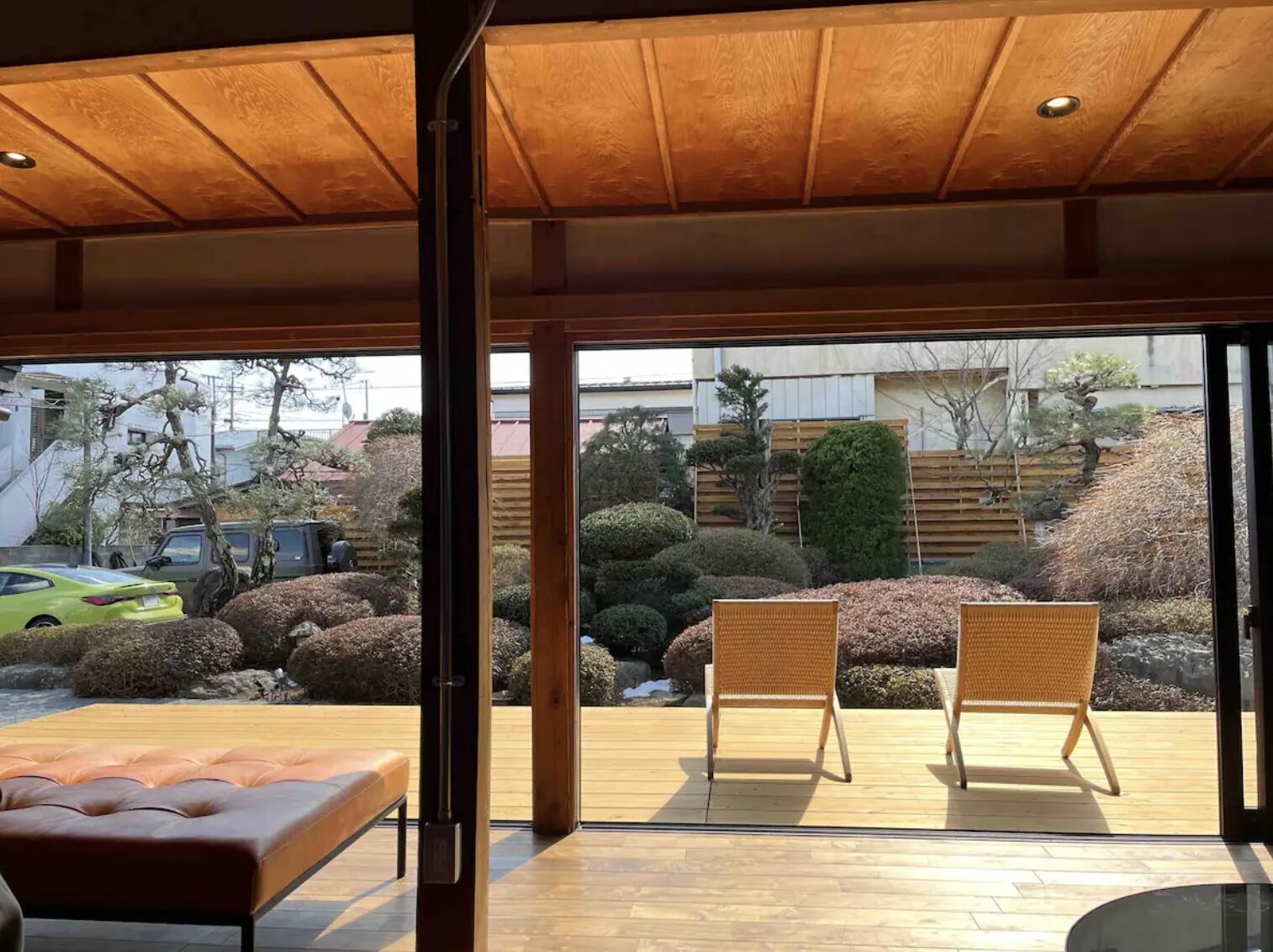
If you’re with a larger group, consider booking this historic renovated home . It’s gorgeous and walkable to Lake Kawaguchiko, with options to add on the use of a Finnish sauna or daily breakfast and dinners. There’s a pretty outdoor space, too. It can sleep up to 13, but with only one bathroom, you may want to keep the guest list a little smaller.
Fuji Time-traveler Tamatebako Airbnb
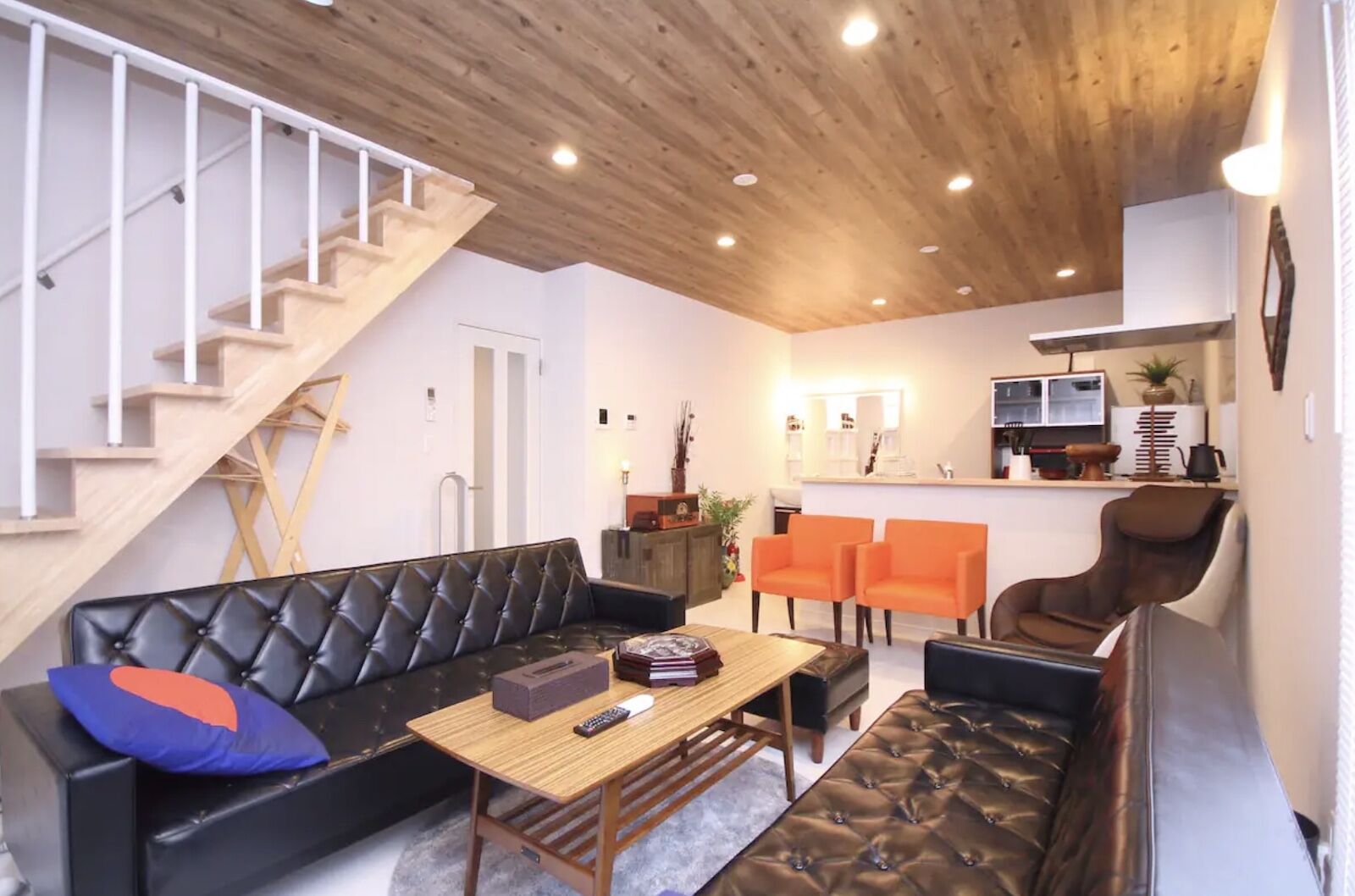
More like this
Trending now, want a photo of japan's most famous mountain authorities set to block the best view, the 10 most popular countries for road trips, and how much gas costs in each, the oldest hotel in the world has been operating since the 700s, to get to one of japan’s coolest waterfalls, you have to take an elevator, why anyone who loves rare bourbon should visit japan, discover matador, adventure travel, train travel, national parks, beaches and islands, ski and snow.
- Media & Industry
- Meetings & Events
- Select Language 简体中文 繁體中文(香港) 繁體中文(臺灣) India (English) Bahasa Indonesia 한국어 ภาษาไทย Tiếng Việt Singapore (English) Philippines (English) Malaysia (English) Australia/New Zealand (English) Français Deutsch Italiano Español United Kingdom (English) Nordic countries(English) Canada (English) Canada (Français) United States (English) Mexico (español) Português العربية Japan(日本語) Global (English)
- India (English)
- Bahasa Indonesia
- Singapore (English)
- Philippines (English)
- Malaysia (English)
- Australia/New Zealand (English)
- United Kingdom (English)
- Nordic countries(English)
- Canada (English)
- Canada (Français)
- United States (English)
- Mexico (español)
- Global (English)
- Fujiyoshida
- Shimonoseki
- Ishigaki Island
- Miyako Island
- Kerama Island
- Tokyo Island
- Koka & Shigaraki
- Hida Takayama
- Ginza, Nihonbashi
- Beppu & Yufuin (Onsen)
- Ginzan Onsen
- Nagasaki Islands

- Kumano Kodo
- Shikoku Karst
- Amami Oshima
- Hachimantai
- Omihachiman
- Aizuwakamatsu

- Diving in Japan
- Skiing in Japan
- Seasonal Flowers in Japan
- Sustainable Outdoors
- Off the Beaten Track in Japan
- Scenic Spots
- World Heritage
- Home Stays & Farm Stays

- Japanese Gardens
- Japanese Crafts
- Temple Stays
- Heritage Stays
- Festivals and Events
- Theater in Japan
- Japanese Tea Ceremony
- Cultural Experiences in Japan
- Culture in Japan

- Local Cuisine Eastern Japan
- Local Cuisine Western Japan
- Local Street Food
- Japan's Local Ekiben
- Japanese Whisky
- Vegetarian and Vegan Guide
- Sushi in Japan Guide
- Japanese Sake Breweries

- Art Museums
- Architecture
- Performing Arts
- Art Festivals
- Japanese Anime and Comics
- Japanese Ceramics
- Local Crafts

- Scenic Night Views
- Natural Wonders
- Theme Parks
- Samurai & Ninja
- Iconic Architecture

- Wellness Travel in Japan
- Japanese Ryokan Guide
- A Guide to Stargazing in Japan
- Relaxation in Japan
- Forest Bathing (Shinrin-yoku)

- Experiences in Japan
- Enjoy my Japan
- National Parks
- Japan's Local Treasures
- Japan Heritage
- Snow Like No Other
- Wonder Around Japan

- Visa Information
- Getting to Japan
- Airport Access
- COVID-19: Practical Information for Traveling to Japan
- Anime Tourism
- Countryside Stays
- Accessible Tourism
- Hokkaido Great Outdoors
- Scenic World Heritage in Tohoku
- Shikoku’s Nature and Traditions
- Southern Kyushu by Rail

- Traveling by Rail
- How to Travel by Train and Bus
- JR Rail Passes
- Scenic Railways
- Renting a Car
- Sustainable Travel in Japan
- Travel Brochures
- Useful Apps
- Online Reservation Sites
- Eco-friendly Accommodation
- Luxury Accommodations
- Traveling With a Disability
- Hands-free Travel
- How to Book a Certified Tour Guide
- Volunteer Guides
- Tourist Information Center

- Japanese Manners
- Spring in Japan
- Summer in Japan
- Autumn in Japan
- Winter in Japan
- Cherry Blossom Forecast
- Autumn Leaves Forecast

- Japan Visitor Hotline
- Travel Insurance in Japan
- Japan Safe Travel Information
- Accessibility in Japan
- Vegetarian Guide
- Muslim Travelers
- Safety Tips

- JAPAN Monthly Web Magazine
- Arts & Cultures
- Nature & Outdoor
- Festivals & Events
- Insider Blog
- Things to do
- Local Guides
- Food & drink
- Traditional
- Hokuriku Shinetsu

My Favorites
${v.desc | trunc(25)}
Planning a Trip to Japan?
Share your travel photos with us by hashtagging your images with #visitjapanjp

2023.03 "Open the Treasure of Japan" in 2023 and Beyond Exploring Japanese Cultural Events that Inspire and Excite
Photo credit: Fukui Prefectural Dinosaur Museum

Experience a digital art wonderland at teamLab Borderless opening at Azabudai Hills
Japan is a hub of innovation and creativity, and 2023 is set to be a fantastic year for experiencing the country's unique cultural offerings. One of the standout events set for 2023 is the completion of the construction of Azabudai Hills, where “MORI Building DIGITAL ART MUSEUM: teamLab Borderless” will open (date to be determined).
International art collective teamLab is renowned for its powerful exhibitions that push the boundaries of art through digital technology. Be transported to a digital art wonderland where art and technology combine to create a truly immersive experience. The new exhibition will be a must-visit destination for art lovers, technology enthusiasts and anyone excited about the world of digital art.
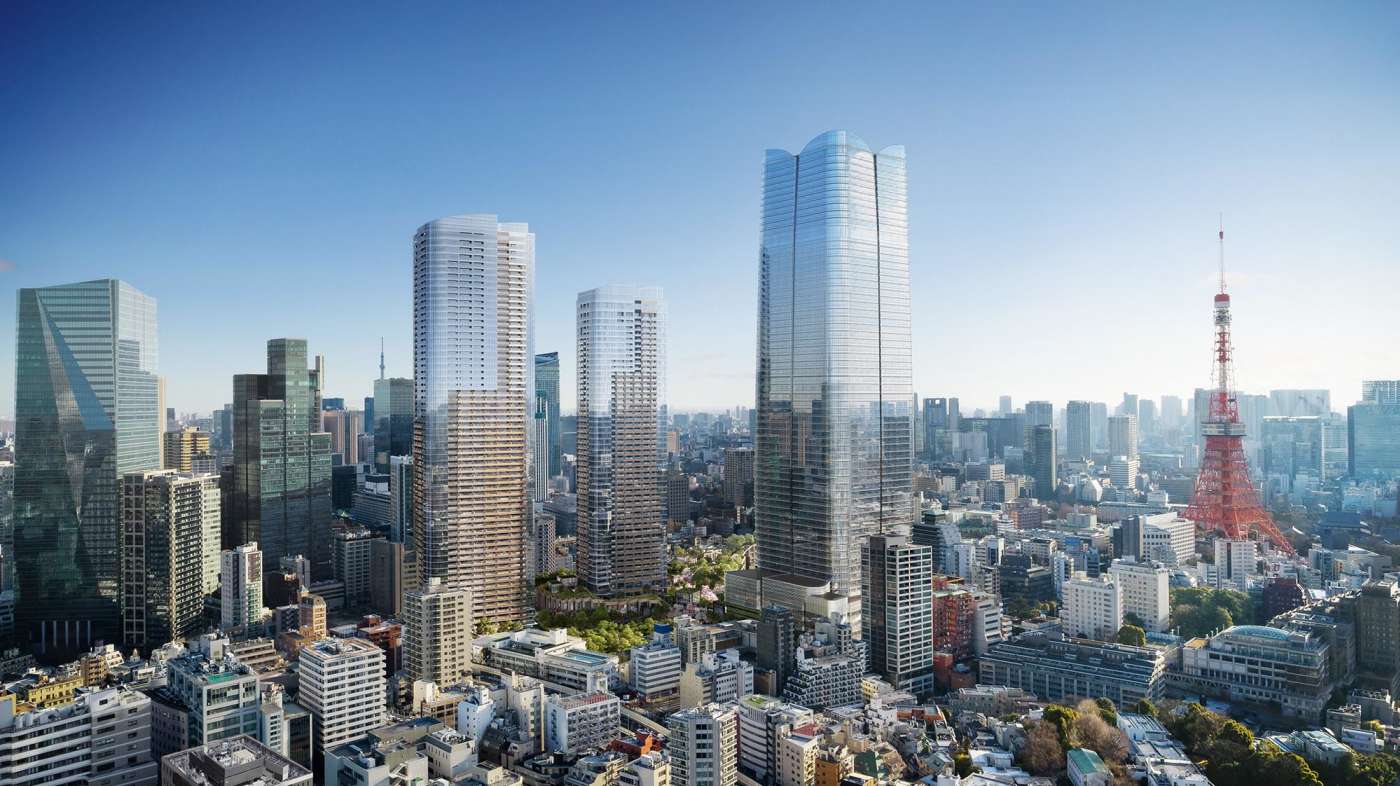
While details regarding the museum are still forthcoming, “DIGITAL ART MUSEUM: teamLab Borderless” in Azabudai Hills will offer visitors a unique glimpse into the future of urban life in the heart of Tokyo .
Marvel at the contemporary art collection of Hiroshima City Museum of Contemporary Art
The Hiroshima City Museum of Contemporary Art is set to reopen on March 18, 2023, offering visitors a chance to experience contemporary art from around the world. It was first opened in 1989 as Japan's first public contemporary art museum on the slopes of Hijiyama, a small mountain featuring stunning views of Hiroshima .
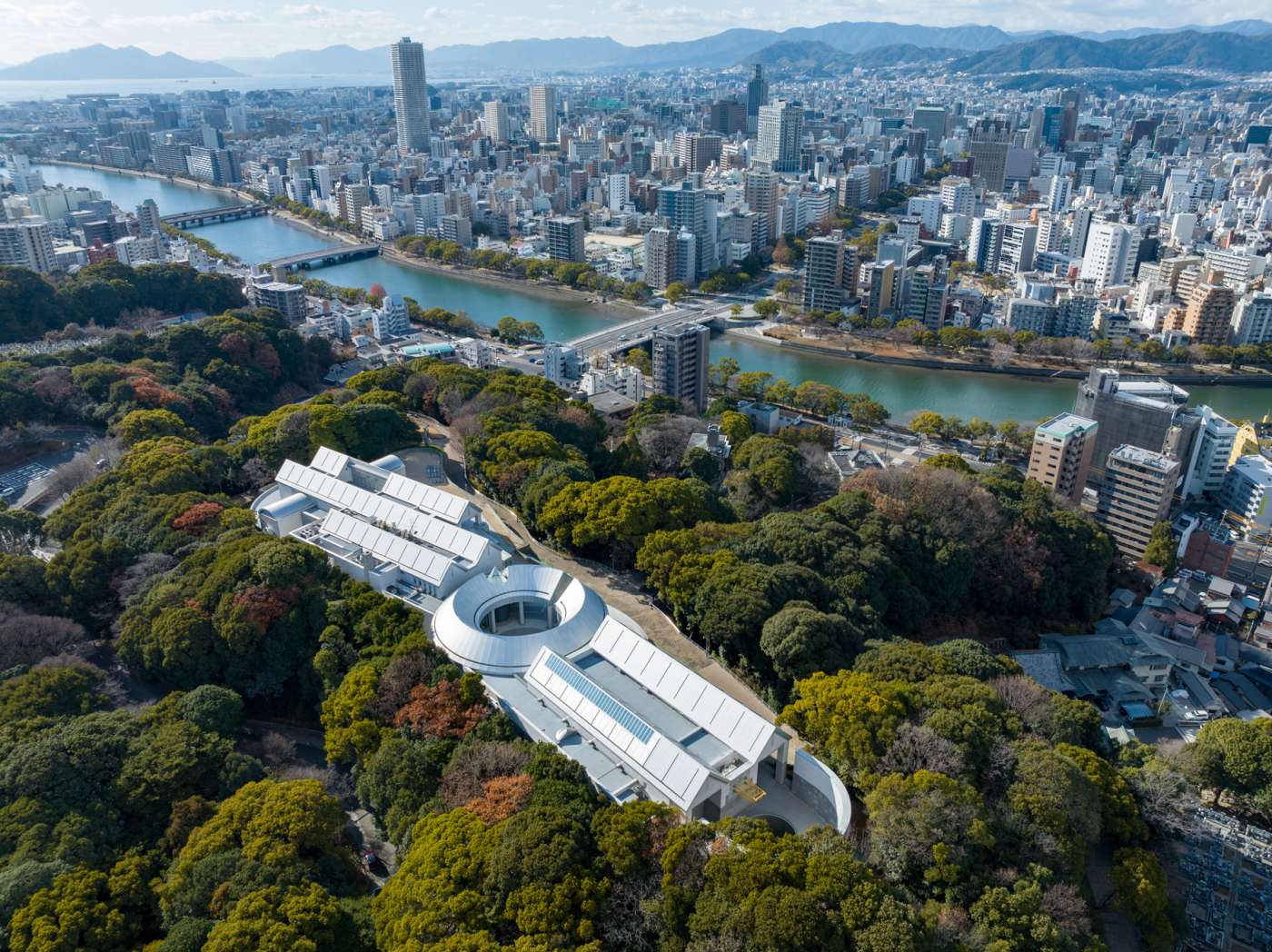
The museum houses approximately 1,700 permanent works, in addition to special exhibitions designed to inspire and engage. The museum also offers a wide range of learning programs, including workshops, lectures and artist talks.
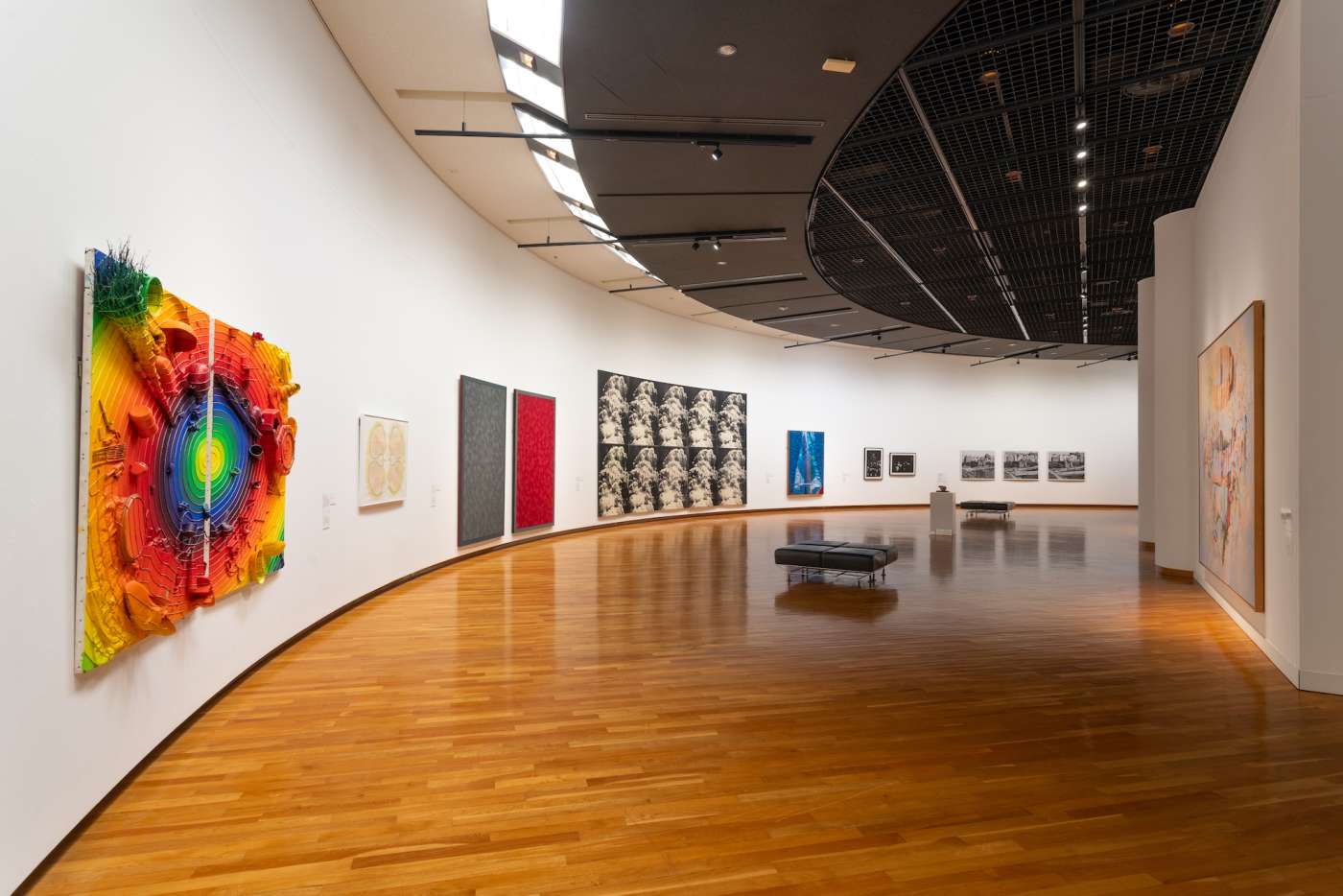
The Hiroshima Prefectural Museum of Contemporary Art is a must-visit destination for anyone interested in contemporary art, and its reopening in 2023 promises to be a major cultural event. Whether you are a seasoned art enthusiast or a newcomer, the museum offers something for everyone.
Discover ancient worlds at the reopening of the Fukui Prefectural Dinosaur Museum
The Fukui Prefectural Dinosaur Museum is all set to reopen in summer 2023. As one of the top dinosaur museums in the world dedicated to dinosaur research and education, it is also the largest of its kind in Japan.

If you're a fan of prehistoric creatures, then the Fukui Prefectural Dinosaur Museum is for you – don’t miss this opportunity to be transported back in time and explore the fascinating history of dinosaurs and ancient life on Earth.
Enter a wizarding world at Warner Bros. Studio Tour Tokyo - The Making of Harry Potter

This will be the largest indoor Harry Potter attraction in the world and visitors can expect to spend around four hours exploring the only Warner Bros. Studio Tour to open in Asia. Building on the success of Warner Bros. Studio Tour London - the Making of Harry Potter which has maintained outstanding visitor ratings since opening in 2012, Warner Bros. Studio Tour Tokyo will feature exclusive sets only available in this location.
Check out JAPAN MOBILITY SHOW 2023
The JAPAN MOBILITY SHOW is a highly anticipated event for anyone interested in the latest advancements in mobility and transportation. From October 26–November 5, 2023, the show will offer experiences with cutting-edge technologies, innovative designs and products, and the newest developments in this field. From electric and autonomous vehicles to cutting-edge transportation systems and sustainable solutions, attendees will have access to a vast array of information, demonstrations and interactive exhibits.
With a range of experts, industry leaders, and tech innovators, the JAPAN MOBILITY SHOW is an excellent opportunity to learn and connect with others who are passionate about mobility.
More excitement for 2023: Unique cultural experiences during the Japan Tourism Agency's "Open the Treasure of Japan" campaign
In addition to these major events, in 2023, the Japan Tourism Agency is excited to offer visitors many more unforgettable experiences in Japan! There’s an incredible lineup of events and activities in store through the "Open the Treasure of Japan" campaign.
Visitors interested in Japanese history, spirituality and wellness will get to see the best of Japanese temples, shrines, and pagodas up close. Cultural history lovers can enjoy special performances of Kabuki and Noh theater, and pop culture fans can enjoy special events related to famous anime.
Nature enthusiasts will have the opportunity to climb the peaks of the Japanese Alps with expert guides, or see the beauty of volcanoes from the skies on a helicopter tour. Visitors with interest in sports and athletics will get to go behind the scenes with famous Japanese athletes and learn all about Japanese martial arts.
Foodies and chefs will delight in visiting special restaurants and taking part in agricultural experience tours, alongside visiting cultural heritage and historic sites. The Japan Tourism Agency has prepared a new website that details the bounty of treasure that awaits visitors to Japan in 2023 and beyond. Please see the page here.
Discover Japan’s Hidden Treasures!
https://www.open-the-treasure-of-japan.jp/?la=en
In 2023, get ready for a trip of a lifetime to Japan, filled with incredible, exciting experiences!
Business hours
Due to measures to prevent the spread of COVID-19, business hours may be subject to change; please check with the venues before visiting.
Information
- "Open the Treasure of Japan" in 2023 and Beyond
Please Choose Your Language
Browse the JNTO site in one of multiple languages
- Tours & Experiences
- Tailor-made Trips
- Bahasa Indonesia
We are happy to see you again!
Continue with
Or use email.
No Account? Create one
Create account
Already have an account? Sign in
Quickly Sign up with
I agree to Japan Travel's Terms of Service and Privacy Policy . Terms of--> and acknowledge that Japan Travel's Privacy--> applies to me.-->
Email reset password link
Please check your inbox and click the link we will send to you.
Search on Japan Travel

LEGO Festival in Marunouchi 2023
The Lego Festival in Marunouchi will include a Lego minifigure rally, Lego building areas, a 2 meter by 2 meter Lego Minecraft diorama on display, and

GAME ON at Miraikan, Odaiba 2016
You can also opt to choose to join an exclusive Minecraft experience, where... building itself, completely and faithfully re-constructed within the Minecraft
Let us know how we can help.
We’re sorry, this site is currently experiencing technical difficulties. Please try again in a few moments. Exception: request blocked

IMAGES
VIDEO
COMMENTS
The official site of Japan National Tourism Organization is your ultimate Japan guide with tourist information for Tokyo, Kyoto, Osaka, Hiroshima, Hokkaido and other top Japan holiday destinations. ... "Open the Treasure of Japan" in 2023 and Beyond. Exploring Expo 2025 in Yumeshima, Osaka and Taro Okamoto's Artistic Legacy.
International tourism will return to Japan in full swing on October 11. If you're planning to visit Japan, here's your travel checklist for 2022/23 trips. ... new rooftop Miyashita Park, and you can stay in the heart of the action when the new Trunk Hotel Yoyogi Park opens in 2023. Expect a rooftop infinity pool with views across the park ...
Official Japan National Tourism Organization, providing free advice and information to Travelers ... Travel Japan - The Official Japan Guide. None U.S.-JAPAN TOURISM YEAR 2024. ... None "Open the Treasure of Japan" in 2023 and Beyond. None The Japan You Never Knew | VICE Guide to Ehime. Ehime is shaping up to be an emerging tourist destination ...
Two times of year I would avoid for a vacation to Japan are: Golden Week in early May - In 2024, Golden Week is from 27 April - 6 May. This is a series of national holidays so many Japanese travel domestically, trains and hotels book up, and popular spots will be extra crowded. New Year - Late December to early January.
JAPAN TOURIST GUIDE 2023: A Comprehensive Travel Guide (Tourist Guides) - Kindle edition by Bessie, Alisha. Download it once and read it on your Kindle device, PC, phones or tablets. Use features like bookmarks, note taking and highlighting while reading JAPAN TOURIST GUIDE 2023: A Comprehensive Travel Guide (Tourist Guides).
Asakusa & Sumida River. Roppongi, Akasaka & Around. Ginza & Tsukiji. Kōrakuen & Akihabara. Ueno & Yanesen. Japan's best sights and local secrets from travel experts you can trust.
Day Two: Arashiyama Walking Itinerary 3. The Arashiyama Bamboo Grove is one of the more popular things to do in Kyoto, and it's located in the Arashiyama District. This itinerary through Kyoto was a bit lighter on the walking since the Bamboo forest isn't too far from the train station.
This item: Japan travel guide 2023: A Comprehensive Guide and tourist information to unleash the Beauty of Japan like a local . $12.85 $ 12. 85. Get it as soon as Wednesday, Apr 24. In Stock. Ships from and sold by Amazon.com. + Japan Travel Guide: Things I Wish I'D Known Before Going to Japan (2024)
Discover the Land of the Rising Sun in a whole new manner with the "Japan Tourist Guide 2023". From understanding the geology of Japan to determining the optimum time to see the nation at its greatest, this comprehensive guide has it all. With chapters on various months and events & festivals, you'll never miss out on anything on your trip.
The Azabudai Hills is a futuristic lifestyle complex by UK design giants Heatherwick opening in 2023 among the well-heeled streets of south-west central Tokyo. Putting green spaces very much in the foreground with an ambitious 'pergola' design, it will feature a new temple, Japan's tallest high-rise building, a sleek shopping arcade designed ...
Japan Travel Guide. Last Updated: April 29, 2024. Japan is one of the most amazing, beautiful, interesting, and friendly countries in the world. From bustling Tokyo and Zen-like Kyoto all the way to laid-back Okinawa and wintery Hokkaido, Japan rocks. It boasts mouthwatering food, majestic temples and shrines, serene gardens, lush national ...
Extended tours in Japan typically cost between 15,000 yen and 30,000 yen per person per day. This includes transportation, admission fees to attractions, lodging, and most meals. Extended tours are excellent value for money when compared to buying individual tickets for transportation and attractions separately.
To give you an idea of how much a bit of research can save you: When I travelled to Japan I purchased a Yamaguchi wide area pass for 13,500 yen. This covered my travel from Hiroshima to Kyoto.From Kyoto I then took a night bus to Tokyo for 6,500 yen. At 20,000 yen this was much cheaper than a 1-week JR pass.
A luxury hotel room in Tokyo this month (Dec. 2022) might set you back $1,200 a night, or more, and staff at these hotels are still getting used to the onslaught of diverse demands again ...
Days 15 & 16: Hiroshima. Day 17: Train to Hokkaido. The train to Hokkaido, Japan's northernmost island home to volcanoes and rugged landscapes, takes 15-16 hours by train. There are sleeper cars available, but you'll have to pay a surcharge (around 9,500 JPY) for a bed.
If you found this video helpful, you're going to love my new travel guide - Beyond The Tourist Trail! An e-book for travellers filled with 120+ hidden gems i...
Travel to Japan is open again for Australians - resuming just in time for the autumn and winter seasons. Japan remains a firm favourite amongst Australian travellers with the country one of the fastest-growing overseas destinations for Australians before the pandemic. ... Michelin also released the 2023 Kyoto Osaka Michelin Guide. 196 ...
The Super Cheap Japan travel guide book is the ultimate budget travel guide to Japan, full of the most useful, up-to-date information for a cheap holiday in Japan. This book includes guides to the major tourist destinations, tips to find cheap accommodation, food, attractions and more, and is a great option for both early trip inspiration and ...
After three years of little traveling, the editorial staff members of japan-guide.com are happy to resume sharing our personal travel highlights of the past year of researching, reporting and traveling across Japan. Below are our travel highlights for the year 2023: View Schauwecker's 2023 Travel Highlights. View Raina's 2023 Travel Highlights.
24 C (75 F) 20 C (68 F) 25%. 30%. 55%. 45%. November is one of the best times to visit Japan, as the weather is relatively dry and mild, and the autumn colors are spectacular in many parts of the country. Travel activity tends to be low except around popular autumn leaf spots.
2023-03-08. Sightseeing Spots in Yokohama Area. Today, I would like to introduce some of the best touri… 2023-03-08. Tokyo Station Area. Today, I would like to share some information about sig… 2023-03-08. Ueno: A Fascinating Destination in Tokyo. ... Japan Travel Guide ...
It's 1400 Yen, or about $7.50. There's also a direct bus that runs between Tokyo and Mount Fuji. Without traffic, it also takes about two hours. Mount Fuji, Japan, is actually fairly easy to reach from Kyoto, as well. The very quickest way is to take the bullet train from Tokyo, then follow the instructions above.
The Hiroshima City Museum of Contemporary Art is set to reopen on March 18, 2023, offering visitors a chance to experience contemporary art from around the world. It was first opened in 1989 as Japan's first public contemporary art museum on the slopes of Hijiyama, a small mountain featuring stunning views of Hiroshima.
Explore articles related to Minecraft on the Japan Travel website. Toggle navigation. Book: ... Guide. News. Blog. Topic. Area. Places. 2 results. LEGO Festival in Marunouchi 2023 Aug 7th - 27th 2023 Past Event. The Lego Festival in Marunouchi will include a Lego minifigure rally, Lego building areas, a 2 meter by 2 ...
If you have concerns,please report at: Feedback and help - TikTok. 679 Likes, TikTok video from Lennielifeandtravel (@lennielifeandtravel): "Discover my up-to-date Japan travel expenses for 13 days in spring 2023. Get useful tips and a budget guide for your trip. Explore Japan on a budget!
November 29, 2023. TOKYO, Japan - On November 29, 2023, the United States and Japan officially launched the "U.S.-Japan Tourism Year" with a signing ceremony at the residence of U.S. Ambassador to Japan Rahm Emanuel. Ambassador Emanuel and Japanese Minister of Land, Infrastructure, Transport, and Tourism Tetsuo Saito signed a Memorandum ...